


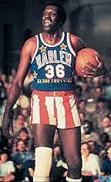

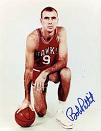




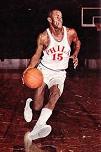





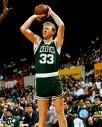
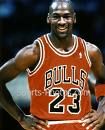


















TLW's Basketballscope™ (Basketball Historyscope) |
By T.L. Winslow (TLW), the Historyscoper™ |
© Copyright by T.L. Winslow. All Rights Reserved. |
Original Pub. Date: July 1, 2012. Last Update: July 31, 2025. |
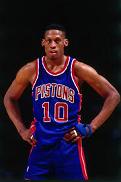









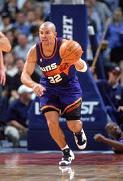

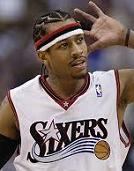
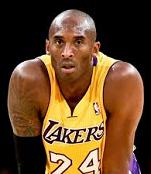

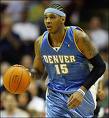

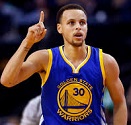
Westerners are not only known as history ignoramuses, but double dumbass history ignoramuses when it comes to basketball history. Since I'm the one-and-only Historyscoper (tm), let me quickly bring you up to speed before you dive into my Master Historyscope.
Basketball is the 5th most popular sport in the world, and rising in popularity, with its stars among the world's highest-paid athletes.

In early Dec. 1891 after his boss Luther Halsey Gulick challenges him to invent a new indoor game for long New England winters, 5'10-1/2" white Canadian-born YMCA physical education teacher James Naismith (1861-1939) of the School for Christian Workers (founded 1885) (Internat. Young Men's Christian Assoc. Training School) (Internat. YMCA College) (Springfield College in 1954) in Springfield, Mass. (founded in 1885) invents the game of Basketball (with 13 rules) (based on the Canadian children's game Duck on a Rock?), using a soccer ball with a simple peach basket (later lost?) as the goal in an effort to create a sport where agility trumps brute force; there are 9 players per side; he introduces it to his 19 students on Dec. 21; the first true game of basketball is played on Jan. 20, 1892, and the Student Unions defeat 23rd St. by a final score of 1-0; a replica of the court is later built in Paris, France by the Paris YMCA Union, becoming the world's oldest basketball court after the one in Springfield burns down; Naismith's student Frank Mahon gives the game its name; on Jan. 15, 1892 the first rules for basketball (by Naismith) are pub. in The Triangle, the Springfield, Mass. YMCA newspaper.

On Mar. 11, 1892 the first public game of Basketball is played in the Springfield, Mass. YMCA in front of a crowd of 200; the student team defeats the faculty team 5-1; "Grand Old Man of Football" Amos Alonzo Stagg (1862-1965) scores the only faculty basket, then later this year becomes head football coach at the U. of Chicago (until 1932), lasting 41 seasons, incl. five undefeated, winning 314 games as a coach; he goes on to introduce the huddle, man-in-motion, and the end-around play, and invent the batting cage in baseball.

In winter 1892 Lithuanian-born Senda Berenson Abbott (nee Valvrojenski) (1868-1954) of Smith College invents Women's Basketball, with modified rules to keep women from "nervous fatigue", with players assigned zones to minimize movement, and a smaller basketball; on Mar. 22, 1893 the first women's basketball game is played at Smith College; men are not allowed to watch; in 1896 the first intercollegiate women's basketball game is played by Stanford U. and UCB; in 1976 women's basketball becomes an official sport of the Olympic Games.
On Feb. 7, 1893 Vanderbilt U. plays the Nashville, Tenn. YMCA, becoming the first college to play a non-college opponent in basketball. On Apr. 8, 1893 Geneva College defeats New Brighton YMCA in basketball by 3-0 in Beaver Falls, Penn.
In 1893 the Narragansett Machine Co. begins selling iron basketball baskets with a net and chain, replacing peach baskets.
In 1893 the first European basketball match, organized by YMCA man Mel Rideout is played in Montmarte, Paris; the YMCA sends basketball promoters worldwide, incl. Bob Gailey (Tientsin, China), Duncan Patton (India), Genzabaro Ishikawa (Japan), and C. Hareek (Persia).


In 1893 after visiting the U.S., Swedish-born Martina Sofia Helena Bergman-Osterberg (Bergman-Österberg) (1849-1915) of Hampstead, London invents Netball for women, which is played outdoors on grass, with baskets replaced by rings with nets, with players limited to zones on the court and no dribbling allowed to allow for female modesty; it goes on to spread throughout the British Empire; in 1897 her student Mary Tait invents the Gymslip (Pinafore Dress) (Jumper Dress) sleeveless tunic with pleated skirt for women to replace ground-length skirts and mutton-arm blouses.

In 1894 after James Naismith asks Albert Goodwill Spalding (1850-1915) of Spalding Sports of Chicago, Ill. (founded 1876) to do it, they produce their first basketballs, which go on to become the official balls of the NBA until 1977, when Rawlings of St. Louis, Mo. (founded 1887) takes over.
On Feb. 9, 1895 the first-ever intercollegiate basketball game sees Minnesota A&M defeat Hamline U. by 9-3, launching College Basketball.

On Feb. 9, 1895 after meeting James Naismith in 1892, Lockport, N.Y.-born William George Morgan (1870-1942) invents the game of Volleyball in a YMCA in Holyoke, Mass. (10 mi. from Springfield) for those who find basketball too strenuous, calling it Mintonette, played by hitting a basketball over a rope; Alfred Halstead gives it the name volley ball.
In 1895 the value of a field goal in basketball is changed from 3 to 2 points; the free throw value is changed from 3 to 1 point; the free throw line in men's basketball is moved from 20 ft. to 15 ft.; backboards made of wood are introduced to eliminate interference from the balcony.
On Jan. 18, 1896 the first intercollegiate basketball game with five players per side sees the U. of Chicago (coach Amos Alonzo Stagg) defeat the U. of Iowa in Iowa City by 15-12.
On Nov. 7, 1896 the first known prof. basketball game is played at the Masonic Temple in Trenton, N.J. in the 3rd floor banquet hall; the Trenton YMCA defeats the Brooklyn YMCA by 15-1; each player gets $15 except Fred Cooper, who gets $16; after chicken wire is used to protect spectators, sports writers begin calling players "cagers".
In 1896 the Big Ten Conference (B1G) (originally the Western Conference) is founded by seven teams in the NCAA's Division 1 incl. the U. of Chicago, U. of Ill., U. of Mich., U. of Minn., Northwestern U., Purdue U., and the U. of Wisc., expanding to 14 colleges and 28 sports (14 men's, 14 women's).
In 1897 the Yale U. basketball team introduces passing-to-oneself AKA dribbling; the number of players per team is fixed at five.
In 1898 the Nat. Basketball League (NBL) is formed in Philadelphia, Penn.; on Dec. 1 the first game sees the Trenton Nationals defeat the Hancock Athletic Assoc. by 21-19 in Textile Hall in Philadelphia before 900 fans; the first champion is the Trenton Nationals, followed by the New York Wanderers, Bristol Pile Drivers, and Camden Electrics; in Jan. 1904 (five seasons) after expanding to seven teams it folds, with the Camden Electrics in first place when it disbands.
In 1898 the overhead dribble, double dribble, and 2-handed dribble are banned in basketball.
In 1901 the Eastern Intercollegiate Basketball League (EIBL) is founded for men's college basketball by Columbia U., Cornell U., Harvard U., Princeton U., and Yale U., growing to eight Ivy League members incl. the U. of Penn. (1903), Dartmouth College (1911), and Brown U. (1953); in 1901 Yale U. goes 10-4 to win the first nat. college championship; in 1902 the U. of Minn. goes 11-0 to become the first undefeated team in basketball; in 1955 the EIBL merges with the new Ivy League.
In 1903 the U. of Ky. Wildcats men's basketball team is founded, with head coach #1 W.W.H. Mustaine; they go 1-2 for their first season after defeating Lexington YMCA and losing to Transylvania U.; they go on to become the winningest NCAA Div. 1 basketball program in NCAA history, with retired jerseys incl. Cliff Hagen (#6), Pat Riley (#42), Dan Issel (#44), and Bill Spivey (#77).
In 1903 a new rule is adopted in basketball prohibiting a player who is dribbling from shooting the ball at a basket; dropped in 1915.
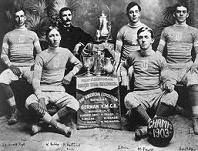
In 1904 the Buffalo Germans (founded at a YMCA in 1895), coached by Dr. Fred Burkhardt win the AAU nat. basketball tournament, which serves as a demonstration sport at the 1904 St. Louis Olympics; in 1907-10 they have a 111-game winning streak; they disband in 1925 with a 792-86 record.
In winter 1904 after learning the game at Harvard U., the Black Fives all-black amateur basketball team is founded in Washington, D.C. by Edwin Henderson ("Grandfather of Black Basketball"), making basketball popular among blacks in the region, who had considered it a sissy game.
In 1904 after the U.S. Rubber Co. produces the first rubber-soled shoes in the U.S. in 1892, Spalding Sports Co. markets the first suction-sole shoes, becoming the first Basketball Sneakers in 1907.
On Dec. 28, 1905 after two White House conferences convened by Pres. Theodore Roosevelt to "encourage reforms" in college football to prevent injuries and deaths, followed by a meeting of 13 U.S. colleges and univs. organized by NYU chancellor Henry MacCracken, 62 higher-education institutions form the Intercollegiate Athletic Assoc. of the U.S. (IAAUS), which is officially established next Mar. 31, and changes its name to the Nat. Collegiate Athletic Assoc. (NCAA) in 1910; in 1921 it conducts the first NCAA nat. championship, the Nat. Collegiate Track and Field Championships; in 1939 it conducts its first basketball championship.
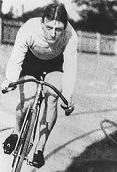
In 1905 the Columbia U. Lions men's basketball team is named the first nat. college basketball champions by the Helms Athletic Foundation after defeating Minnesota U. (27-15) and Wisconsin U. (21-15) and finishing with a 19-1 record; 5'9" Harold A. "Harry" Fisher (1882-1967) and team captain (Olympic cyclist) Marcus Latimer Hurley (1883-1941) are named to the first-ever 1905 College Basketball All-Am. Team.

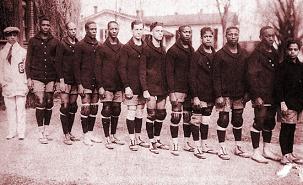
In 1906 the amateur Smart Set Athletic Club in Brooklyn, N.Y. (AKA the Grave Diggers), and the St. Christopher (St. C's) Club in Harlem, N.Y., which draws its members from St. Philip's Episcopal Church are founded, becoming the first all-black basketball teams, launching the Black Fives Era; in 1907 the all-black Olympian Athletic League is founded by the Smart Set Athletic Club, Marathon Athletic Club, Alpha Physical Culture Club, and Jersey City Colored YMCA, making basketball popular in the New York City area; the St. C's become known as the Red and Black Machine for their scientific and methodical play; in 1908 the Smart Set Athletic Club wins the first Colored Basketball World's Championship, coined by Lester Walton of The New York Age, and awarded by African-Am. newspaper sports writers; St. Christopher wins four by the end of WWI; the last one (for 1924-5) goes to the New York Renaissance Big Five; the 1918-19 St. C's lineup incl. Rutgers U. football star Paul Leroy Robeson (1898-1976) (forward), Clarence Reginald "Fats" Jenkins (1898-1968) (forward) ("the fastest man in basketball"), James "Pappy" Ricks, and Hampton Inst. star center Charles Bradford; St. Philip's pastor Rev. Hutchens Chew Bishop uses his light complexion to trick white racist residents into selling him a church bldg. on 134th St. along with a large tract of apt. bldgs. on 135th St., allowing him to move his flock in and create Black Harlem.

In 1907 Forrest Clare "Phog" Allen (1885-1974) becomes head basketball coach at the U. of Kan. (until 1909, then 1919-56), going on to win 24 conference and three nat. titles and become known as "the Father of Basketball Coaching".
On Dec. 18, 1908 the first inter-city African-Am. basketball team competition sees the Smart Set Athletic Club of Brooklyn defeat the Crescent Athletic Club in Washington, D.C.
In 1908 the first basketball player is ejected from a game after five personal fouls.
In 1909 the first internat. basketball game is played in St. Petersburg, Russia; Mayak St. Petersburg defeats a U.S. YMCA team.
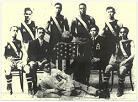
On Oct. 13, 1910 despite condemnation from the Negro press as "sinful", the New York All-Stars, the first all-black pay-for-play basketball team is formed by former St. Christopher Club mgr. Major Aloysius Hart, with the soundbyte: "That this game has taken a firm hold of our people has been demonstrated beyond a doubt"; the team attracts top players from the New York City area incl. the St. Christopher Club.

In 1910 all-black Howard U. founds its first varsity basketball team by Edwin Henderson after his 12th St. Colored YMCA wins the Colored Basketball World's Championship earlier in the year, going on to win the 1911 championship with a team mainly recruited from the 12th St. team, incl. capt. Henry Nixon, former Amherst Walter Camp All-Am. Amherst U. football halfback Edward B. Gray, star center Charles Gilmore, brothers Maurice Curtis and Arthur Curtis, and former Jersey City and Smart Set star (best African-Am. basketball player in 1910) Hudson "Huddy" Oliver (-1955).
In 1914 the opponent of the last player to touch the basketball before it goes out of bounds is awarded the throw-in, preventing the rough contact when the first player over the line to touch it gets possession.

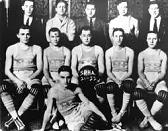
In 1917 the all-Jewish Philadelphia Sphas (South Philadelphia Hebrew Assoc.) basketball team is founded by 5'8" Ukrainian-born "Mr. Basketball" Edward (Isadore) "Eddie" "the Mogul" Gottlieb (1898-1979), starting out as a top barnstorming team ($2 a ticket), joining the Eastern League, then going on to dominate the ABL with seven titles in 1933-46.
In 1917 Glass backboards are introduced in basketball by Indiana U., manufactured by the Nurre Mirror Plate Co. in Bloomington, Ind.; in 1916 they are temporarily banned in favor of white painted backboards.

In 1917 Converse Rubber Co. of Malden, Mass. (founded 1908) begins marketing the Converse All-Star basketball shoe with rubber sole and canvas upper; in 1921 they hire Charles Hollis "Chuck" Taylor (1901-69) to hold basketball clinics in U.S. high schools and push the shoes, making them the #1 seller of all time (80% of the market in 1966) after suggesting improvements; in 1922 he begins the Converse Basketball Yearbook; in 1932 they are renamed Chuck Taylor All-Stars; in 1935 he invents the stitchless basketball; in 1947 the co. begins producing white high-tops.
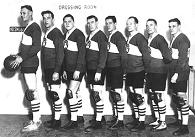
In 1918 the Original Celtics all-white basketball team is formed by James Furey from the New York Celtics (formed in 1914 from West Side teenie players, then disbanded during WWI), becoming the first prof. basketball team with exclusive player contracts, going on to become a touring squad that travels up to 150K mi. a year for up to 205 games, popularizing basketball, compiling a 193-11-1 record in 1922-3, inventing post play, zone defense, and switching man-to-man defense; in 1926 they join they are shanghaied into joining the Am. Basketball League, going on to win the title in 1926 and 1927 and dominate it so completely that they are forced to send players to other teams, backfiring with lowered attendance, causing the ABL to fold after the 1931 season; the Original Celtics return to barnstorming through 1941.


On June 22-July 6, 1919 the Inter-Allied Games are held in the new Pershing Stadium near the Bois de Vincennes outside Paris, France; participation is limited to 1.5K WWI Allied military personnel from 18 nations, and features 19 sports incl. Am. football, soccer, baseball, basketball, boxing, cross-country running, fencing, golf, hand-grenade throwing, rugby, shooting, swimming, tennis, tug of war, and water polo; the basketball competition is held in Joinville-le-Pont, featuring a U.S. team led by Max "Marty" Friedman (1889-1986) (who organized a 600-team tournament in France which led to the games) coming in #1, followed by Italy and France, boosting popularity in those countries; the Italian team wears a white shirt with a House of Savoy shield, and incl. players Arrigo Muggiani, Marco Muggiani, and Giuseppe Sessa.
In 1921 basket ball is officially spelled basketball.
In 1921 the Federazione Italiana Pallacanestro (Italian Basketball Federation) is founded; in 1932 it joins FIBA.
On Nov. 11, 1922 the Commonwealth Five all-black basketball team, founded by boxing promoters Ed McMahon and Jess McMahon makes its debut at the Commonwealth Sporting Club and Casino at 135th St. and Madison Ave. in Harlem, N.Y., defeating the all-white Monarch Elks Five by 25-13, becoming the first all-black pro basketball team, going on win the Colored Basketball World Championship in 1924.


On Feb. 13, 1923 taking his cue from the Commonwealth Big Five, the New York Renaissance (Rens) (Big Five), the first black-owned prof. African-Am. basketball team is founded in Harlem, N.Y. by Saint Kitts, West Indies-born Robert L. "Bob" Douglas (1882-1979), who becomes known as "the Father of Black Professional Basketball"; on Nov. 3 they play their first game, against an all-white team; on Dec. 20, 1925 they defeat the Original Celtics for the world prof. basketball title; in 1929 6'4" center Charles "Tarzan" Cooper (1907-80) joins (until 1941), becoming basketball's first Wilt Chamberlain, with Original Celtics center Joe Lapchick calling him the greatest center who ever played; in 1932-33 they go 120-8, incl. a record 88 consecutive wins; in 1939 they defeat the Oshkosh All-Stars by 34-25 in Chicago, Ill. to win the world prof. basketball title; on Feb. 5, 1972 Douglas becomes/a> the first African-Am. elected to the Basketball Hall of Fame.
In 1923 Passaic H.S. in N.J. sets a nat. h.s. basketball record with 159 consecutive Vs.
In 1923 a new rule in basketball requires the player who was fouled to make his own free throws instead of a designated free-thrower.
In 1924 Marie Boyd of Lonaconing Central H.S. in Md. scores a nat. girl h.s. record of 156 points in 162-3 V over Cumberland Ursuline Academy of Md.
In 1925 the Am. Basketball League (ABL) is formed by NFL pres. Joseph Carr, Chicago Bears owner George Halas, and future Washington Redskins owner George Preston Marshall, eliminating the double dribble to encourage top college players to join; it folds after the 1931 season.

On Jan. 7, 1927 the Harlem Globetrotters (originally Savoy Big Five) basketball team of South Chicago, Ill., founded by London-born Jewish future hall-of-fame 5'5" (5'3"?) basketball player Abe M. Saperstein (1902-66) plays its first game in the Savoy Ballroom; he uses Harlem as a euphemism for Afro-Am.; they become known for their red-white-blue uniforms and clowning tactics along with cool tricks, always playing a chump team that they handily defeat in endless tours.
In 1929 the Collegiate Joint Rules Committee outlaws dribbling under the influence of Wisconsin's Walter Meanwell, then immediately reverses its decision under the influence of CCNY's Nat Holman, publishing Official Basketball Rules As Adopted by the Joint Basketball Rules Committee Composed of Committees Representing the National Collegiate Athletic Association, Young Men's Christian Association, Amateur Athletic Union, National Federation of State High School Associations et al.
In 1930 the Dixie Conference is formed by the 9-member Southern Intercollegiate Athletic Assoc. (SIAA), who all resign in 1932; the first conference championship (1931) is won by the U. of Chattanooga, who also wins the last championship in 1941, when it dissolves because of WWII; in 1948 it is relaunched, emphasizing purely amateur rules for athletes; the first conference championship (1948) is won by Florida State U.; the last (1954) is won by Millsaps College; in 1963 the Dixie Intercollegiate Athletic Conference is founded as a member of the NAIA, switching in 1973 to NCAA Div. 3; on June 30, 2003 it is renamed the USA South Athletic Conference; in 1965 the U. of N.C. Charlotte (49ers) joins, winning the conference title in 1969-70.
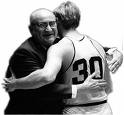
In 1930 Adolph Frederick Rupp (1901-77) becomes head basketball coach for the U. of Ky. (until 1972), retiring with 876 wins and a 0.822 winning percentage.
In 1930 the Japanese Basketball Assoc. (JBA) is founded in Tokyo as the governing body of basketball in Japan, joining FIBA - the shorty leagues?
In 1930 all rope and chicken wire around the edges of a basketball court are banned, ending the caged era.
In 1931 a basketball tournament in Peking, China attracts 70K fans over three nights.
On June 18, 1932 the Federation Internationale de Basketball Amateur (FIBA) is founded in Mies, Switzerland to govern internat. competition, with James Naismith as honorary pres. #1 (until 1939), and Leon Bouffard as official pres. #1 (until 1948), growing to five zones (commissions) with 213 nat. federations; in 1950 they found the FIBA Basketball World Championship (Cup), held every four years to compete for the Naismith Trophy.
In 1933 a new rule is introduced into basketball requring teams to advance the ball over the half-court line in 10 sec.
On Dec. 29, 1934 the first college basketball doubleheader is played at Madison Square Garden in New York City in front of 16K fans; New York U. defeats Notre Dame by 25-18, and Westminster U. defeats St. John's U. by 37-33.

In Nov. 1935 6'2" 185 lb. white Stanford U. basketball player Angelo "Hank" Luisetti (1916-2002) invents the 1-handed jump shot at a campus gym and becomes the first player to use it in a college game on Dec. 30, 1936; on in 1937 he averages 20 points per game; on Jan. 1, 1938 he becomes the first player to score 50 points in a game against Duquesne.


















The greatest chance to stop WWII with the fellowship of sports is in the hands of a black, two Jews, and a mental cripple at the Big 1936 Aryan Olympics? On Aug. 1-16, 1936 Nazi Germany, led by Adolf Hitler (1889-1945) hosts the XI (11th) Summer Olympic Games in Berlin, after the first-ever torch relay from Olympia, Greece, devised by Nazi filmmaker Leni Riefenstahl, who films the dramatic lighting of the flame in Olympic Stadium, the final torchbearer being graceful certified blonde-blue Aryan runner Fritz Schilgen (1906-2005), who does not compete (2nd time the Olympic flame is used); 3,963 athletes (incl. 331 women) from 49 nations participate in 129 events in 19 sports; the first televised Olympics, beamed to TV sets in Berlin and Potsdam, and later used by aliens from outer space as a signal that earthlings are ready for Carl Sagan's Contact?; basketball and handball debut as outdoor sports (handball doesn't appear again until 1972); on Aug. 1-16 the basketball tournament sees the U.S. defeat Canada by 19-8 to win the gold medal; French and Canadian athletes give an Olympic salute at the opening ceremony which looks dangerously close to the Nazi salute?; the U.S. almost boycotts the Olympics until a backroom power play, with Ernest Lee Jahnke being expelled from the IOC, and pro-Nazi USOC pres. (since 1929) Avery Brundage (1887-1975) put in his place, maneuvering the USOC into a close vote to send a team, which most Jewish athletes boycott, while blacks welcome the propaganda chance (showing the cracks in the U.S. Jewish-black alliance, or is it something about every Jew and Aryan being shorter down there and the black bucks hoping to get lucky with the German girls, er, forget it?) (Brundage utters the soundbyte this year: "I am fed up to the ears with women as track and field competitors... her charms sink to something less than zero. As swimmers and divers, girls are as beautiful and adroit as they are ineffective and unpleasing on the track") (after the Olympics, his construction co. gets a contract to build the German embassy in the U.S., and after he dies he is revealed to have been the a-hole who got American Injun Jim Thorpe's medals taken away for playing semi-pro ball); Hitler orders the Berlin police to arrest all gypsies before the games and keep them in a special camp, but exempts foreign visitors from Nazi anti-gay laws?; signs warning shoppers about Jewish-owned shops are taken down, but Hitler initially has signs mounted over toilets reading "Dogs and Jews not allowed", then backs down and removes them after Belgian IOC pres. (since 1925) Count Henri de Baillet-Latour (1876-1942) (who went on record as saying that women shouldn't take part in the Olympics) faces him down; only pure Aryan athletes are permitted by Hitler to compete for Germany; on Aug. 7-14 the basketball tournament (played on lawn tennis courts) sees North Am. teams win all the medals (U.S. gold, Canada silver, Mexico bronze), all awarded by James Naismith; most athletes (incl. from the U.S., incl. Jesse Owens) wear track shoes made by ardent Nazi brothers Adolf "Adi" Dassler (1900-78) and Rudolf Dassler (1898-1974) of Herzogenaurach, Bavaria (12 mi. from Nuremberg); too bad, after the war, Adi rats Rudolf out as a member of the SS, causing them to split, after which in 1948 Rudolf founds Puma nearby across the Aurach River, and Adi renames his co. Adidas (run like a Nazi?); (the solution to world peace was on their feet all the time?); the well-heeled lily-white Aryan German athletes, while winning the most medals as a group and proving Aryan superiority to the Aryans are upstaged in the non-German world by black U.S. athlete (former Ohio State U. star) (son of a sharecropper and grandson of slaves) Jesse Owens (1913-80), "the Ebony Express", who becomes the 1st U.S. and 2nd athlete ever to win three individual Olympic golds, in the 100m (10.3 sec.) (Aug. 3), long jump (26 ft. 5-5/16 in.) (Aug. 4), and 200m (20.7 sec.) (Aug. 5); after Avery Brundage kisses Nazi butt by pulling Jews Martin "Marty" Glickman (1917-2001) and Sam Stoller (the only two Jews on the U.S. Olympic team) out of the 4x100m relay, they put in Owens and yet-another-black-athlete Ralph Harold Metcalfe (1910-78) (world's fastest human from 1932-4, who placed 2nd to Owens in the 200m), and on Aug. 9 the U.S. team wins by 15 yards, setting a record of 39.8 sec., which lasts 20 years (until 1956); Hitler allegedly snubs "black nigger ape" Owens, but actually doesn't, as he decided to skip all medal presentations after the first day, when he did snub two U.S. blacks, high jumpers Cornelius Cooper "Corny" Johnson (1913-46), (who won the first U.S. gold) and David Donald "Dave" Albritton (1913-94); not that Owens is in love with the racist U.S. so much either, saying "Hitler didn't snub me, it was FDR who snubbed me. The President didn't even send me a telegram"; black athlete Archibald Franklin "Archie" Archie Williams (1915-93) wins another gold for the U.S. in the 400m; blonde model Aryan German long jumper Carl Ludwig "Luz" Long (1913-43) does an un-PC thing by giving Owens advice that keeps him from elimination in the preliminary, then when Owens wins the gold, running out to congratulate him, clutching his right hand with his left and hoisting their arms into the air while facing toward Hitler, becoming Owen's defining moment of the Olympics, saying "It took a lot of courage to befriend me in front of Hitler... You can melt down all the medals and cups I have and they wouldn't be a plating on the 24 carat friendship that I felt for Luz Long at that moment"; Owens was not given segregated facilities in Germany like back in the good ole USA, and was idolized by German fans?; (if Luz Long coulda taken over Germany and Jesse Owens the U.S. right then, send me the screenplay?); too bad, fellow black athlete ("world's fastest human") Eulace Peacock (1914-96), who beat Owens 5x in a row in the 100m the year before is injured and doesn't compete (just what the Yanks need, to field a strutting black peacock in front of Herr Hitler?); on Aug. 8 the Washington U. crew team, representing the U.S. comes behind to pass Germany and edge Italy by 0.6 sec. to win the rowing gold in front of Hitler; the first basketball gold goes to the U.S., who beats Canada 19-8 in a mud court in the rain, where dribbling is impossible, and spectators have to stand; honorary-Aryan India wins the gold in field hockey, continuing their streak (1928-56); Konrad Frey (1909-74) and Karl Alfred Schwarzmann (1912-2000) of Germany each win three golds in gymnastics, and Frey wins six medals and Schwarzmann wins five medals total, beating Owens' four (which are all gold); Estonia competes for the 1st time (next 1992), and godlike Aryan-looking Kristjan Palusalu (1908-87) (who is later treated like merde during WWII by the Soviets, who force him to fight Finland, after which he defects to their side) wins two golds in men's heavyweight wrestling; Germany wins individual and team gold in all three equestrian events; Italy wins the gold in soccer, which is touted as a big V by Benito Mussolini; Japan wins a gold and bronze in the marathon using Korean runners under Japanese names; Danish journalist Inga Arvad (Petersen) (1913-73) accompanies Hitler at the Olympics and interviews him 2x, then has a bedroom affair with JFK in 1941-2, which the FBI tapes, holding it against him for life; in 1945 she marries Am. cowboy star Tim McCoy (1891-1978).
In 1936 after the U. of Ky. (coach Adolph Rupp) defeats NYU (coach George Keogan) by 23-22 after a rough game in Madison Square Garden, the three seconds rule in basketball is established, prohibiting an offensive player from remaining within the foul (free throw) lane for more than 3 sec. at a time; prior to this a player could remain in the lane as long as he wanted.
In 1937 the Nat. Basketball League (NBL) is formed in Indianapolis, Ind. by grocer Irv Kautsky, sponsor of the Indianapolis Kautskys, and Goodyear Tire Co., sponsor of the Akron Wingfoots (founded 1918), who win the first (1938) title; it grows to 38 teams incl. the Chief Anderson Meat (Duffey) Packers, Akron Firestone Non-Skids, Fort Wayne (Zollner) Pistons, Oshkosh All-Stars, Rochester Royals (1945), and Tri-Cities Blackhawks (1946); in 1948 the Rochester Royals defect to the rival BAA, which in 1949 absorbs the NBL and becomes the NBA.
In Mar. 1938 the Temple U. Owls defeat the U. of Colo. Buffaloes by 60-36 to win the first (6-team) Nat. Invitational Basketball Tournament at Madison Square Garden in New York City, organized by the Metropolitan Basketball Writers Assoc.; in 1941 it expands to 8 teams, followed by 12 teams in 1949, 14 in 1965, 16 in 1968, 24 in 1979, 32 in 1980, 40 in 2002-6, and 32 in 2007.
In 1938 the rule requiring a jump ball after each field goal and free throw in basketball is eliminated in favor of a new rule giving the defensive team the ball out of bounds.
In Mar. 1939 the first NCAA Men's Div. 1 Basketball Tournament (AKA March Madness, the Big Dance) is held (until ?), growing to 68 teams in 2011; the U. of Oregon becomes the first nat. collegiate AA basketball champ; in 1984 Bob Walsh of the Seattle Organizing Committee organizes the first March Madness celebration.
On Feb. 28, 1940 the first televised basketball games are played at Madison Square Garden in New York City and shown on W2XBS-TV in New York City, with a viewership of several hundred; Pittsburgh U. defeats Fordham U. by 57-37, and New York U. defeats Georgetown U. by 50-27.
In the 1940s and 1950s Middletown H.S. in Ohio cranks out several NBA stars, who like to play at Sunset Park, incl. Jerry Lucas, Oscar Robertson, and Wayne Embry, winning state titles in 1944, 1946-7, 1952-3, and 1956-7; on July 25, 2009 players hold a big reunion.

In 1941 after playing baseball for the Negro Leagues with Satchel Page, and being discovered by Abe Saperstein, 6'4" Reece "Goose" Tatum (1921-67) (with an 84 in. armspan allowing him to touch his kneecaps without bending, and giant hands allowing him to hold a basketball with one hand) joins the Harlem Globetrotters (until 1955), becoming the original "Clown Prince", inventing the (Sky) Hook Shot.


On Mar. 12, 1944 (Sun.) the Secret Game is played by the men's basketball teams of all-white Duke U. Medical School (best basketball team in the U.S.), coached by segregation-hating Jack Burgess, featuring stars Dick Thistlewaite (center), David Hubbell (foward), Homer Sieber, and Dick Symmonds, and the all-black 26-1 North Carolina College for Negroes Eagles, coached by Hiawatha, Kan.-born John B. McLendon Jr. (1915-99), starring Henry "Big Dog" Thomas, Floyd "Cootie" Brown, James "Boogie-Woogie" Hardy, and Aubrey Stanley, known for their fast break; N.C. defeats Duke by 88-44, proving something I'll tell you later; all parties are sworn to secrecy to avoid backlash by white supremacists; "On that particular morning you didn't exactly need to play skins and shirts" (David Hubbell).
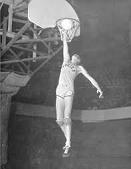

In Dec. 1944 six-foot-tenners Robert Albert "Bob" Kurland (1924-2013) of Okla. State U. (really 7'0") (first player to regularly slam dunk, who got defensive goaltending banned by the NCAA in 1945) and George Lawrence "Mr. Basketball" Mikan Jr. (1924-2005) (pr. MY-kun) of DePaul meet in the basketball "Battle of the Giants" in the 1945 NIT Semifinal; the final sees DePaul defeat Bowling Green by 71-54; the George Mikan Rule outlaws defensive goaltending; they meet again in a Red Cross benefit game, and Kurland's team defeats Mikan's team by 52-44 to gain an undisputed nat. championship; Mikan becomes basketball's first superstar; Kurland is named All-Am. three years in a row, and plays on the gold medal 1948 and 1952 U.S. Olympic teams.

In 1945 the Rochester Seagrams basketball team (founded 1923) is renamed the Rochester Royals, and joins the NBL, moving to the BAA in 1948 and winning the NBA title in 1951 before moving to Cincinnati, Ohio in 1957 and becoming the Cincinnati Royals; in 1972 they move to Kansas City, Mo. and become the Kansas City Kings; in 1985 they move to Sacramento, becoming the Sacramento Kings, going on to become the only team to never trail in a NBA Finals series in 2013; meanwhile in 1945 after being discharged from the U.S. Navy, 5'10" Brooklyn, N.Y.-born William "Red" Holzman (1920-98) joins the Rochester Royals, becoming NBL rookie of the year and helping them win the title his first season, staying with them through their 1951 NBA championship, then leaving in 1953 for the Milwaukee Hawks, going on to become head coach in 1954-7, followed by head coach of the New York Knicks in 1967-82.
On Apr. 23, 1946 the Continental Basketball Assoc. (CBA) (original name Eastern Penn. [Prof.] Basketball League) is founded, featuring three African-Am. players on the Hazleton Mountaineers, which in 1955-6 becomes the first pro basketball team with an all-black starting lineup; in 1948-9 the all-black Dayton Rens competes in the NBL; in 1970 it is renamed the Eastern Basketball Assoc., billing itself as the world's oldest pro basketball league, becoming a minor league and farm team for the NBA, with 10-day temp worker contracts; in Aug. 1999 NBA star Isiah Thomas leads a group that purchases the CBA, which loses its deal with the NBA and goes bankrupt on Feb. 8, 2001; in 2001-9 it is revived.




Back when white men still thought they could jump? On June 6, 1946 the Basketball Assoc. of Am. (BAA) is founded in the U.S. by members of the Arena Assoc. of Am., with Ukrainian-born Jewish atty. (Am. Hockey League pres.) Maurice Podoloff (1890-1985) as pres. #1 (until 1963), starting with 11 teams, incl. the (Boston Celtics, Philadelphia Warriors, Providence Steamrollers, Washington Capitols (coached by Brooklyn, N.Y.-born cigar-loving Arnold Jacob "Red" Auerbach (1917-2006) until 1949, followed by the Tri-Cities Blackhawks in 1949-50, and the Boston Celtics in 1950-66), New York Knickerbockers, and Toronto Huskies in the Eastern Div., and the Pittsburgh Ironmen, Chicago Stags, Detroit Falcons, St. Louis Bombers, and Cleveland Rebels in the Western Div.; on Nov. 1, 1946 the first prof. basketball game (four 12-min. quarters) is played by the ABA in Toronto, Canada, with the New York Knickerbockers defeating the Toronto Huskies by 68-66 before a crowd of 7,090 at Maple Leaf Gardens, with no shot clock or zone defenses, and few jump shots; Oscar Benjamin "Ossie" Schectman (1919-2013) of the Knickerbockers makes the first basket; anyone taller than 6'8" Huskies player George Thomas Nostrand (1924-81) is admitted free; on Jan. 11, 1947 the BAA outlaws zone defense; in 1947 the BAA introduces a collegiate draft; the 1947 title is won by the Philadelphia Warriors, followed by the Baltimore Bullets in 1948, and the Minneapolis Lakers in 1949; in 1949 they merge with the NBL to form the NBA.

On Nov. 5, 1946 after playing for the Rochester Royals during WWII, 6'5" future "Lucas McCain in The Rifleman" actor Kevin Joseph "Chuck" Connors (1921-92) of the Boston Celtics (#11) becomes the first to shatter a backboard during pregame warmups at Boston Arena due to faulty installation; in 1949 he joins the Brooklyn Dodgers for one game, then in 1959 joins the Chicago Cubs as a 1st baseman for 66 games, getting drafted by the NFL Chicago Bears but never suiting up; he goes on to become one of only 12 athletes to play for both ML baseball and the NBA.
On Nov. 9, 1946 after holding out for several weeks for more money, George Mikan makes his pro debut for the NBL Chicago American Gears in a 66-61 loss to the Oshkosh All-Stars, going on to lead playoff upsets over three teams to win the 1947 NBL Championship, which goes to owner Maurice White's head, causing him to leave the NBL and form his own 16-team Prof. Basketball League of America (PBLA), which folds in weeks in 1948, causing the Gears to fold with them.

On June 3-14, 1947 the 1947 BAA Finals sees the Philadelphia Warriors (coach Edward Gottlieb), led by 6'5" Joseph Franklin "Jumping Joe" Fulks (1921-76) ("first of the high-scoring forwards") defeat the Chicago Stags (coach Harold Olsen) by 4-1; on Feb. 10, 1949 Fulks scores a record 63 points, which isn't bested until 1959 by Elgin Baylor with 64 points.

On July 1, 1947 the 1947 BAA Draft sees Ogden, Utah-born 5'7" point guard Wataru "Wat" Misaka (1923-) selected by the New York Knickerbockers, becoming the first non-Caucasian and first Asian player in the BAA and NBA; he is cut after playing three games and scoring seven points.
In 1947 the Nat. Industrial Basketball League (NIBL) for mill workers is founded by five industrial teams belonging to the NBL that didn't join the NBA, incl. the Peoria Cats, Milwaukee Allen-Bradleys, Akron Goodyear Wingfoots, Milwaukee Harnischfeders, and Fort Wayne General Electrics, with the Bartlesville Phillips 66ers (Oilers) and Denver Chevies replacing the Harnischfeders and General Electrics in 1948; in 1949 the Dayton Industrialists join; the 66ers become league champions in 1949, 1950, 1951, and 11x in 14 seasons; in 1961 after expanding to 11 teams then shrinking to six, the NIBL becomes the Nat. Alliance of Basketball Leagues (NABL).

On Jan. 28, 1948 5'11" Providence Steamrollers head coach Matthew "Nat" Hickey (1902-79), former guard-forward for the Original Celtics et al. activates himself as a player for one game, making 0 out of 6 field goals and committing 5 personal fouls, scoring 2 points off of foul shots, becoming the oldest player in NBA history at 45 years 363 days (until ?).
On Apr. 10-21, 1948 the 1948 BAA Finals sees the Baltimore Bullets (coach Buddy Jeannette) defeat the Philadelphia Warriors (coach Edward Gottlieb) by 4-2.
In 1948 the Rochester Royals, Fort Wayne Pistons, Minneapolis Lakers, and Indianapolis (Kautskys) Jets jump from the NBL to BAA, establishing it as the league for college stars looking to turn pro; the Dayton Rens join the NBL, becoming their first and only all-black team, setting the stage for integration of the NBA; too bad, after finishing in last place with a 16-43 record they exeunt stage left.



On Mar. 21, 1949 the 1949 BAA Draft (last before being renamed the NBA in Aug.) sees 11 teams select 75 players in eight rounds; 6'8 St. Louis, Mo.-born center Charles Edward "Easy Ed" Macauley (1928-2011) of St. Louis U. is selected #1 by the St. Louis Bombers (#22); 6'7" Parlier, Calif.-born Askov, Minn.-raised Arild Verner Agerskov "Vern" Mikkelsen (1928-2013) of Hamline U. is selected #2 by the Minneapolis Lakers (#19), becoming one of its first power forwards, retiring in 1969 after setting the NBA record for disqualifications (127 in 631 games); 6'0" Bronx, N.Y.-born guard Richard Joseph "Dick" McGuire (1926-2010) of St. John's U. is selected #7 by the New York Knicks (#15), leading the league in assists in his rookie season with a record 386; in 1957 he is traded to the Detroit Pistons, becoming a player-coach in 1959, and head coach in 1960-3, followed by head coach of the Knicks in 1965-8.

A good big man becomes better than a good little man in basketball? On Apr. 4-13, 1949 the 1949 BAA Finals sees the Minneapolis Lakers (coach John Kundla) defeat the Washington Capitols (coach Red Auerbach) by 4-2; Game 5 on Apr. 11 sees the Minneapolis Lakers lose 74-66 to the Washington Capitols despite 6'10" 245 lb. bespectacled Lakers center ("Mr. Basketball") George Lawrence Mikan Jr. (1924-2005) scoring 22 points (NBA's first dominant big man); the Lakers go on to win Game 6 77-56 along with their first title behind Mikan's 29 points.
On Aug. 3, 1949 six teams from the NBL join the 11-team BAA, forming the 17-team Nat. Basketball Assoc. (NBA), the first prof. basketball league to play all its games in large arenas in major cities, with Maurice Podoloff (1890-1985) as commissioner #1 (until 1963), followed by Walter Kennedy in 1963-75, Larry O'Brien in 1975-84, David Stern in 1984-2014, and Adam Silver in 2014-; teams incl. the Syracuse Nationals (1946-), Chief Anderson Meat (Duffey) Packers (1946-51), Tri-Cities Blackhawks (1946-), Sheboygan Red Skins (1938-49), Denver Nuggets (1948-50) (first major prof. sports franchise in Colo. and first NBA franchise W of the Mississippi River), Waterloo Hawks (1948-51) (first and only major sports franchise based in Iowa), and former NBL-BAA teams incl. the Rochester Royals, Fort Wayne Pistons, Minneapolis Lakers, and Indianapolis (Kautskys) Jets.
In Mar. 1950 City College of New York (CCNY) (coach Nat Holman) becomes the first college basketball team (until ?) to win the NCAA and NIT titles the same year, defeating Bradley U. in both.


On Apr. 8-23, 1950 the 1950 NBA Finals sees the Minneapolis Lakers (coach John Kundla) defeat the Syracuse Nationals (coach Al Cervi), led by 6'7" Adolph "Dolph" Schayes (1928-) by 4-2 (2nd title, and 1st back-to-back repeat); in Game 1 Robert William "Bob" "Tiger" Harrison (1927-) scores the first buzzer-beater in the finals.
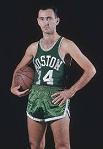

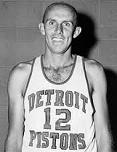
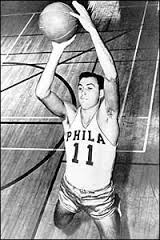
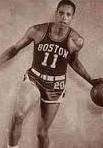
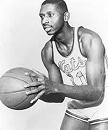

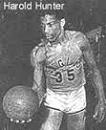
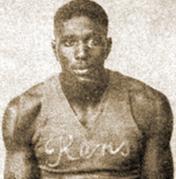
The NBA finds out that once you go black you can never go back? On Apr. 25, 1950 the first-ever 1950 NBA Draft selects 121 players for 12 teams in 12 rounds; 6'1" point guard ("the Houdini of the Hardwood") ("Mr. Basketball") Robert Joseph "Bob" "Cooz" Cousy (1928-) is selected 3rd overall in round 1 by the Tri-Cities Blackhawks, but fails to report, causing him to be picked up by the Chicago Stags, who fold, after which the Boston Celtics pick him up (#14) despite owner Walter A. Brown not liking him, uttering the soundbyte "I could have fallen to the floor" when he hears the news; he goes on to lead the NBA in assists eight straight times; after playing for the Brooklyn Dodgers farm team, 6'1" Abilene, Tex.-born guard William Walton "Bill" Sharman (1926-2013) of USC is drafted in round 2 (16th overall) by the Washington Capitols (#10), then drafted by the Fort Wayne Pistons 1951 after they disband, who trade him to the Boston Celtics (#21), where he partners with Bob Cousy, becoming the greatest backcourt duo in NBA history; in 1961 he leaves to become coach of the ABL Cleveland Pipers, working up to head coach of the Los Angeles Lakers in 1971-6; 6'5" forward-guard George Harry "Bird" Yardley III (1928-2004) is drafted in round 1 (7th overall) by the Fort Wayne Pistons (#12), going on to become the first NBA player to score 2000 points in the 1957-8 season; Philly-born 6'4" forward-guard (Villanova U.) "Pitchin' Paul Joseph Arizin (1928-2006) is the territorial pick for the Philadelphia Warriors (#11), retiring in 1962 with the 3rd highest career point total in NBA history (16,266); after becoming the first African-Am. player to integrate Southern college basketball games at West Va. State College, Charles Henry "Chuck" Cooper (1926-84) is drafted as the first pick in round 2 (12th overall) by the Boston Celtics (#11), becoming the first black player drafted by the NBA, making his debut on Nov. 1: in 1954 he is traded to the Milwaukee Hawks (until 1956); in round 9 Alexandria, Va.-born Earl "the Big Cat" Lloyd (1928-2015) is drafted (100th overall), becoming the the first African-Am. to play in an NBA game on Oct. 31 for the Washington Capitols against the Rochester Royals; after the team folds on Jan. 9, 1951, he plays for the Syracuse Nationals in 1952-8, defeating the Fort Wayne Pistons 4-3 for the 1955 NBA title, then the Detroit Pistons in 1958-60, going on to coach the Detroit Pistons in 1971-2; 6'7" Little Rock, Ark.-born Nathaniel "Sweetwater" Clifton (1922-90) becomes the 3rd African-Am. player drafted by the NBA, and on May 24 the 2nd to sign with the NBA, making his debut on Nov. 4 (Nov. 3?) for the New York Knicks (#8), becoming the first NBA black star, playing until 1956 when he becomes the oldest NBA player to be named All-Star, then the Detroit Pistons in 1957-8; on Apr. 26 after being drafted in round 10 by the Washington Capitols (#35), Harold Hunter (1926-2013) becomes the first African-Am. to sign with the NBA; too bad, he is cut in training camp, going on to coach at Tenn. State U. in 1959-68, racking up a 172-67 record incl. four 20+-in-a-row; on Dec. 3 Henry Lincoln "Hank" DeZonie (1922-2009) signs with the Tri-Cities Blackhawks, becoming the 4th African-Am. player in the NBA, quitting after five games.
On Nov. 22, 1950 the Fort Wayne Pistons defeat the Minneapolis Lakers by 19-18, becoming the lowest-scoring game in NBA history (until ?).

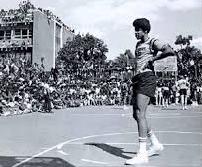
In 1950 NYC parks and recreation playground dir. (1948-65) Holcombe Rucker (1926-65) launches an annual street basketball tournament in Rucker Park (P.S. 156 Playground) at 155th St. and Frederick Douglass Blvd. in Harlem, N.Y. across the street from the former Polo Grounds, which attracts future NBA superstar talent and introduces slam dunks, crossover dribbles and other advanced techniques before the NBA adopts them; players incl. Earl Monroe, Wilt Chamberlain, Kareem Abdul-Jabbar, Nate Archibald, Julius Erving, Ron Artest, and Connie Hawkins; in 2002 TNT debuts the film On Hallowed Ground: Streetball Champions of Rucker Park.
On Jan. 6, 1951 Indianapolis defeats Rochester by 75-73 in six OT periods, becoming the longest NBA game (until ?).


On Mar. 2, 1951 the first NBA All-Star Game, brainchild of league public relations dir. (1950-69) Haskell Cohen (1914-2000) is held in Boston, Mass.; East (coach Joe Lapchick) defeats West (coach John Kundla) by 111-94 before 10,094 fans; players receive a $25 savings bond; 6'8" Boston Celtics center Charles Edward "Easy Ed" Macauley (1928-2011) (#22) scores 20 points and grabs six rebounds while holding Minneapolis Lakers star George Mikan to 4-for-17 shooting and 12 points; in 1953 the NBA decides to begin awarding a NBA All-Star Game MVP Award, retroactively awarding it to Ed Macauley for 1951 and Paul Arizin for 1952; in 1960 Macauley becomes the youngest male player admitted to the basketball hall of fame (until ?).
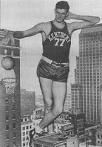
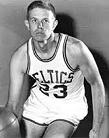
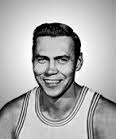
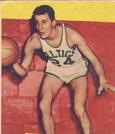
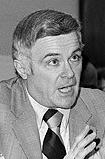
In Mar. 1951 the U. of Ky. defeats Kansas State U. by 68-58 to win the NCAA title; too bad, on Feb. 18, 1951 the CCNY Point Shaving Scandal starts with the arrest of City College of New York players incl. Ed Warner, Ed Roman, and Al Roth after a sting operation uncovers organized crime hanky-panky in the 1950 NCAA Men's Div. 1 Basketball Tournament involving the CCNY Beavers, growing to 33 players in 6+ other schools, incl. the U. of Ky. in fall 1952 (accused over a 4-year period), causing the MVP award of 7'0" Wildcats senior (center) William Edwin "Bill" Spivey (1929-95) (#77) (who denies involvement, only to be charged with perjury, ruining his career and his life) to be vacated, and CCNY to be banned from playing at Madison Square Garden; coach Nat Holman is cleared of wrongdoing; the U. of Ky. Wildcats become the first college sports team to get the "death penalty" of being banned from the NCAA tournament, freezing-out sophomores Frank Vernon Ramsey Jr. (1931-) (#30), Clifford Oldham "Cliff" "Li'l Abner" Hagan (1931-) (#6), and Louis C. "Lou" Tsioropoulos (1930-) (#16), who are all selected by the Boston Celtics in the 1953 NBA Draft but return to the U. of Ky. for one more season after graduating, helping them to a perfect 25-0 record, gaining them a #1 AP ranking and an invitation to the NCAA tournament, which they decline because postgrads aren't allowed to participate; in 1951 college dropout Walter Byers (1922-) is hired as the NCAA dir. (until 1988) to clean up their image, immediately expanding the NCAA men's basketball tournament from 8 to 16 teams, then using his power to negotiate TV contracts that turn NCAA into a billion-dollar empire, leading to a 1984 U.S. Supreme Court ruling that frees schools to negotiate individual contracts; by 2011 the men's basketball tournament brings in $771M from CBS-TV and TBS.
On Apr. 7-21, 1951 the 1951 NBA Finals sees the Rochester Royals (coach Les Harrison) defeat the New York Knickerbockers (coach Joe Lapchick) by 4-3; first finals for both teams.




On Apr. 25, 1951 the 1951 NBA Draft sees 10 teams select 87 players in 12 rounds; 5'11" guard Myler Upton "Whitey" Skoog (1926-) of the U. of Minn. is the territorial pick of the Minneapolis Lakers (#41); 5'8" point guard Eugene "Gene" "Squeaky" Melchiorre (1927-) of Bradley U. is selected #1 by the Baltimore Bullets, but prevented from playing due to the point-shaving scandal; 6'6" forward-center Melvin R. "Mel" Hutchins (1928-) of Brigham Young U. (brother of 1952 Miss America Colleen Kay Hutchins, and uncle of Kiki Vandewegh) is selected #2 by the Tri-Cities Blackhawks (#14), becoming co-leader of the NBA in total rebounds (880) as a rookie, sharing the sportswriters rookie of the year award with Bill Tosheff, switching to the Fort Wayne Pistons (#9) in 1957-8, and the New York Knicks (#46) in 1957-8; 6'1" guard Donald J. "Don" Sunderlage (1929-61) of the U. of Ill. is selected #9 by the Philadelphia Warriors, who trade him to the Tri-Cities Blackhawks (#11) in 1953, who trade him in 1954 to the Minneapolis Lakers (#18), playing for them only one season.
In 1951 the Tri-Cities Blackhawks NBA team (founded 1946) becomes the Milwaukee Hawks; in 1955 it becomes the St. Louis Hawks; in 1968 it becomes the Atlanta Hawks.
In 1951 a record basketball crowd of 75K watch the Harlem Globetrotters perform at Berlin Olympic Stadium.
On Apr. 12-25, 1952 after the NBA widens the foul lane from 6' to 12', the 1952 NBA Finals sees the Minneapolis Lakers (coach John Kundla) defeat the New York Knickerbockers (coach Joe Lapchick) by 4-3, becoming the first NBA 3-peat.




On Apr. 26, 1952 the 1952 NBA Draft sees 10 teams select 106 players in 17 rounds; 6'4" forward ("the Owl without a Vowel") William P. "Bill" Mlkvy (1931-) of Temple U. (1951 NCAA scoring champion) is the territorial pick of the Philadelphia Warriors (#16), playing only one season; 6'9" forward-center Mark Cecil Workman (1930-83) of the U. of W. Va. is selected #1 by the Milwaukee Hawks (#12), but goes on a tour of Europe with the Harlem Globetrotters before playing for the Phildelphia Warriors (#24), switching to the Baltimore Bullets (#24) in 1953-4, ending his career with a measly 4.9 points, 2.9 rebounds, and 0.6 assists per game; 6'10" forward-center Clyde Edward Lovellette (1929-) of the U. of Kansas (MVP of the 1942 NCAA title team, leading the NCAA with a record 141 points, known for his 1-handed set shot) is selected #9 by the Minneapolis Lakers (#34), going on to help them win the 1954 NBA title, followed by the Cincinnati Royals (#89) in 1957-8, the St. Louis Hawks (#34) in 1958-62, and the Boston Celtics (#4) in 1962, helping them win the 1963 and 1964 titles; 6'7" forward-center Don "Monk" Meineke (1930-2013) of the U. of Dayton is selected #12 by the Fort Wayne Pistons (#17), going on to win the first NBA Rookie of the Year Award.
On Apr. 4-10, 1953 the 1953 NBA Finals sees the Minneapolis Lakers (coach John Kundla) defeat the New York Knickerbockers (coach Joe Lapchick) by 4-1 (5th straight title).









On Apr. 24, 1953 the 1953 NBA Draft sees nine teams select 122 players in 19 rounds; 6'4" guard-forward Ernest Joseph "Ernie" Beck (1931-) of the U. of Penn. is the territorial pick of the Philadelphia Warriors (#7); 7'0" center Walter F. Dukes (1930-2001) of Seton Hall U. is the territorial pick of the New York Knicks (#24) (1955-6), first playing for the Harlem Globetrotters in 1953-5, then moving to the Minneapolis Lakers (#14) in 1956-7, and the Detroit Pistons (#23) in 1957-63, going on to lead the NBA in personal fouls in 1958 and 1959, and in disqualifications in 1958-1962, setting a record with 121 career disqualifications; 6'11" center Raymond Darlington "Ray" Felix (1930-91) of Long Island U. is selected #1 by the Baltimore Bullets (#25), winning rookie of the year, becoming the 2nd African-Am. after Don Barksdale to be named an All-Star, moving to the New York Knicks (#19) in 1954-60, and the Los Angeles Lakers (#14) in 1960-2; 6'8" Vancouver, Canada-born forward-center Robert J. "Bob" Houbregs (1932-2014) of the U. of Washington is selected #2 by the Milwaukee Hawks (#10), who trade him to the Baltimore Bullets (#14) (1953-4), moving to the Boston Celtics (#20) (1954), and Fort Wayne/Detroit Pistons (#8) (1954-8); 6'2" guard Richard Joseph "Richie" Regan (1930-2002) of Seton Hall U. is selected #4 by the Rochester Royals (#14), moving to the Baltimore Bullets in 1958-9; 6'3" guard-forward Frank Vernon Ramsey Jr. (1931-) of the U. of Ky. is selected #5 by the Boston Celtics (#23), playing one year with them then joining the military for one year before rejoining them for eight seasons, helping them to seven championships (1957, 1959-64); 6'4" guard-forward Clifford Oldham "Cliff" "Li'l Abner" Hagan (1931-) of the U. of Ky. (known for his hook shot) is selected #21 by the Boston Celtics, electing to serve with the USAF for two years, winning basketball championships, after which he and Ed Macauley are traded to the St. Louis Hawks (#6) for draft rights to Bill Russell; 6'2" guard Jack Edwin George Jr. (1928-89) of the La Salle U. is selected #102 by the Philadelphia Warriors (#4/#17), becoming known for being in the top-10 for assists per game in six seasons, and total min. played (2,840) in 1955-6; 6'9" forward Kenneth Robert "Ken" Sears (1933-) of the U. of Santa Clara U. is selected #108 by the New York Knicks, becoming the first basketball player on the cover of Sports Illustrated mag. (Dec. 20, 1954 issue); after passing to stay in school, he is selected #4 in the 1955 draft by the Knicks again (#12), playing until 1964, going on to lead the NBA in field goal percentage in 1959 and 1960, moving to the ABL San Francisco Saints in 1961-2, returning to the Knicks in 1962, and finishing with the San Francisco Warriors in 1962-4.
In 1953 the Atlantic Coast Conference (ACC) is founded in Greensboro, N.C. by the NCAA's Div. 1.; members incl. the U. of N.C., Duke U., U. of Md., N.C. State U., Wake Forest U., U. of Va., Clemson U., Georgia Tech U., Fla. State U., Virginia Tech, Boston College, and U. of Miami.

On Feb. 13, 1954 Franklin Delano "Frank" Selvy (1932-) of Furman U. in S.C. scores 100 points against Newberry College, becoming the first NCAA Div. 1 basketball player to do so (until ?), gaining the nickname "The Corbin Comet" for his birthplace in Ky.
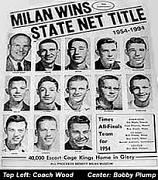

On Mar. 13, 1954 the Milan Ind. H.S. Indians basketball team (school enrollment 161) (coach Marvin Wood) defeats the much larger Muncie Central H.S. Bearcats by 32-30 to win the Ind. state championship after 6'1" Milan star player Bobby Gene Plump (1936-) (#25) hits a 14-footer ("The Shot") as the clock runs out; Plump is awarded the Ind. Mr. Basketball title for 1954, then plays for the Phillips 66ers of the NIBL in 1958-61; filmed in 1986 as "Hoosiers" starring Gene Hackman.
On Mar. 31-Apr. 12, 1954 after consolidating to eight teams, the 1954 NBA Finals sees the Minneapolis Lakers (coach John Kundla) defeat the Syracuse Nationals (coach Al Cervi) by 4-3; 5th title and 3rd in a row for the Lakers.





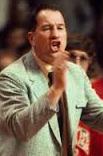



On Apr. 24, 1954 the 1954 NBA Draft sees nine teams select 100 players in 13 rounds; 5'3" Corbin, Ky.-born guard-forward Franklin Delano "Frank" Selvy (1932-) of Furman U. is selected #1 by the Baltimore Bullets; 6'9" Baton Rouge, La.-born forward-center Robert E. Lee "Bob" Pettit Jr. (1932-) of Louisiana State U. is selected #2 by the Milwaukee Hawks (#9); 6'2" Baltimore, Md.-born guard Eugene William "Gene" Shue (1931-) is selected #3 by the Philadelphia Warriors (#4), who trade him after six games to the New York Knicks (#6), who trade him in 1956 to the Fort Wayne Pistons (#7) (until 1962), who move to Detroit, Mich. in 1957, after which he becomes one of the NBA's top guards, inventing the Spin Move; 6'9" forward-center John Graham "Johnny" "Red" Kerr (1932-2009) of the U. of Ill. is selected #6 by the Syracuse Nationals (#10); 6'1" point guard Lawrence Ronald "Larry" Costello (1931-2001) of Niagara U. (the NBA's last 2-handed set shooter) is selected #12 by the Philadelphia Warriors (#5), switching to the Syracuse Nationals (#18) in 1957-65, and the Philadelphia 76ers (#6) in 1966-8, then becoming head coach of the Milwaukee Bucks in 1968-77, and the Chicago Bulls in 1978-9; 6'4" guard Richard Vincent "Richie" Guerin (1932-) of Iona College is selected #17 by the New York Knicks (#9), serving with the U.S. Marines before joining them in 1956, leading the team in assists and scoring in multiple seasons, scoring a team record 21 assists in 1958 and 57 points in 1959 before switching to the St. Louis Hawks (#15) in 1963-67 and 1968-70, playing alongside Lenny Wilkins and serving as coach in 1964-72, helping them to nine straight playoff appearances and becoming NBA coach of the year in 1967-8 after expansion team Seattle drafts him and he retires as a player, after which the Hawks move to Atlanta and Guerin is traded back, coming out of retirement as a reserve player, scoring 31 points against the Lakers in his last game on Apr. 19, 1970 vs. 39 by Jerry West, 31 by Elgin Baylor, and 11 by Wilt Chamberlain; 6'4" guard Charles E. "Chuck" Noble (1931-2011) of the U. of Louisville is selected #30 by the Philadelphia Warriors, electing to play instead for the Akron Goodyear Wingfoots of the NIBL before returning to the NBA to play for the Fort Wayne Pistons (#14) in 1955-62; 6'3" guard-forward Richard Eugene "Dick" Garmaker (1932-) of the U. of Minn. (#53) is selected #80 by the Minneapolis Lakers (#38), sitting the season out then being drafted again by the Lakers as their territorial pick, appearing as an NBA All-Star 4x before being traded to the New York Knicks (#17) for Ray Felix, playing in 1960-1.
On Oct. 30, 1954 after the Four Corners Offense stinks the game up, the NBA introduces the 24-sec. shot clock, created by Syracuse Nationals owner Dan Biasone, speeding-up gamess; no surprise, Syracuse wins the NBA Finals next year.
On Mar. 31-Apr. 10, 1955 the 1955 NBA Finals sees the Syracuse Nationals (coach Al Cervi) defeat the Fort Wayne Pistons (coach Charles Eckman) by 4-3; Game 6 sees George King of Syracuse make a free throw with 12 sec. left to give the Nationals a 92-91 lead, after which King steals the ball from Andy Phillip of Fort Wayne with 3 sec. to go to clinch the V.






On Apr. 13, 1955 the 1955 NBA Draft sees eight teams select 96 players in 15 rounds, after which the Milwaukee Hawks relocate to St. Louis, Mo., becoming the St. Louis Hawks; 6'6" guard-forward Thomas Joseph "Tom" Gola (1933-2014) of La Salle U. is the territorial pick of the Philadelphia Warriors (#15), concentrating on defense, allowing Paul Arizin, Neil Johnston, and later Wilt Chamberlain to concentrate on offense, moving to the New York Knicks (#6) in 1962-6; 6'7" forward-center Richard James "Dick" Ricketts Jr. (1933-88) of Duquesne U. is selected #1 by the St. Louis Hawks (#12), switching in 1956 to the Rochester Royals (#24), then retiring after the tragic injury to teammate Maurice Stokes, and pitching in 12 games for the 1959 Cardinals; 6'7" forward-center Maurice Stokes (1933-70) of St. Francis U. is selected #2 by the Rochester Royals (#12), becoming rookie of the year, then grabbing an NBA record 1,256 rebounds in his 2nd season, placing 2nd in rebounds and 3rd in assists in the 1957-8 season; too bad, on Mar. 12, 1958 in the last game of the 1957-8 season he hits his head on the court, suffering a seizure that permanently paralyzes him, after which his teammate (forward) (#10) (1955-66) John Kennedy "Jack" Twyman (1934-2012) of the U. of Cincinnati (selected #8) takes care of him; in his three seasons with the NBA Stokes grabs a record 3,492 rebounds along with 1,062 assists (2nd after Bob Cousy's 1,583); Twyman along with Wilt Chamberlain become the first players in NBA history to average 30+ points per game in the 1959-60 season, incl. one game where he scores 59 points; on June 9, 2013 the NBA Twyman-Stokes Teammate of the Year Award is established; 6'5" forward James "Jungle Jim" "Loscy" Loscutoff Jr. (1930-) of the U. of Oregon is selected #3 by the Boston Celtics (#18), helping to cure its poor defensive record despite becoming the first team to average 100 points per game in the 1954-55 season, later assisted by Bill Russell; 6'1" point guard K.C. Jones (1932-) of the U. of San Francisco is selected #76 by the Minneapolis Lakers, electing to stay in school, leading the Dons to NCAA titles in 1955 and 1956 and playing with Bill Russell on the gold medal-winning 1956 Olympic team in Melbourne, Australia before being selected #13 by the Boston Celtics (#27) in the 1956 draft, joining them in 1958 and retiring in 1967 after playing on eight championship teams and losing the 1967 playoffs to the Philadelphia 76ers, then becoming head coach for Brandeis U. in 1967-70, asst. coach for Harvard U. in 1970-1, asst. coach for the Los Angeles Lakers in 1971-2, head coach for the Washington Bullets in 1973-6, asst. coach for the Boston Celtics in 1978-83 followed by head coach in 1983-8, and asst. coach for the Seattle SuperSonics in 1989-90 followed by head coach in 1990-2.
In 1955 in order to give other players a chance against George Mikan, the NBA widens the free throw lane from 6 ft. to 12 ft.

In 1955 Wilmington, N.C.-born 6'3" George "Meadowlark" Lemon III (1932-2015) joins the Harlem Globetrotters (#36) (until 1980), becoming known as the "Clown Prince" and going on to play 16K+ games for them and become Wilt Chamberlain's favorite player.
On Mar. 31-Apr. 7, 1956 the 1956 NBA Finals sees the Philadelphia Warriors (coach George Senesky) defeat the Fort Wayne Pistons (coach Charles Eckman) by 4-1; first finals with alternating home games (next in 1971).





On Apr. 30, 1956 the 1956 NBA Draft sees eight teams select 92 players in 10 rounds; after drafting 6'7" forward-center Thomas William "Tommy" Heinsohn (1934-) (#15) as his territorial pick, Boston Celtics coach Red Auerbach sees the virtue of defensive play and trades 6-time All Star center Ed Macauley and rookie Cliff Hagan for U. of San Francisco teammates, 6'10" center William Felton "Bill" Russell (1934-2022) (#6) (first athletic big man in basketball) (overall pick #2) and 6'1" point guard K.C. Jones (1932-) (#27) (overall pick #13); Heinsohn plays until 1969, helping get the Nat. Basketball Players Assoc. (NBPA) (founded in 1954 by Bob Cousy) official recognition in 1964, then becomes the Celtics coach in 1969-78; 6'6" forward-center William Dean "Willie" Naulls (1934-) of UCLA (Calif. Mr. Basketball of 1952) is selected #9 by the St. Louis Hawks (#33), playing 19 games before being traded to the New York Knicks (#6), becoming the first African-Am. player to be named captain of a major prof. sports team and averaging a double-double each year; in 1962 he moves to the San Francisco Warriors (#71), followed in 1963-6 by the Boston Celtics (#12); 6'4" shooting guard Samuel "Sam the Shooter" Jones (1933-) of N.C. Central U. is selected #58 by the Minneapolis Lakers, but elects to stay in school and graduate, after which he is selected #8 in the 1957 draft by the the Boston Celtics (#24), where he becomes as a clutch scorer with a perfect jump shot form and great bank shot, teaming with K.J. Jones to become the Jones Boys, leading the Celtics in scoring in 1962-3, 1964-5, and 1965-6, scoring 15K points by the time he retires in 1969; forward Elgin Baylor of Seattle U. is selected #90 by the Minneapolis Lakers, electing to stay in college, leading the Chieftains to the NCAA championship (their last appearance in the Final Four until ?) and losing to the U. of Ky. Wildcats; on Nov. 19, 2009 Seattle U. names its basketball court in his honor.


On Nov. 22-Dec. 8, 1956 the XVI (16th) Summer Olympic Games are held in Melbourne, Australia; the almost all-white U.S. basketball team stars black players 6'10" William Felton "Bill" Russell (1934-2022) (first athletic big man in basketball) and 6'1" K.C. Jones (1932-), stomping the Soviet Union by at least 30 points a game (89-55 in the final) to win the gold; next year Russell and Jones go to the Boston Celtics and create a dynasty.
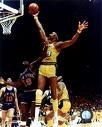
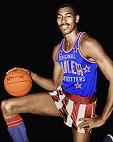

On Dec. 3, 1956 after being courted by several universities and deciding on the U. of Kansas because of coach Phog Allen, Philly-born 7'1" former Overbrook H.S. center Wilton Norman "Wilt" "the Stilt" "the Big Dipper" "Goliath" "Mister 100" Chamberlain (1936-99) makes his varsity debut with the U. of Kansas Jayhawks (#13), scoring a record 52 points and 31 rebounds in a 87-69 win over Northwestern U.; his team goes 13-1 until losing a game against Oklahoma State U. by 56-54 after they take advantage of no shot clock to hold the ball for the last 3.5 min.; Chamberlain goes on to become a track and field star, running the 100-yard dash in 10.9 sec., shot-putting 56 ft., triple-jumping 50 ft., and winning the high jump for three straight years in the Big Eight championships.

In 1956 the U.S. Basketball Writers Assoc. (USBWA) is founded for college basketball journalists by NCAA dir. (1951-88) Walter Byers (1922-), establishing the Oscar Robertson Trophy in 1959 for the best men's player of the year, with guess who of the U. of Cincinnati winning the first two years, followed for two years by Jerry Lucas of Ohio State U.
On Mar. 23, 1957 North Carolina U. wins the NCAA basketball championship with the first-ever perfect record (32-0).
On Mar. 30-Apr. 13, 1957 the 1957 NBA Finals sees the Boston Celtics (coach Red Auerbach) defeat the St. Louis Hawks (coach Alex Hannum) by 4-3; first trip to the finals for both teams; Celtics center Bill Russell sets a rookie record for rebounds with 32 in Game 7, with a rookie record 22.9 per game for the series.


On Apr. 17, 1957 after the Fort Wayne Pistons relocate to Detroit, Mich., becoming the Detroit Pistons, and the Rochester Royals relocate to Cincinnati, Ohio, becoming the Cincinnati Royals, the 1957 NBA Draft sees eight teams select 83 players in 14 rounds; 6'4" guard Rodney Clark "Hot Rod" Hundley (1934-) of the U. of W. Va., known for his flashy dribbling is selected #1 by the Cincinnati Royals, who trade him to the Minneapolis Lakers (#33), retiring in 1963 to become an announcer for the Phoenix Suns and Los Angeles Lakers, becoming the first voice of the New Orleans Jazz in 1974; after playing for the Harlem Globetrotters in 1955-7, 6'7" forward-center Woodrow "Woody" Sauldsberry Jr. (1934-2007) of Texas Southern U. is selected #60 (round 8) by the Philadelphia Warriors (#21), becoming the 2nd African-Am. and lowest overall draft pick to win NBA rookie of the year.
On Nov. 16, 1957 Bill Russell of the Boston Celtics grabs a record 32 rebounds in one half in a 111-89 V over the Philadelphia 76ers, finishing the game with 49; on Feb. 5, 1960 he grabs 51 rebounds in a game against Syracuse, which Wilt Chamberlain passes on Nov. 24, 1960 with 55 in a game against the Celtics.
In 1957 the Fort Wayne Pistons move to Detroit, Mich., becoming the Detroit Pistons.

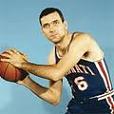
On Mar. 26, 1958 after winning 76 straight games and two straight state titles, the 24-0 Middletown Middies are upset 63-62 by the 24-0 Columbus North H.S. Polar Bears, coached by Frank Wilson Truitt Jr. (1925-2014) at the Div. AA state semifinals after North's Eddie Clark drives past 6'8" Middleton star Jerry Ray Lucas (1940-) ("best high school player in the nation") ("most heavily recruited high school player with the possible exception of Wilt Chamberlain"), becoming "the biggest upset in Ohio high school basketball history"; too bad, the Polar Bears lose the state championship to East Tech by 50-48 in double OT; Truitt goes on to become asst. basketball coach at Ohio State U. in 1958-65, helping coach them to the 1960 NCA championship.
On Mar. 29-Apr. 12, 1958 the 1958 NBA Finals sees the St. Louis Hawks (coach Alex Hannum) defeat the Boston Celtics (coach Red Auerbach) by 4-2 for their first title; in Game 3 Bill Russell of the Celtics blocks a shot by Bob Pettit and badly sprains his right ankle, causing him to withdraw from the series; Game 6 sees Bob Pettit (#9) score 50 points (19 of their last 21 points) in a 110-109 win; on Nov. 13, 1964 Pettit becomes the first NBA player to score 20K points.



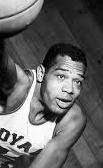



On Apr. 22, 1958 the 1958 NBA Draft sees eight teams select 88 players in 17 rounds; 6'0" point guard Guy William Rodgers (1935-2001) of Temple U. (#5) is the territorial pick of the Philadelphia Warriors (#25), going on to score 20 assists in Wilt Chamberlain's 100-point game, lead the NBA in assists in 1962-3 (10.4 per game), and tie Bob Cousy's record of 28 assists in a single game on Mar. 14, 1963; in 1966-7 he plays for the Chicago Bulls (#5), with an NBA record 908 assists; the Minneapolis Lakers (who finished the season at 19-53) use their #1 overall pick to draft 6'5" Washington, D.C.-born small forward Elgin Gay "Rabbit" Baylor (1934-) (#22), known for using his running bank shot to score over taller opponents, who skips his senior year at Seattle U., signing for $20K a year, with Lakers owner Bob Short uttering the soundbyte: "If he had turned me down then, I would have been out of business. The club would have gone bankrupt"; he goes on to win rookie of the year and score 55 points in a single game (3rd highest in NBA history behind Joe Fulks's 63 and George Mikan's 61) and save the franchise; too bad, he injures his knee in the 1965 Western Div. playoffs, and never again averages over 30 points per game; he retires 9 games into the 1971-2 season right before the first of their 33 consecutive win streak and an NBA title, but is given a championship ring anyway; in 1986-2008 he becomes vice-pres. of operations for the Los Angeles Clippers; 6'2" Huntington, W. Va.-born guard-forward Harold Everett "Hal" Greer (1936-) of Marshall U. is drafted #13 (round 2) by the Syracuse Nationals (#15) (until 1973), going on to become a teammate of Wilt Chamberlain and a star on the 1966-7 team that ends the 8-year reign of the Bill Russell-led Boston Celtics; he becomes known for shooting free throws as a jump shot from the charity stripe, becoming the #3 top guard of the 1960s afer Oscar Robertson and Jerry West; 6'8" forward-center Wayne Richard Embry (1937-) of Miami U. is selected #22 by the St. Louis Hawks, who trade him to the Cincinnati Royals (#34) in exchange for center Clyde Lovellette and four others, going on to become known for his pick and roll play with Oscar Robertson and become team captain in 1963, moving to the Boston Celtics (#32) in 1966-8, and the Milwaukee Bucks (#15) in 1968-9, retiring to become the first African-Am. gen. mgr. in the NBA for the Milwaukee Bucks (1972-9), Cleveland Cavaliers (1986-99), and Toronto Raptors (2006); 6'3" guard Donald Jay "Don" "Waxie" Ohl (1936-) of the U. of Ill., known for his distance shooting is selected #36 by the Philadelphia Warriors, electing to play for the Peoria Cats of the AAU in 1959-60 before moving to the Detroit Pistons (#10) in 1960-4, followed by the Baltimore Bullets (#30) after an 8-player deal that also incl. Bailey Howell, finishing with the St. Louis Hawks in 1968-70; 6'1" guard Adrian Howard "Odie" Smith (1936-) of the U. of Ky. (#50) is selected #85 (15th round) by the Cincinnati Royals, electing to join the U.S. Army, playing for the 1960 U.S. men's Olympic basketball team in Rome before joining the Cincinnati Royals (#10) in 1961-9, playing backup behind Oscar Robertson and Bucky Bockhorn.
In 1958 Wilt Chamberlain leaves the U. of Kansas after his junior year, with a 2-year average of 29.9 points and 18.3 rebounds per game, and a total of 1,433 points and 877 rebounds, along with one Big Seven title, selling his story "Why I Am Leaving College" to Look mag. for $10K; after the NBA bans him for a year for not finishing, he joins the Harlem Globetrotters (#13) for $50K - this is the old me, this is the new me?
In 1958 after his college basketball career sends shockwaves, the Wilt Chamberlain Rule bans offensive goaltending (touching the ball inside the basket); after he regularly upchucks a free throw then slam dunks it, or leaps from the free-throw line to dunk it, the Wilt Chamberlain Free Throw Plane Rule bans players from crossing the plane of the free-throw line when shooting a free throw.
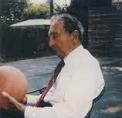
In the late 1950s Logansport, Ind.-born Butler U. basketball coach (1926-70) Paul D. "Tony" Hinkle (1899-1992) introduces the orange (instead of brown) basketball, along with the Hinkle Offensive System.







On Mar. 31, 1959 the 1959 NBA Draft sees eight NBA teams draft 85 players in 14 rounds; Philly-born 7'1" center Wilton Norman "Wilt" "the Stilt" "the Big Dipper" "Goliath" "Mister 100" Chamberlain (1936-99) of the U. of Kansas is a territorial pick of the Philadelphia Warriors (#13), moving to the Philadelphia 76ers (#13) in 1965-8, and the Los Angeles Lakers (#13) in 1968-73 before coaching the ABA San Diego Conquistadors in 1973-4; 6'8" forward-center Robert Dean "Bob" Ferry (1937-) of Saint Louis U. is a territorial pick of the St. Louis Hawks (#20), moving to the Detroit Pistons (#16) in 1960-4, and the Baltimore Bullets (#22) in 1964-8, then becoming an asst. coach followed by gen. mgr. of the Bullets; forward Robert Louis "Bob" Boozer (1937-2012) of Kansas State U. is selected #1 by the Cincinnati Royals (#13), moving to the New York Knicks (#14) in 1963-5, Los Angeles Lakers (#15) in 1965-6, Chicago Bulls (#19) in 1966-9, Seattle SuperSonics (#20) in 1969-70, and Milwaukee Bucks (#20) in 1970-1; 6'7" forward Bailey E. Howell (1937-) of Miss. State U. (#52) (a junior) is selected #2 by the Detroit Pistons (#52), moving to the Baltimore Bullets (#18) in 1964-6, the Boston Celtics (#15) in 1966-70, and the Philadelphia 76ers (#16) in 1970-1; on Feb. 7, 2009 Howell's jersey #52 is retired, and the Bailey Howell Award is established for the best collegiate basketball player in Miss.; 6'4" guard-forward Richard "Dick" "the Skull" "Fall Back Baby" Barnett (1936-) of Tenn. State U., known for kicking his legs back while taking a jump shot is selected #4 by the Syracuse Nationals (#5), jumping ship to play for the ABL Cleveland Pipers (#54) in 1961-2, leading them to the ABL championship in 1961-2, then returning to the Los Angeles Lakers (#12) in 1962-5), followed by the New York Knicks (#12) in 1965-73; 6'5" forward John M. "Jumpin' Johnny" Green (1933-) of Mich. State U. is selected #5 by the New York Knicks (#11), setting a Knicks rookie record of 25 rebounds, followed by a Feb. 1962 record of three straight games with 20+ rebounds; 6'7" forward-center Rudolph A. "Roughhouse Rudy" LaRusso (1937-2004) of Dartmouth College (where he set an Ivy League record of 32 rebounds in a game against Columbia U. in 1958) is selected #10 by the Minneapolis Lakers (#35), going on to score 50 points in 1962 against the St. Louis Hawks, a record for a Jewish NBA player.
On Apr. 4-9, 1959 the 1959 NBA Finals sees the Boston Celtics (coach Red Auerbach) defeat the Minneapolis Lakers (coach John Kundla) by 4-0, becoming the first of eight titles in a row; first team from Minn. in the finals, and first with a losing record.

On July 9, 1959 the Harlem Globetrotters visit the Lenin Central Stadium in Moscow for the first of nine exhibition games against the Chinese Basketeers of San Francisco with a total attendance of 135K, receiving $4K each for each game; they are greeted before the first game by Nikita Khrushchev, who met them earlier on their sightseeing tour of Moscow, posing for pictures; the program incl. seven vaudeville acts incl. bicyclist Kim Yohoi, "A Scottish monocyclist who balanced cups and saucers, a German brother and sister act in which she twirls head down on her brother's head, an Argentine youth doing flamenco dancing on roller skates, and a table tennis match"; Wilt Chamberlain and Meadowlark Lemon perform a skit where Lemon collapses to the ground and Chamberlain throws him up in the air and catches him like a doll, causing Lemon to call him "the strongest athlete who ever lived."

In Oct. 1959 Philly-born former Harlem Globetrotter (since 1958) Wilton Norman "Wilt" "the Stilt" "the Big Dipper" "Goliath" "Mister 100" Chamberlain (1936-99) signs a record $30K rookie contract with the Philadelphia Warriors, $5K more than previous highest earner Bob Cousy of the Celtics; on Oct. 24 he makes his debut as an NBA player in a 118-109 win over the New York Knicks; he goes on to become the first basketball player to earn $100K a year, earning a record $1.5M in his years with the Los Angeles Lakers (1968-73); in his Philly years his lifestyle incl. living in an apt. in New York City, staying out all night, sleeping until noon, then commuting to work; in his Lakers years he builds the Ursa Major (Big Dipper) Mansion in Bel-Air Calif. for his playboy lifestyle, complete with mirrored walls and fur-covered waterbed in his bedroom, living with two cats named Zip and Zap and several Great Danes, driving a Ferrari, Bentley, and a Le Mans racer called Searcher One that is built for $750K in 1996; at his death his estate is valued at $25M.
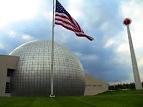
In 1959 the Naismith Memorial Basketball Hall of Fame is founded by former Colby Colege athletic dir. Lee Williams; the basketball-shaped bldg. at 1000 Hall of Fame Ave. in Springfield, Mass. opens on Feb. 17, 1968.
On Jan. 26, 1960 6'0 senior Danny Heater (1942-) of Burnsville H.S. in W. Va. sets a h.s. basketball record (until) by scoring 135 points in a 32-min. basketball game, incl. 53 field goals, 29 of 41 free throws, and 32 rebounds.

On Feb. 6, 1960 rookie 7'1" Philadelphia Warriors center (former Harlem Globetrotter) Wilton Norman "Wilt" "the Stilt" "the Big Dipper" "Goliath" "Mister 100" Chamberlain (1936-99) makes an NBA rookie record 45 rebounds against Syracuse, followed on Nov. 24 by an NBA record of 55 against Boston, reaching a record 1,941 by the end of the season, followed by 2,149 in 1961 (record game avg. of 27.2).
On Mar. 27-Apr. 9, 1960 the 1960 NBA Finals is won by the Boston Celtics (coach Red Auerbach) by 4-3 over the St. Louis Hawks (coach Ed Macauley).
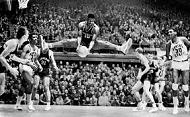






On Apr. 11, 1960 the 1960 NBA Draft sees eight teams select 100 players in 21 rounds; after the draft the Minneapolis Lakers relocate to Los Angeles, Calif. and become the Los Angeles Lakers; 6'5" guard-forward Oscar Palmer "the Big O" Robertson (1938-) of the U. of Cincinnati is selected #1 by the Cincinnati Royals (#14), moving to the Milwaukee Bucks (#1) in 1970-4; 6'2" guard-forward Jerry Alan "Gentleman" "Mr. Clutch" "The Logo" "Mr. Outside" "Zeke from Cabin Creek" West (1938-) of the U. of W. Va. is selected #2 by the Minneapolis Lakers (#44), becoming a member of the first five NBA All-Defensive Teams (1969-73), then retiring in 1974, returning as head coach of the Los Angeles Lakers in 1976-9; after playing on the 1960 men's Olympic basketball team in Rome, 6'10" center Darrall Tucker Imhoff (1938-) of the U. of Calif. (#40) is selected #3 by the New York Knicks (#18), proving a bust with poor shooting skills, getting demoted to backup center; in 1962 he is traded for Gene Shue to the Detroit Pistons (#17), who trade him in 1964 to the Los Angeles Lakers (#14), who trade him in 1968 for Wilt Chamberlain to the Philadelphia 76ers (#22), moving to the Cincinnati Royals (#30) in 1970-1, and the Portland Trail Blazers (#35) in 1971-2; 6'7" forward Lee Philip Shaffer II (1939-) of the U. of N.C. is selected #5 by the Syracuse Nationals (#22), playing until 1964; 6'1" guard Leonard Randolph "Lenny" Wilkens (1937-) of Providence College is selected #6 by the St. Louis Hawks (#32), moving to the Seattle SuperSonics (#15) in 1968-72, the Cleveland Cavaliers (#14) in 1972-4, and the Portland Trail Blazers (#19) in 1974-5, becoming the head coach of the Supersonics in 1977-85, Atlanta Hawks in 1993-2000, Toronto Raptors in 2000-3, and New York Knicks in 2004-5; in 1992 he is an asst. coach of the 1992 U.S. Olympic Dream Team; in 1994-2010 he becomes the winningest coach in NBA history (1,332 Vs) (until ?).






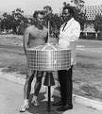



On Aug. 25-Sept. 11, 1960 the XVII (17th) Summer Olympic Games are held in Rome, Italy in the new Palazzo dello Sport (PalaLottomatica) (opened 1960) and Palazzetto dello Sport (Sports Palace) (opened 1957); 5,338 athletes from 83 nations compete in 150 events in 17 sports; the last appearance for South Africa until 1992; the Soviets win 15 of 16 medals in women's gymnastics; the Japanese men's gymnastics team wins the first of five successive golds (until 1976); future King Constantine II of Greece wins a gold in Dragon Class sailing; former polio patient "La Gazella" Wilma Rudolph (1940-94) becomes the first African-Am. to win three gold medals in a single Olympics (100m, 200m, 4 x 100m relay); barefoot Ethiopian Abebe Bikila (1932-73) wins the marathon, becoming the first black African to win a gold; dominating Herbert James "Herb" Elliott (1938-) of Australia wins the 1500m in 3 min. 35.6 sec.; the 100m men's freestyle swimming race is marred by officials who reverse the automatic timers and award the win to John Devitt (1937-) of Australia over Lance Melvin Larson (1940-) of the U.S., who receives a gold medal for the butterfly leg of the men's 4x100m medley relay along with Frank McKinney (backstroke), Paul Hait (breaststroke), and Jeff Farrell (freestyle), setting a world record of 4:05.4; Armin Hary (1937-) of West Germany (known for rumors of accepting cash under the table to wear Adidas and/or Puma shoes) wins the gold in the 100m with a time of 10.2 sec., becoming the first non-U.S. winner since Percy Williams of Canada in 1928; Rafer Lewis Johnson (1935-) of the U.S. defeats friend-rival "Iron Man of Asia" C.K. Yang (Yang Chuan-kwan) (1933-2007) of Taiwan in the decathlon; on Aug. 26 Danish cyclist Knud Enemark Jensen collapses then dies in the hospital (2nd Olympic athlete death since 1912), and amphetamines are found in his blood; on Sept. 5 Cassius Marcellus Clay Jr. (1942-) (later Muhammad Ali) wins a gold medal in light-heavyweight boxing, and returns to the U.S. to find he's still treated like an N-word, later throwing it in the Ohio River after being refused service at a Louisville diner while wearing it around his neck; the U.S. men's basketball team under U. of Calif. coach (1954-60) Peter Francis "Pete" Newell (1915-2008), incl. Oscar Robertson, Jerry Lucas, Jerry West, Walt Bellamy, Terry Dischinger, Bob Boozer, Adrian Smith, and Jay Arnette wins the gold, later being inducted into the basketball hall of fame; Pakistan becomes the first team to defeat India in men's field hockey since 1928 (six golds), winning its first gold - IOC, a family company?
On Nov. 4, 1960 Wilt Chamberlain of the Philadelphia Warriors sets an NBA record for most missed free throws with all 10 tries against Detroit; on Dec. 8, 2000 Shaquille O'Neal of the Los Angeles Lakers misses 11 against Seattle.
On Nov. 24, 1960 Wilt Chamberlain of the Philadelphia Warriors sets an NBA record (until ?) with 55 rebounds against the Boston Celtics.




On Mar. 27, 1961 the 1961 NBA Draft sees nine teams select 107 players in 15 rounds; after serving as the starting center on the 1960 Olympic men's basketball team in Rome, 6'11" center Walter Jones "Walt" Bellamy (1939-2013) of the U. of Ind. is selected #1 by the Chicago Packers (#8), going on to be named rookie of the year with 31.6 points per game avg. (2nd to Wilt Chamberlain's 37.6) and 19 rebounds per game (vs. 27 for Wilt Chamberlain and 19.6 for Bill Russell) before moving to the Baltimore Bullets (#8) in 1963-5, the New York Knicks (#8) in 1965-8, the Detroit Pistons (#8) in 1968-70, the Atlanta Hawks (#8) in 1970-4, and the New Orleans Jazz (#8) in 1974; 6'6" Harbin, Manchuria-born Russian immigrant forward (budding poet) Thomas Nicholas "Tom" Meschery (Tomislav Nikolayevich Meshcheryakov) (1938-) of Saint Mary's College (#31) is selected #7 by the Philadelphia Warriors (#14), leading the NBA in personal fouls in 1962, moving to the Seattle Supersonics (#14) in 1967-71; 6'3" forward Donald R. "Don" Kojis (1939-) of Marquette U. is selected #21 by the Chicago Packers, holding out to play for the Baltimore Bullets (#22) in 1963-4, followed by the Detroit Pistons (#16) in 1964-6, Chicago Bulls (#9) in 1966-7, San Diego Rockets (#44) in 1967-70, Seattle SuperSonics (#22) in 1970-2, and Kansas City-Omaha Kings (#21) in 1972-5; 6'6" power forward-center William C. "Bill" Bridges (1939-) of the U. of Kan. is selected #32 by the Chicago Packers, chosing to play for the ABL Kansas City Steers (#?) in 1961-3, setting an ABL record with 55 points on Dec. 9, 1962 before returning to the NBA to play for the St. Louis Hawks (#10) in 1963-71, averaging a double-double throughout his NBA career; in 1967-8 he sets an NBA record of 366 personal fouls.
On Apr. 2-11, 1961 the 1961 NBA Finals is won 4-3 by the Boston Celtics (coach Red Auerbach) over the St. Louis Hawks (coach Paul Seymour).
On Nov. 4, 1961 Wilt Chamberlain of Philadelphia begins his record streak of 65 straight games scoring 30+ points (until ?); in 1962 he has a 31-game streak.
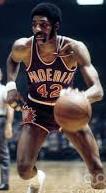
On Nov. 16, 1961 after being falsely accused of point shaving at the U. of Iowa in 1960, causing him to be blackballed from the NBA, 6'8" Brooklyn, N.Y.-born center-power forward Cornelius L. "Connie" "the Hawk" Hawkins (1942-) makes his prof. debut with the Pittsburgh Rens of the ABA with a 97-89 home loss to the Chicago Majors, and is named MVP in his only season before the league folds in 1963; in 1963-7 he plays for the Harlem Globetrotters; in 1966 he is officially banned from the NBA, causing him to file a $6M lawsuit against the NBA, which is settled in 1969 for $1.3M; in 1967-9 he plays for the Pittsburgh/Minn. Pipers of the ABA; in 1969 despite knee problems he is drafted by the new NBA Phoenix Suns (#42), leading them to the playoffs until the Los Angeles Lakers knock them out in a 7-game series; in 1973 he is traded to the Lakers, followed in 1975 by the Atlanta Hawks.
On Dec. 8, 1961 Wilt Chamberlin scores a record 78 points and makes 43 rebounds in a game against the Los Angeles Lakers.

In 1961 after inventing the full-court press and four corners offense at the N.C. College for Negroes (1941-52), Hampton Inst. (1953-4), and Tenn. State A&I U. (1955-9), Hiawatha, Kan.-born John B. McLendon Jr. (1915-99) becomes head coach of the ABL Cleveland Pipers basketball team (until 1962), becoming the first African-Am. head coach of a major sports team; in 1967 he becomes men's basketball coach at Kentucky State U., becoming the first African-Am. basketball coach of a predominantly white univ.; in 1969 he becomes head coach of the ABA Denver Rockets, but is fired after the team starts the season 9-19; the John McLendon Court at Tenn. State U. is later dedicated.

In 1961 Dean Edwards Smith (1931-2015) becomes head basketball coach at the U. of N.C. (until 1997), retiring with two nat. titles and a record 879 wins, which is not surpassed until 1997 by Bob Knight of Indiana U.
In 1961 the Chicago Packers become the first NBA expansion team; in 1962 they become the Chicago Zephyrs, followed in 1963 by the Baltimore Bullets, in 1973 by the Capital Bullets, in 1974 by the Washington Bullets, and in 1997 by the Washington Wizards.

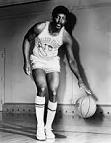
On Mar. 2, 1962 with 25 sec. left to play Wilton Norman "Wilt" "the Stilt" "the Big Dipper" "Goliath" "Mister 100" Chamberlain (1936-99) scores an NBA record (until ?) 100 points (36 field goals in 63 shots, 28 of 32 free throws) and breaks several NBA records incl. 28 free throws as the Philadelphia Warriors defeat the New York Knicks 169-147 in Hershey, Penn. before 4,124 fans; Knicks center Darrall Imhoff plays for 20 min., helping earn a demotion to backup center; 6'0" teammate Alvin Austin "Al" Attles Jr. (1936-) scores another 17 points; the game isn't televised or filmed, and the 100-point ball is lost; Chamberlain avgs. 50.4 pts. per game in the NBA's greatest offensive season so far (16th season), helping it to gain against the more established college game, and causing fellow NBA star Oscar Robertson to utter the soundbyte: "I believe Wilt Chamberlain single-handedly saved the league"; the Philadelphia Warriors move to San Francisco, Calif. and become the San Francisco Warriors, changing to the Golden State Warriors (AKA the Dubs) in 1971; Wilt Chamberlain (1960, 1966, 1967, 1968) and Stephen Curry (2015, 2016) go on to become NBA MVPs.

On Mar. 10, 1962 6'5" guard (#14) Oscar Palmer "the Big O" Robertson (1938-) of the Cincinnati Royals finishes the season with an avg. of 30.8 points, 12.5 rebounds, and 11.4 assists per game, becoming the first player to average a triple double over an NBA season (until ?).




On Mar. 26, 1962 the 1962 NBA Draft sees nine teams select 102 players in 16 rounds; 6'6" Detroit, Mich.-born forward David Albert "Dave" "Big D" DeBusschere (1940-2003) of Detroit U. is drafted as their territorial pick by the Detroit Pistons (#22), becoming a player-coach in 1964 (youngest coach in NBA history until ?); in 1969 he is traded to the New York Knicks, helping them defeat the Los Angeles Lakers in the 1970 and 1973 finals; 6'8" Middletown, Ohio-born rebounding expert Jerry Ray Lucas (1940-) of Ohio State U. drafted as their territorial pick by the Cincinnati Royals (#16), becoming their great white hope, boosting attendance throughout the 1960s, winning rookie of the year and going 55-25 his first season, defeating the Boston Celtics by 7-5 for the Eastern Div. title, going on to become known for scoring a 20-20 (20 points and 20 rebounds) and playing 44-46 min. per game despite bad knees; in 1971 he is traded to the San Francisco Warriors, followed by the New York Knicks in 1971-4; in 1973 the Knicks win the 1973 title, making Lucas the first U.S. basketball player to win championships at every level incl. h.s., college, Olympics, and prof.; 6'5" Martins Ferry, Ohio-born forward-guard John Joseph "Hondo" Havlicek (1940-) of Ohio State U. is drafted #7 by the Boston Celtics (#17), retiring in 1978 after scoring 26,395 points, averaging 29 points/game during the 19700-1 season, and revolutionizing the sixth man role and winning more NBA championships than any other players except teammates Bill Russell and Sam Jones; 6'6" Benton Harbor, Mich.-born forward Chester "Chet" "the Jet" Walker (1940-) of Bradley U. is drafted #12 by the Syracuse Nationals/Philadelphia 76ers (#25), becoming a starting forward on the 1966-7 team (best NBA team of all time) before being traded to the Chicago Bulls in 1969, retiring in 1975.




On Apr. 7-18, 1962 the 1962 NBA Finals sees the Boston Celtics (coach Red Auerbach) defeat the Los Angeles Lakers (coach Fred Schaus Elgin Gay Baylor (1934-) of the Los Angeles Lakers (inventor of modern offensive basketball?) scores 61 points and 22 rebounds against the Boston Celtics for a 126-121 win and a 3-2 series lead, becoming their first trip to the finals since moving to Calif.; on Apr. 18 in Game 7 after 6'3" Lakers guard Franklin Delano "Frank" Selvy (1932-) misses an 18-ft. baseline jumper that would have broken a 100-100 tie and given them the win, the Celtics come back 110-107 in OT to win the title, spurred by 30 points and 40 rebounds by 6'9 center William Felton "Bill" Russell (1934-2022); led by 6'2" guard "Gentleman" "Mr. Clutch" Jerry Alan West (1938-), the Lakers reach the finals 6x between this year and 1969, and lose 6x to the Boston Celtics, incl. all three game sevens (1962, 1966, 1969).
On Nov. 6, 1962 the U.S. issues a stamp honoring the 100th birthday of Canadian-born peach basket basketball inventor James Naismith (1861-1939).
On Apr. 14-24, 1963 the 1963 NBA Finals sees the Boston Celtics (coach Red Auerbach) defeat the Los Angeles Lakers (coach Fred Schaus) by 4-2.






On Apr. 30, 1963 after the Chicago Zephyrs relocate to Baltimore, Md., becoming the Baltimore Bullets, and the Syracuse Nationals (founded 1946) relocate to Philadelphia, Penn., becoming the Philadelphia 76ers, the 1963 NBA Draft sees nine teams select 84 players in 15 rounds, becoming the draft with the lowest number of non-territorial picks who debut with the NBA (17); on May 7 rounds 8-15 are held; 6'2" guard-forward Thomas Porter "Tom" Thacker (1939-) of the U. of Cincinnati is the territorial pick of the Cincinnati Royals (#25), moving to the Boston Celtics (#12) in 1967-8, and the ABA Indiana Pacers (#44) in 1968-71, becoming the first player to play on an NCAA championship team, an ABA championship team, and an NBA championship team; 6'5" guard-forward Arthur Bruce "Art" Heyman (1941-2012) of Duke U. is selected #1 by the New York Knicks (#4), his hot temper getting him moved to the Cincinnati Royals (#21) in 1965, and the Philadelphia 76ers (#35) in 1965-6, after which he moves to the ABA; 6'11" forward-center (San Francisco/Golden State Warriors #42, 1963-74) (Chicago Bulls #42, 1974-6) (Cleveland Cavaliers #42, 1976-7) Nathaniel "Nate the Great" Thurmond (1941-) of Bowling Green State U., known for his rebounding and shot blocking is selected #3 by the San Francisco Warriors (#42), moving to the Chicago Bulls (#42) in 1974-6, and the Cleveland Cavaliers (#42) in 1976-7; on Oct. 18, 1974 in his Chicago Bulls debut against the Atlanta Hawks he scores the NBA's first quadruple-double (22 points, 14 rebounds, 13 assists, and 12 blocked shots); 6'4" guard-forward ("the Man with the Golden Arm") Edward "Eddie" Miles Jr. (1940-) of the Seattle U. is selected #4 by the Detroit Pistons (#14), moving to the Baltimore Bullets (#15) in 1970-1, and the New York Knicks (#42) in 1971 before suffering an Achilles tendon injury that forces him to retire; 6'6" forward-center Gus "Honeycomb" Johnson (1938-87) of the U. of Idaho, known for his ability to dominate games and make slam dunks before Dr. J, and having a gold star drilled into a front tooth is selected #10 by the Baltimore Bullets (#25), moving to the Phoenix Suns in 1972 before switching to the ABA Indiana Pacers in 1972-3, shattering three backboards during his NBA career; in 1962 while at Idaho U. he visits the Corner Club Tavern in Moscow, Idaho and leaps to touch a spot on a beam 11'6" above the floor, which is marked with a ceremonial nail, which isn't equalled until 6'3" Joey Johnson does it in Jan. 1986; 6'2" guard James Staton "Jim" "Country" King (1941-) of the U. of Tulsa (#24) is selected #13 by the Los Angeles Lakers (#22), moving to the San Francisco Warriors (#21) in 1966-9, the Cincinnati Royals (#16) in 1969-70, and the Chicago Bulls (#21) in 1970-3.
On Apr. 26, 1964 after widening the foul lane from 12 ft. to 16 ft. the 1964 NBA Finals sees the Boston Celtics win a record 6th straight NBA basketball title, upping it to eight in 1965-6, longest in NBA history (until ?).






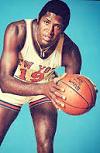




On May 4, 1964 the 1964 NBA Draft sees nine teams select 101 players in 15 rounds; after an undefeated 1963-4 season, the NCAA championship, AP's MVP award, and a Sports Illustrated cover featuring him with the headline "UCLA is the champ. Walt Hazzard drives through Duke", followed by a position on the 1964 gold medal U.S. Olympic basketball team, 6'2" guard Walter Ralphael "Walt" Hazzard Jr. (Mahdi Abdul-Rahman) (1942-2011) of UCLA (#42) is the territorial pick of the Los Angeles Lakers (#42), moving to the Seattle SuperSonics (#42) in 1967 before being traded for Lenny Wilkens to the Atlanta Hawks (#42) in 1968, then moving to the Buffalo Braves (#42) in 1971-2, and the Golden State Warriors (#1/#44) in 1972-3, becoming head coach of the UCLA men's basketball team in 1985-8; 6'8" center George Wilson (1942-) of the U. of Cincinnati is the territorial pick of the Cincinnati Royals (#17); 6'8" forward-center Velvet James "Jim" "Bad News" Barnes (1941-2002) of Texas Western U. is selected #1 by the New York Knicks (#22), moving to the Baltimore Bullets (#41) in 1965-6, the Los Angeles Lakers (#23) in 1966-8, the Chicago Bulls (#14) in 1968, Boston Celtics (#28) in 1968-70, and the Baltimore Bullets (#12) in 1970; 6'5" guard-forward Joe Louis "Pogo Joe" "Jumping Joe" Caldwell (1941-) of Ariz. State U., known for his tenacious defense is selected #2 by the Detroit Pistons (#21), switching to the St. Louis Hawks (#27) in 1965-70 before jumping to the ABA Carolina Cougars in 1970-5, becoming one of the few players to be an All-Star in the NBA and ABA; after leading the U.S. men's basketball team to a gold medal in the 1964 Olympics in Tokyo, 6'9" forward-center Lucious Brown "Luke" Jackson (1941-) of Pan Am. U. is selected #4 by the Philadelphia 76ers (#54), playing under the shadow of Wilt Chamberlain for eight seasons (until 1972); 6'4" guard-forward Jeffrey Vincent "Jeff" Mullins (1942-) of Duke U. (#44) is selected #5 by the St. Louis Hawks (#44), moving to the San Francisco Warriors (#23) in 1966-76, then becoming head coach of the U. of N.C. Charlotte 49ers in 1985-96; 6'10" forward-center Willis Reed Jr. (1942-) of Grambling State U. is selected #8 by the New York Knicks (#19), winning NBA rookie of the year in 1965, retiring in 1974 then returning as head coach in 1977-8, followed by the New Jersey Nets in 1987-9; 6'7" forward-center Paul Theron Silas (1943-) of Creighton U. (#35) (who averaged 20.6 rebounds per game in 1963, setting an NCAA record for most rebounds in three seasons) is selected #10 by the St. Louis Hawks (#29), moving to the Phoenix Suns (#12) in 1969-72, the Boston Celtics (#35) in 1972-6, the Denver Nuggets (#36) in 1976-7, and the Seattle SuperSonics (#35) in 1977-8, retiring with 10K points and 10K rebounds, then becoming head coach of the San Diego Clippers in 1980-3, followed by the Charlotte Hornets in 1999-2003, the Cleveland Cavaliers in 2003-5, and the Charlotte Bobcats in 2010-12; 6'5" forward-guard Gerald Eugene "Jerry" Sloan (1942-2020) Evansville U. is selected #19 by the Baltimore Bullets, sitting out the season to stay in college, then being selected #4 in 1965 by the Baltimore Bullets (#14), who trade him after one season to the new Chicago Bulls (#4), becoming "the Original Bull", known for his tenacious defense, leading them to the playoffs in their first season, and to their first and only division title before the Michael Jordan era; after a series of knee injuries, he retires in 1976 and becomes head coach of the Bulls in 1979-82, and head coach of the Utah Jazz in 1988-2011.


On Oct. 10-24, 1964 the XVIII (18th) Summer Olympic Games are held in Tokyo, Japan, the first to be held in Asia; 6'9" power forward Lucious Brown "Luke" Jackson (1941-) leads the U.S. basketball team to a 14-point V against the Soviet Union, going on to play for the Philadelphia 76ers in 1964-72 under the shadow of Wilt Chamberlain; William Warren "Bill" Bradley (1943-) plays on the basketball team, followed by the 1965 NCAA Final Four, then the New York Knicks, becoming a U.S. Dem. Sen. from N.J. in 1979-97.
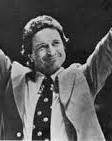
In 1964 New York City-born Alfred James "Al" McGuire (1928-2001) becomes head coach of the Marquette U. men's basketball team, coaching them to the 1970 NIT championship, followed by a Final Four appearance in 1974, where he becomes the first coach to be ejected from a championship game, followed by the NCAA basketball championship in 1977, then retiring, becoming a popular CBS-TV and NBC-TV college basketball commentator, increasing the sport's popularity; he and his brother Dick McGuire become the only pair of brothers to be inducted into the basketball hall of fame.

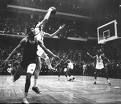
On Apr. 15, 1965 the 1965 Eastern Conference Finals Game 7 in Boston sees the visiting Philadelphia 76ers down by one point with 5 sec. left in the game, and after 76ers center Wilt Chamberlain is covered by Bill Russell, an inbound pass meant for star 76ers forward Chet Walker is deflected by Boston player (#17) John Joseph "Hondo" Havlicek (1940-) to teammate Samuel "Sam" "the Shooter" Jones (1933-) (#24), who dribbles out the clock, causing Celtics broadcaster John M. "Johnny" Most (1923-93) to yell "Havlicek steals it... Havlicek stole the ball!", becoming one of the most famous calls in sports history - good day to steal, on U.S. Income Tax Day?
On Apr. 18-25, 1965 the 1965 NBA Finals see the Boston Celtics (coach Red Auerbach) defeat the Los Angeles Lakers (coach Fred Schaus) by 4-1.



On May 6, 1965 the 1965 NBA Draft sees nine teams select 112 players in 17 rounds; since New York City is 1 mi. closer to Princeton U. than Philadelphia, the New York Knicks use their territorial pick to select 6'5" Crystal City, Mo.-born "White Oscar Robertson" William Warren "Bill" Bradley (1943-) (#24) (known for his ability to make baskets while turning his back to it), a top star at Princeton U. who set Ivy league records for points and free throws, played in the 1964 Olympics, became the first basketball player to win the James E. Sullivan Award for top amateur athlete in 1965, then becomes a Rhodes scholar and plays 1 year of pro basketball in Italy, followed by 6 mo. in the Air Force Reserve before joining the Knicks in Dec. 1967; he goes on to play for the Knicks for 10 seasons, retiring in 1977 to run for office, becoming U.S. Sen. (D-N.J.) in 1979-97; 6'7" Elizabeth, N.J.-born "Miami Greyhound" Richard Francis Dennis "Rick" Barry III (1944-) is selected #2 by the San Francisco Warriors (#24), going on to play for the ABA Oakland Oaks/Washington Caps in 1968-70 and the ABA New York Nets in 1970-2 before returning to the Warriors in 1972-8, becoming the first player to lead the NCAA, ABA, and NBA in season scoring, with an all-league record 30.5 points per game; Brooklyn, N.Y.-born 6'7" forward-center William John "Billy" "the Kangaroo Kid" Cunningham (1943-) of the U. of North Carolina is drafted #5 by the Philadelphia 76ers (#32), leaving in 1972 to join the ABA Carolina Cougars in 1972-4 before returning in 1974-6 then becoming the head coach in 1977-85, building a team incl. Bobby Jones, Maurice Cheeks, Andrew Toney, Moses Malone, and Julius Erving, leading them to the playoffs every year and to the finals 3x (1980-2), all against the Los Angeles Lakers.

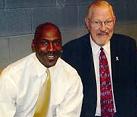
On Nov. 4, 1965 after playing for the Syracuse Nationals/Philadelphia 76ers in 1954-65, 6'9" Chicago, Ill.-born John Graham "Johnny" "Red" Kerr (1932-2009) (#43) of the Baltimore Bullets plays in his last of a record 844 consecutive games (12 seasons) in a 108-7 loss to New York; it takes until 1983 for Randy Smith to pass him; in 1975 after coaching the Chicago Bulls in 1966-8, he becomes a TV commentator for the Bulls (until 2008), overseeing the six Bulls championships in the 1990s along with Michael Jordan's entire career, with Jordan developing a ritual of clapping talcum powder in front of him before each game to mess up his nice suit.
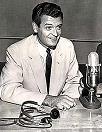
On Nov. 21, 1965 Francis Dayle "Chick" Hearn (1916-2002), announcer since Mar. 1961 for the Los Angeles Lakers begins a streak of 3,338 consecutive games (until Game 4 of the 2002 NBA Finals), starting the tradition of estimating the distance of shots taken, and becoming known for "Chickisms" incl. "air ball", "slam dunk" (instead of dunk shot), "triple-double", "bunny hop in the pea patch" (traveling), and "charity stripe".
On Jan. 26, 1966 the Chicago Bulls becomes Chicago's 3rd NBA team.



On Mar. 19, 1966 the 1966 NCAA Men's Div. 1 Basketball Championship sees the 27-1 Texas Western Miners under head coach (1961-99) Donald Lee "the Bear" Haskins (1930-2008) use all black starters to defeat the top-ranked "white bread" 28-0 U. of Kentucky Wildcats under head coach (1930-72) Adolph Frederick Rupp (1901-77) by 72-65, breaking the college basketball color line in the South, with the soundbyte: "I just wanted to put my five best guys on the court... I just wanted to win that game"; after the Southern backlash, led by Rupp, who calls the blacks quasi-prof. street thugs imported from the North to win the title, Haskins comments: "I wished for a long time that we had never won that game with Kentucky because life would have been a heck of a lot easier for me, my school and my players"; future coach Pat Riley plays for Ky.; since the Texas players use slam dunks, the NCAA outlaws them next year (until 1977); Rupp retires in 1972 after 42 years, with 24 SE Conference titles and four NCAA titles; in 2006 Disney releases the film "Glory Road" about the game.
On Apr. 17-28, 1966 the 1966 NBA Finals is won 4-3 by the Boston Celtics (8th in a row) (coach Red Auerbach) over the Los Angeles Lakers (coach Fred Schaus).


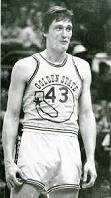
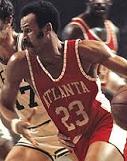
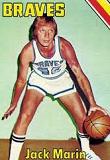
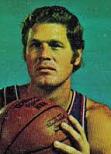
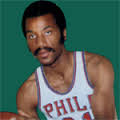
On May 11-12, 1966 after the NBA introduces a coin flip between the worst two teams to decide who picks #1, the 1966 NBA Draft sees 10 teams select 112 players in 19 rounds; 6'5" guard Cazzie Lee Russell (1944-) of the U. of Mich. (#33) is selected #1 by the New York Knicks (#14/#33), moving to the Golden State Warriors (#32) in 1972-74, and the Los Angeles Lakers (#33/#32)in 1974-8, becoming their last player to wear #32 prior to Magic Johnson; 6'3" guard David "Dave" Bing (1943-) of Syracuse U. (#22) is selected #2 by the Detroit Pistons (#21), winning NBA rookie of the year, then leading the NBA with 2,142 points in the 1967-8 season; he goes on to move to the Washington Bullets (#21) in 1976-7, and the Boston Celtics (#44) in 1977-8; after retiring in 1978, he becomes Dem. mayor #24 of Detroit, Mich. in 2009-13; 6'10" center-forward Clyde Wayne Lee (1944-) of Vanderbilt U. (#43) is selected #3 by the San Francisco Warriors (#43), moving to the Atlanta Hawks (#43) in 1974, and the Philadelphia 76ers (#34) in 1974-6; 6'5" guard-forward Louis Clyde "Sweet Lou" Hudson (1944-2014) of the U. of Minn. (#14) is selected #4 by the St. Louis Hawks (#23), moving to the Los Angeles Lakers (#23) in 1978-9; 6'7" forward-guard John Warren "Jack" Marin (1944-) of Duke U. is selected #5 by the Baltimore Bullets (#15/#24), leading the NBA in free throw percentage in the 1971-2 season before being traded to the Houston Rockets (#24) in 1973 in exchange for Elvin Hayes, moving to the Buffalo Braves (#42) in 1974-5, and the Chicago Bulls (#24) in 1975-7 before retiring to enter law school; 6'9" forward-center John William Block Jr. (1944-) of USC is selected #27 by the Los Angeles Lakers (#34); moving to the San Diego Rockets (#34) in 1967-71, followed by several teams ending with the Chicago Bulls (#35) in 1974-6; 6'2" guard Archie L. Clark (1941-) of the U. of Minn., known for his Shake and Bake crossover dribble is selected #37 by the Los Angeles Lakers (#21), moving to the Philadelphia 76ers (#21) in 1968-71, the Baltimore Bullets (#21) in 1971-4, the Seattle SuperSonics (#21) in 1974-5, and the Detroit Pistons (#11) in 1975-6, going on to co-found the Nat. Basketball Retired Players Assoc. in 1992.
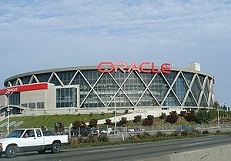
On Nov. 9, 1966 the $25M Oakland-Alameda County Coliseum Arena in Oakland, Calif. opens as the home of the NBA Golden State Warriors and WHL Calif. Seals; in 1996-7 it is renovated at a cost of $121M, expanding seating from 15K to 19,596; in Oct. 2006 it becomes Oracle Arena (The O), AKA the Roaracle because of the super-high-level crowd noise.
In 1966 after a test game in Sao Paulo in 1965 is won 118-109 by the Corinthians of the South Am. League over the Real Madrid team of the Euroleague, the FIBA Internat. Cup (FIBA Club World Cup) is founded by FIBA as an amateur basketball world championship; the Akron Wingfoots of the U.S. win the cup in 1967, 1968, and 1969 against Spartak Brno, Ignis Varese, and Real Madrid; in 1973 the cup adds the name William Jones after the FIBA secy.-gen.; in 1987 it is succeeded by the McDonald's Championship.
On Feb. 1, 1967 after promising new owners that a future merger with the NBA will double their investments, the Am. Basketball Assoc. (ABA) is founded, with George Miken as pres. #1, playing their first game on Oct. 13, with the Oakland Oaks defeating the Anaheim Amigos by 134-129; the 11 original teams incl. the Anaheim Amigos, Dallas Chaparrals, Houston Mavericks, Indiana Pacers, Denver Larks/Rockets, Kentucky Colonels, Minnesota Muskies, New Orleans Buccaneers, Oakland Americans/Oaks, and Pittsburgh Pipers; the ABA goes on to experiment with new ideas to make the game more flashy incl. red-white-blue basketballs, a slam-dunk contest, 30-sec. (vs. 24 in the NBA) shot clock, and the 3-point shot, growing to 11 teams; in 1976 they merge with the NBA, with all teams except the New York Nets, Denver Nuggets, Indiana Pacers, and San Antonio Spurs disbanding; the NBA doesn't adopt the 3-pointer until 1979, the rookie season of Larry Bird and Magic Johnson.
On Apr. 14-24, 1967 after the Philadelphia 76ers defeat the Boston Celtics, ending their 11-straight-year appearance in the finals, the 1967 NBA Finals sees the 68-13 Philadelphia 76ers (coach Alex Hannum) (greatest NBA team of all time), featuring center Wilt Chamberlain, guards Hall Greer and Wali Jones, forward Chet Walker, and sixth man Billy Cunningham defeat the San Francisco Warriors (coach Bill Sharman) by 4-2.


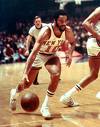


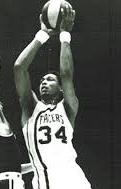
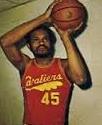
On May 3, 1967 the 1967 NBA Draft sees 12 teams select 162 players in 20 rounds; on May 4 the 12th and remaining rounds are held; 6'3" guard James "Jimmy" Walker (1944-2007) of Providence College (#24) is selected #1 by the Detroit Pistons (#24), moving to the Houston Rockets (#11) in 1972-3, and the Kansas City-Omaha Kings (#24) in 1973-6; 6'3" guard Vernon Earl "the Pearl" Monroe (1944-) of Winston-Salem State U. (known for his flowing silky style, nicknamed Thomas Edison in h.s. for his inventiveness on the court) is selected #2 by the Baltimore Bullets (#10), teaming with Wes Unseld and winning rookie of the year after averaging 24.3 points per game and scoring a Bullets record 56 points in a game against the Los Angeles Lakers (broken on Dec. 17, 2006 by Gilbert Arenas), and scoring an NBA record 13 points in 1 OT in a double-OT V over the Detroit Pistons on Feb. 6, 1970 before moving to the New York Knicks (#15) in 1971-80, where he teams with Walt Frazier, becoming known as the Rolls Royce Backcourt; Sonny Dove of St. John's U. is selected #4 by the Detroit Pistons after they acquire a first round pick from the Los Angeles Lakers on Feb. 17 when Rudy LaRusso refuses to report after a 3-team trade on Jan. 16; 6'4" point guard Walter "Walt" "Clyde" Frazier (1945-) (nicknamed for his hat that resembles Warren Beatty's in the 1967 film "Bonnie and Clyde") of Southern Ill. U. (#52) is selected #5 by the New York Knicks (#10), moving to the Cleveland Cavaliers (#11) in 1977-80; 6'4" guard-forward Patrick James "Pat" Riley (1945-) of the U. of Ky. is selected #7 by the San Diego Rockets (#42), moving to the Los Angeles Lakers (#12) in 1970-5, and the Phoenix Suns (#12) in 1975-6, then becoming head coach of the Los Angeles Lakers in 1981-90, followed by the New York Knicks in 1991-5, and the Miami Heat in 1995-2003, winning five championships and being named NBA coach of the year in 1989-90, 1992-3, and 1996-7; 6'9" center Melvin Joe "Mel" Daniels (1944-) of the U. of N.M. is selected #9 by the Cincinnati Royals, electing to play for the ABA Minnesota Muskies (#34) in 1967-8, winning rookie of the year, followed by the ABA Indiana Pacers (#34) in 1968-74, becoming MVP in 1969 and 1971, and the ABA Memphis Sounds (#34) in 1974-5 before returning to the NBA to play for the New York Nets (#34) in 1976, after which he becomes head coach of the Indiana Pacers in 1988; 6'9" forward-center Bobby Frank "Bob" Rule (1944-) of Colo. State U. is selected #19 by the Seattle SuperSonics (#45), scoring a team record 47 points in his rookie season against the Los Angeles Lakers and averaging 9.5 rebounds per game, setting a record 18.1 points per game average that takes Kevin Durant to break in 2007, getting better each season, averaging 29.8 points and 11.5 rebounds per game in the 1970-1 season until he tears his Achilles tendon, moving to the Philadelphia 76ers (#45) in 1971-2, the Cleveland Cavaliers (#45) in 1972-3, and the Milwaukee Bucks (#21) in 1974.
On Nov. 13, 1967 Jerry Harkness sinks the first 3-pointer in ABA history from 92 ft. to give the Indiana Pacers a 119-118 V over the Dallas Chaparrals; since the audience isn't used to the new rule, they think it's a tie.
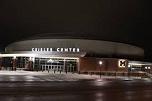
On Dec. 6, 1967 $7.2M Crisler Center in Ann Arbor, Mich. (begun Sept. 18, 1965) opens as the home of the U. of Mich. basketball team, becoming known as "the House that Cazzie Built" after 1966 College Basketball Player of the Year Cazzie Russell.
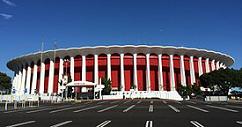
On Dec. 30, 1967 the circular $16M The (Fabulous) (L.A.) Forum multipurpose indoor arena in Inglewood, Calif. (3 mi. E of Los Angeles Internat. Airport) opens, becoming the West Coast equal to New York City's Madison Square Garden, and home to the NBA Los Angeles Lakers and NHL Los Angeles Kings; in Dec. 1988 it becomes the Great Western Forum.



In 1967 the San Diego Rockets NBA team is founded, nicknamed after the Atlas missile of Gen. Dynamics Corp., with Jack McMahon as coach #1; the first draft pick is Pat Riley; too bad, they lose a record 70 games their first (1967-8) season; in the 1968 draft they draft 6'9" Elvin Ernest Hayes (1945-) of the U. of Houston (#44), who leads them to their first playoff appearance in 1969, losing the semi-finals to the Atlanta Hawks by 4-2; in 1970 they draft 5'9" expert baton twirler Calvin Jerome Murphy (1948-) (#23) and 6'8" forward Rudolph "Rudy T." Tomjanovich Jr. (1948-) (#45); in 1971 they move to Houston as the Houston Rocket, becoming the first NBA team in Tex., and a perfect match with the Rockets name.

In 1967 the Seattle SuperSonics (Sonics) NBA team is founded, named after Boeing's SST Project (later cancelled), with Al Bianchi as coach #1, drafting Walt Hazzard, Bob Rule, and Al Tucker, going on to lose their first game 114-116, and finish the 1967-8 season with a 23-59 record; in 1968 they trade Hazzard for 6'1" St. Louis Hawks star Leonard Randolph "Lenny" Wilkens (1937-) (#19), who becomes player-coach in 1969-72; in June 1970 they join the ABA; in 1975 new coach Bill Russell leads them to their first playoffs; after the 2007-8 season they relocate to Oklahoma City, Okla. as the Oklahoma City Thunder.
In the 1967-8 season Wilt Chamberlain astounds the NBA by deciding to lead in assists instead of scoring to demonstrate his mastery of basketball and silence critics who call him 1-dimensional or selfish, leading the league with 702, becoming the first center to lead the league in assists (until ?).
In 1967 the Aurora Larks (Rockets) ABA team is founded, changing its name to the Denver Nuggets for the 1974 ABA-NBA merger after losing the last ABA championship to the New York Nets.
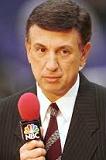
In 1967 Brooklyn, N.Y.-born former ball boy Marv Albert (Marvin Philip Aufrichtig) (1941-) becomes the voice of the New York Knicks (until 2004), becoming known as "the voice of the New York Knicks", becoming the NBA's lead play-by-play broadcaster on NBC-TV in 1990-2002, calling every NBA Finals except 1998-2000, when Bob Costas takes over because of his arrest for sexual assault.
In 1967 the Commission on Intercollegiate Athletics for Woman is founded to govern U.S. women's athletics and conduct nat. championships; in 1971 it becomes the Assoc. for Intercollegiate Athletics for Women (AIAW).
On Jan. 20, 1968 the Houston Cougars defeat the UCLA Bruins 71-69 after 7'2" center Lew Alcindor (later Kareem Abdul-Jabbar) only scores 15 points due to a left corneal injury; he gets so good at it that the dunk shot is banned in college basketball, and not relegalized until 1977.
On Jan. 22, 1968 the NBA awards two expansion team franchises; the Milwaukee Bucks is formed, playing their first NBA regular season game against the Chicago Bulls before a Milwaukee Arena crowd of 8,467; their first V is in game #6, defeating the Detroit Pistons by 134-118; the Phoenix Suns is formed, becoming the first major prof. sports team in Ariz. until the Phoenix Cardinals in 1988; the team name is picked from 28K entries in a contest sponsored by the Arizona Republic; after both teams tie for last, they flip a coin to see who gets the first pick in the 1969 draft, and the Bucks pick Lew Alcindor of UCLA, then have to win a bidding war with the ABA to keep him.


On Apr. 3, 1968 the 1968 NBA Draft sees 14 teams select 214 players in 21 rounds; on May 8 and 10 the 2nd and remaining rounds are held; 6'9" Rayville, La.-born center-forward Elvin Ernest Hayes (1945-) of the U. of Houston is selected #1 by the San Diego Rockets (#44); Louisville, Ky.-born 6'7" center Westley Sissel "Wes" Unseld (1946-) of the U. of Louisville is selected #2 by the Baltimore Bullets (#41), winning rookie of the year and MVP in his first season (2nd player after Wilt Chamberlain in 1960), going on to spend his entire career with them (until 1981), becoming vice-pres. for six years before becoming their head coach in 1987-94.
On Apr. 21-May 2, 1968 the 1968 NBA Finals (first in May) sees the Boston Celtics (coach Bill Russell) defeat the Los Angeles Lakers (coach Butch van Breda Kolff) by 4-2.

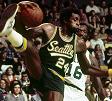
On Oct. 12-27, 1968 the XIX (19th) Summer Olympic Games in 7,349-ft. alt. Mexico City sees the U.S. win a gold medal in basketball; 7'2" UCLA Bruins center Kareem Abdul-Jabbar (Ferdinand Lewis "Lew" Alcindor Jr.) (1947-) boycotts the Olympics; in 1969 after he joins the Milwaukee Bucks and makes too much use of them, scaring other teams, the slam dunk is made illegal in the NBA (until 1976); in 1969 leading scorer (16.1 points per game, .719 field goal percentage) 6'8" forward-center Spencer Haywood (1949-) of the U. of Detroit (sophomore) signs with the ABA Denver Rockets (#24) in 1969, being named rookie of the year, league MVP (youngest), and 1970 All-Star Game MVP, then with the help of owner Sam Schulman signs with the Seattle SuperSonics (#24) in 1970, becoming the first player to sign with the NBA without graduating from college, getting into a war with NBA commissioner Walter Kennedy that results in the anti-trust lawsuit Haywood v. National Basketball Association, which goes to the U.S. Supreme Court, which rules 7-2 on Mar. 1, 1971 (the Spencer Haywood Rule) that Haywood doesn't have to wait four years after graduating from college because he is a "hardship" case, needing to work to feed his family, after which he is loudly booed by Supersonics fans for years before moving to the New York Knicks (#42) in 1975-9, the New Orleans Jazz (#24) in 1979, the Los Angeles Lakers (#31) in 1979-80, Reyer Venezia in Italy in 1980-1, and the Washington Bullets (#24) in 1981-3; in the 1971 NBA Draft he officially becomes eligible is and selected #30 by the Buffalo Braves, who can't get him to leave Seattle.

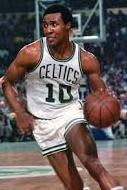




On Apr. 7, 1969 the 1969 NBA Draft sees 14 teams select 218 players in 20 rounds; on May 7 the 3rd and remaining rounds are held; 7'2" center Kareem (Arab. "the noble one, servant of the Almighty") Abdul-Jabbar (Ferdinand Lewis "Lew" Alcindor Jr.) (1947-) of UCLA, known for his skyhook shot is selected #1 by the Milwaukee Bucks (#33), winning the NBA rookie of the year award, moving to the Los Angeles Lakers (#33) in 1975-89; in 1971 he converts to Islam; 6'3" point guard Joseph Henry "Jo Jo" White (1946-) of the U. of Kansas is selected #9 by the Boston Celtics (#10), moving to the Golden State Warriors (#12) in 1979-80, and the Kansas City Kings (#10) in 1980-1; 6'3" guard Alfred "Butch" Beard Jr. (1947-) of the U. of Louisville (1965 Ky. Mr. Basketball) is selected #10 by the Atlanta Hawks (#14), moving to the Cleveland Cavaliers (#21) in 1970-1 and 1975, the Seattle SuperSonics (#21) in 1971-2, the Golden State Warriors (#21) in 1973-5, and the New York Knicks (#9) in 1975-9; in 1994 he becomes head coach of the New Jersey Nets (until 1996); 6'1" point guard Norman Allen "Norm" "Stormin' Norman" Van Lier III (1947-2009) of Saint Francis U. is selected #34 by the Chicago Bulls, who trade him to the Cincinnati Royals (#23), leading the NBA in assists in 1971, after which he is traded back to the Chicago Bulls (#2) in 1971, moving to the Milwaukee Bucks (#4) in 1978-79; in 1977 he sets a record for longest field goal in NBA history (84 ft.), which isn't broken until Nov. 17, 2001 by Baron Davis (89 ft.); 6'6" forward-guard Robert L. "Bob" Dandridge (1947-) of Norfolk State U. is selected #45 by the Milwaukee Bucks (#3), moving to the Washington Bullets (#10) in 1977-81, forming the front court with Elvin Hayes and Wes Unseld and winning the 1978 NBA championship, then moving back to the Bucks in 1981; 6'7" power forward Steven Charles "Steve" "the Mayor" Mix (1947-) of the U. of Toledo (#50) is selected #61 by the Detroit Pistons (#23), playing for the ABA Denver Rockets (#50) in 1971, followed by the Philadelphia 76ers (#50/#23) in 1973-82, the Milwaukee Bucks (#50) in 1982-3, and a year warming the bench for the Los Angeles Lakers (#50) in 1983.

On Apr. 23-May 5, 1969 the 1969 NBA Finals is won by the Boston Celtics (coach Bill Russell) by 4-3 over the Los Angeles Lakers (coach Butch van Breda Kolff), last of 11 finals wins in 13 seasons; Russell accuses Wilt Chamberlain of the Lakers of "copping out" in Game 7, causing them to go from being good friends to not talking to each other for over 20 years; 6'2" "Mr. Clutch" Lakers guard Jerry Alan West (1938-) becomes the first player to become MVP, and first from a losing team (until ?), scoring 42 points, 13 rebounds, and 12 assists in a 108-106 Game 7 loss to the Boston Celtics; his profile is used on the NBA Logo.
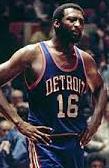
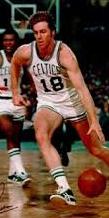


On Mar. 23, 1970 the 1970 NBA Draft sees 17 teams select 239 players in 19 rounds; 6'11" center Robert Jerry "Bob" Lanier Jr. (1948-) is selected #1 by the Detroit Pistons (#16); in 1980 he is traded to the Milwaukee Bucks, leading them to div. championships each year until he retires in 1984; Newport, Ky.-born 6'9" center-forward David William "Dave" Cowens (1948-) of Fla. State U. is selected #4 by the Boston Celtics (#18) (until 1980), going on to lead his team in all five major statistical categories in the 1977-8 season; 6'1" point guard Nathaniel "Nate" "Tiny" Archibald (1948-) is drafted #19 by the Cincinnati Royals (#10), going on to lead the NBA in scoring and assists in the 1972-3 season for the first time (until ?), and setting a record of 910 assists; Atlanta Hawks mgr. (since 1954) ("Godfather of the NBA Draft") Marty Blake (1927-2013) (known for discovering players at smaller colleges incl. Dennis Rodman, Scottie Pippen, Tim Hardaway, Karl Malone, and Joe Dumars) drafts Manuel Raga "Manolo" "the Flying Mexican" Navarro (1944-) of Mexico in the 10th round (167th overall), and 6'9" Dino Meneghin (1950-) of Italy in the 11th round (182nd overall), becoming the first NBA gen. mgr. to select a player from a foreign league; neither player ends up signing.


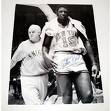
On Apr. 24-May 8, 1970 the 1970 NBA Finals (9th in a row featuring a losing Calif. team) sees the New York Knickerbockers (Knicks) (founded 1946), coached (1967-82) by William "Red" Holzman (1920-98) defeat the Los Angeles Lakers (coach Joe Mullaney) by 4-3 (first win); after starting Game 7 in Madison Square Garden with a severe thigh injury, with ABC-TV announcer Jack Twyman uttering the soundbyte "I think we see Willis coming out" as he walks down the tunnel to the court, spurring his team incl. Walter "Walt" Frazier (1945-) to win by 113-99 (later voted the greatest moment in Madison Square Garden history), center Willis Reed Jr. (1942-) becomes the first player in NBA history to be named all-star game MVP, regular season MVP, and playoff MVP in the same season (until ?).
On Nov. 6, 1970 Charlie Hentz shatters two backboards in the same ABA game, causing it to be cancelled.


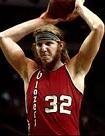
In the 1970-1 season the NBA expands to 17 teams; the Buffalo Braves is founded, with Dolph Schayes as head coach #1, drafting Bob Kaufmann and Don May after passing on hometown hero Calvin Murphy, finishing 22-60; the Cleveland Cavaliers is founded, with the name selected via a competition sponsored by the Cleveland Plain Dealer, with Bill Fitch as head coach #1, drafting 6'4" Austin George "Mr. Cavalier" Carr (1948-) (#34), who injures his leg and doesn't do diddly the first season, finishing at the bottom of the league at 15-67; in 1974 they move to Richfield Coliseum 30 mi. S of Cleveland; the Portland Trail Blazers is founded, with Rolland Todd as head coach #1, going on to take seven years to make the playoffs, drafting LaRue Martin (1950-) (#35) in 1972 ahead of Julius Erving and Bob McAdoo after he outplays Bill Walton of UCLA in a single college game) (worst draft pick in NBA history?), and 6'11" center William Theodore "Bill" "Big Redhead" Walton III (1952-) (#32) in 1974, who wins two NBA championships before foot injuries tank his career.




On Mar. 29, 1971 the 1971 NBA Draft sees 17 teams select 237 players in 19 rounds; on Mar. 30 the 11th and remaining rounds are held; after scoring over 1K points in a season, incl. 61 points vs. the U. of Ohio in 1970, and compiling an avg. of 50 points per game in seven NCAA playoff games, 6'4" guard Austin George Carr (1948-) of the U. of Notre Dame (#34) is selected #1 by the Cleveland Cavaliers (#22/#34), suffering from foot injuries in his rookie season, then teaming with Lenny Wilkens until a knee injury 2 mo. into the 1974-5 season sidelines him again, after which he flourishes, leading the team to three straight playoff appearances, becoming known as "Mr. Cavalier"; after playing on three straight NCAA championship teams and winning MVP in 1970, 6'8" forward-center Sidney Wicks (1949-) of UCLA (#35) is selected #2 by the Portland Trail Blazers (#21) after they pay the Cleveland Cavaliers $250K to pass on him, winning the NBA rookie of the year award, averaging 20+ points and 10+ rebounds per game in 1971-2, 1972-3, and 1974-5 while seeing his scoring avg. drop every year until he is sold to the Boston Celtics (#12) in 1976 a year before Portland wins their first NBA championship, finishing his career with the San Diego Clippers (#21) in 1978-81; 6'3" guard Fred "Downtown Freddie" Brown (1948-) of the U. of Iowa, known for his outside shooting is selected #6 by the Seattle SuperSonics (#32), playing his entire career with them (until 1984), leading the NBA in 3-point shooting percentage in 1979-80, the season that the 3-point line was adopted; in the 1977-8 season after a slow start, Lenny Wilkens takes over as head coach, pairing Gus Williams and Dennis Johnson in the back court and bringing Brown off the bench, calling him "Instant Offense", after which they make the finals two seasons in a row, winning win the NBA championship in 1978-9; 6'7" forward Curtis Rowe Jr. (1949-) of UCLA (#30) is selected #11 by the Detroit Pistons (#18), moving to the Boston Celtics (#41) in 1976-9.

On Apr. 21-30, 1971 the 1971 NBA Finals sees the 3rd-year Milwaukee Bucks (coach Larry Costello) defeat the Baltimore Bullets (coach Gene Shue) by 4-0; on Apr. 28 (Game 3) 6'6" small forward-guard Robert L. "Bob" Dandridge (1947-) (#10) of the Bucks scores 29 points; MVP Lew Alcindor scores 27 points.
On Jan. 7, 1972 the Los Angeles Lakers defeat the Atlanta Hawks by 134-90 for an NBA record 33 straight wins, finishing the regular season 69-13, setting a record not broken until the Chicago Bulls go 72-10 in 1995-6; on Apr. 26-May 7, 1972 the 1971 NBA Finals sees the Lakers defeat the New York Knicks 4-1, their first NBA title since moving from Minneapolis, giving a total of 81 regular season and playoff wins, setting a record not broken until the Boston Celtics do it in 1986; the Lakers' Super Six incl. Jim McMillan, Flynn Robinson, Pat Riley, Harold "Happy" Hairston, Leroy Ellis, and Keith Erickson later appear on the episode The Most Crucial Game of Columbo that airs on Nov. 5.
On Jan. 18, 1972 the Pro Basketball Writers Assoc. is founded at a meeting of sportswriters at the Century Plaza Hotel in Los Angeles, Calif. during the NBA All-Star Game weekend to formulate policy regarding access to locker rooms, players, and execs, formally organizing on Jan. 23, 1973 at a meeting at the O'Hare Hyatt Regency Hotel in Chicago, Ill.; pres. #1 is Joe Gilmartin of the Phoenix Gazette (until 1974); pres. #6 (1982-3) is Bob Ryan of the Boston Globe; pres. #7 (1983-5) is Fran Blinebury of the Houston Chronicle.

On Feb. 5, 1972 Saint Kitts, West Indies-born Robert L. "Bob" Douglas (1882-1979), "the Father of Black Professional Basketball" becomes the first African-Am. elected to the Basketball Hall of Fame; he is inducted on Apr. 20.






On Apr. 10, 1972 the 1972 NBA Draft sees 17 teams select 198 players in 18 rounds; on Apr. 15 the 11th and remaining rounds are held; after he outplays Bill Walton in a game against UCLA in the 1971-2 season, 6'11" center LaRue Martin (1950-) of Loyola U. is selected #1 by the Portland Trail Blazers (#35), going on to be plagued with injuries and bomb out in the NBA, averaging 5.3 points and 4.6 rebounds per game and totalling 1.4K points in four years before retiring in 1976 one year before the Blazers win their first NBA championship in 1977; 6'9" center-forward Robert Allen "Bob" McAdoo (1951-) of the U. of N.C. (junior) (#35) is selected #2 by the Buffalo Braves (#11), moving to the New York Knicks (#21) in 1976-9, the Boston Celtics (#11) in 1979, the Detroit Pistons (#11) in 1979-81, the New Jersey Nets (#11) in 1981, the Los Angeles Lakers (#11) in 1981, and the Philadelphia 76ers (#11) in 1986, after which he plays in Italy, becoming a big star, retiring and becoming an asst. coach for the Miami Heat in 1995 (until ?); 6'4" guard Paul Douglas Westphal (1950-) of USC is selected #10 by the Boston Celtics (#44), moving to the Phoenix Suns (#44) in 1975-80, the Seattle SuperSonics (#44) in 1981-3, and back to the Phoenix Suns (#44) in 1983-4, retiring and becoming head coach of the Phoenix Suns in 1992-5, the Seattle SuperSonics in 1998-2000, and the Sacramento Kings in 2007-8; 6'6" forward-guard dr Julius Winfield "Dr. J." Erving II (1950-) of the U. of Mass. (#32), who signed with the ABA Virginia Squires (#32) in 1971 is selected #12 by the Milwaukee Bucks, staying with the Squires until 1973, then moving to the ABA New York Nets (#32) in 1973-6 before joining the NBA after the merger, playing for the Philadelphia 76ers (#6) in 1976-87, becoming known for his spectacular slam dunking style that takes it beyond brute force to sheer artistry, "the doctor at work"; 6'3" guard James E. "Jim" Price (1949-) of the U. of Louisville is selected #16 by the Los Angeles Lakers (#15), moving to the Milwaukee Bucks (#25) in 1974-6, the Buffalo Braves (#11) in 1976, the Denver Nuggets (#5) in 1976-8, the Detroit Pistons (#15) in 1978, and finishing with the Los Angeles Lakers (#15) in 1978-9.
On Apr. 26-May 7, 1972 the 1972 NBA Finals sees the Los Angeles Lakers (coach Bill Sharman) defeat the New York Knicks (coach Red Holtzman) by 4-1; on May 7 7'1" center Wilt "the Big Dipper" Chamberlain leads the Los Angeles Lakers to a 114-100 win in Game 5, scoring 24 points and 29 rebounds despite needing an anti-inflammatory injection in a severely sprained wrist, becoming MVP.



On Aug. 26-Sept. 11, 1972 the XX (20th) Summer Olympics (motto "the Happy Games" to show Germany's new democratic face) are held in Munich, West Germany; their new stadium has the world's largest roof; the first summer Olympics to have a mascot, Waldi the Dachshund; (ain't basketball America's game, not anymore, Amerikansky capitalist pigs?) on Sept. 9 the 1972 Olympic Men's Basketball Final sees the Soviet Union break the 63-game win streak (plus seven straight Olympic titles) of the U.S. Olympic basketball team that began in 1936 by defeating them 51-50 in the gold medal round in a controversial game after the game clock has almost run out with the U.S. trailing by 49-48, and Paul Douglas "Doug" Collins (1951-) of the U.S. steals a pass at half-court and is fouled, scoring two free throws to put the U.S. ahead 50-49 as the horn sounds, until (bigoted anti-Yankee, paid-off, or just doing his job?) Italian-born FIBA secy.-gen. Renato William Jones (1906-81) intervenes and restores 3 final seconds to the game clock after the Soviets claimed they called a timeout, then allows them three chances at an inbounds play, and on the 3rd, Bulgarian official Artenik Arabadjian (1930-) allegedly gestures to 6'11" U.S. center Charles Thomas "Tom" McMillen (1952-), causing him to back off from Soviet player Ivan Ivanovich Edeshko (1945-), allowing him to throw a long pass down the court to Alexander Alexandrovich Belov (1951-78), who scores an uncontested layup and wins it by 51-49, with Jones later uttering the soundbyte "The Americans have to learn how to lose, even when they think they are right"; the U.S. files a formal protest, and next Jan. 18 FIBA gives its final 3-2 decision (Italy and Puerto Rico for the U.S., Hungary, Cuba, and Poland for the Soviets), which the U.S. refuses to accept, causing the 12 silver medals to remain unclaimed until ?
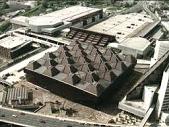
On Oct. 14, 1972 the $17M Omni Coliseum in Atlanta, Ga. opens as the home of the NBA Atlanta Hawks and NHL Atlanta Flames.
On Jan. 14, 1973 (noon) the first nationally-televised Super Bowl Sunday college basketball game, hosted by the ACC sees #3-ranked N.C. State U. defeat #2-ranked U. of Md. in College Park, Md. by 87-85; N.C. Star David Thompson scores 37 points; announcer Billy Packer receives his first nat. exposure; NFL announcer Ray Scott teams with him to calm NFL fans; in Mar. N.C. State U. defeats the U. of Md. again by 76-74 in the ACC Tournament championship game, but is barred from the NCAA tournament because of violations in the recruiting of Thompson.






On Apr. 24, 1973 the 1973 NBA Draft sees 17 teams select 211 players in 20 rounds; on May 5 the 11th and remaining rounds are held, after which the draft is limited to 10 rounds; after turning down a draft selection by the ABA Denver Nuggets, 6'6" guard-forward Paul Douglas "Doug" Collins (1951-) of Ill. State U. is selected #1 by the Philadelphia 76ers (#20), retiring in 1981 and becoming head coach of the Chicago Bulls (1986-9), coaching Michael Jordan and Scottie Pippen, getting them to the playoffs three years in a row but never getting them past the Detroit Pistons, then coaching the Detroit Pistons (1995-8), working as an announcer for five years until he gets a job as head coach of the followed by the Washington Wizards (2001-3), returning to broadcasting until he gets a job as head coach of his old team the Philadelphia 76ers (2010-13); 6'8" power forward Kermit Alan Washington (1951-) of American U. (#24) (who averaged 20 points and 20 rebounds per game in his college career) is selected #5 by the Los Angeles Lakers (#24), playing poorly for three seasons until he gets special help from retired coach Pete Newell, going on to become known for his rebounding ability; too bad, on Dec. 9, 1977 "The Punch" sees Washington punch Rudolph "Rudy" Tomjanovich Jr. (1948-) of the Houston Rockets during an on-court fight, fracturing his skull like an eggshell and severely shortening his career, receiving a $10K fine and 60-day (26-game) suspension, after which Saturday Night Live replays the punch numerous times as a gag, causing the NBA to stiffen penalties for on-court fights and add a 3rd referee, and turning Washington into a pariah; on Dec. 27, 1977 he is traded to the Boston Celtics (#26), moving to the San Diego Clippers (#42) in 1978-9, meeting Tomjanovich on the court in Nov. 1978 after the latter refuses to shake hands at center court prior to the tipoff; he then moves to the Portland Trail Blazers (#42) in 1979 in a 3-player trade for center Bill Walton, finally receiving fan support, retiring in Jan. 1982 after missing all but 20 games in the season due to back and knee pain; in 1987 he attempts a comeback with the Golden State Warriors (#3), lasting only eight games; 6'8" forward-center George F. McGinnis (1950-) of the U. of Ind. (1969 Indiana Mr. Basketball, who in the 1970-1 season become the first sophomore to lead the Big Ten in scoring and rebounding), who signed with the ABA Indiana Pacers (#30) in 1971 is selected #22 by the Philadelphia 76ers (#30), holding out until 1975, making it to the NBA Finals with Julius Erving and Caldwell Jones in 1977, then moving to the Denver Nuggets (#30) in 1978-80 before returning to the NBA Indiana Pacers in 1980-2 in a trade for Alex English (worst in Pacers history?), doing diddly until they let him go.

In Apr. 1973 6'11 William Theodore "Bill" Walton II (1952-), "the Big Redhead" of UCLA (#32) wins the nat. basketball title for the 2nd straight time (first school to win back-to-back NCAA titles) with 21 of 22 field goal attempts and 44 points, becoming the greatest offensive performance in U.S. college basketball (until ?), breaking USF's record of 60 consecutive wins; coach John Wooden receives his 6th NCAA college basketball coach of the year award.
On May 1-10, 1973 the 1973 NBA Finals sees the New York Knicks defeat the Los Angeles Lakers by 4-1 (102-93 in game 5), reversing the 1972 finals where the Knicks only won the first game; MVP is Willis Reed of the Knicks.
In 1973 after poor attendance in Dallas, the Texas (formerly Dallas) Chaparrals of the ABA move to San Antonio, Tex. as the San Antonio Spurs (team colors black, silver, and white), joining the NBA in 1976, after which the NBA adds the expansion team Dallas Mavericks in 1980.

In 1973 Robert Montgomery "Bobby" "Bob" Knight (1940-) becomes head coach of the Indiana U. Hoosiers male basketball team (until 2000), going on to win three NCAA championships and 11 Big Ten Conference championships.
On Jan. 19, 1974 the UCLA Bruins men's basketball team's 88-game winning streak (begun Jan. 24, 1971) ends with a 71-70 loss to Notre Dame U.


On Jan. 30, 1974 after signing for $40K a year in 1972 with the ABA Virginia Squares, who experience money problems, 6'7" Detroit, Mich.-born shooting guard George "the Iceman" Gervin (1952-) is sold for $228K to the ABA San Antonio Spurs (#44) (the last legitimate ABA star), coached (1974-6) by Robert Eugene "Bob" Bass (1929-) (Denver Rockets coach in 1967-8), transforming them into an exciting "schoolyard basketball" fast-breaking team that helps them survive the 1976 ABA-NBA merger; he goes on to average 14+ points per game in all of his playing seasons, finishing his NBA career with the Chicago Bulls in 1985-6 with an avg. of 26.2 points per game.


On Mar. 7, 1974 the NBA expands to 18 teams; on June 7 the New Orleans Jazz is founded, trading with the Atlanta Hawks for 6'5" star point guard Peter Press "Pistol Pete" Maravich (1947-88) (#7) (from LSU) ("best ball-handler of all time" - John Havlicek) (whose portrait bears a striking resemblance to actor Tom Cruise?), taking 10 years to make the playoffs, with the best season being 1977-8 (39-43), after which they make them every year until 2004; in 1979 it moves to Salt Lake City, becoming the Utah Jazz.
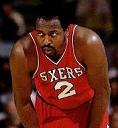

On Apr. 17, 1974 6'10" Petersburg, Va.-born center-forward Moses Eugene Malone (1955-2015) goes straight from Petersburg H.S. in Richmond, Va. to pro basketball, ruling the paint; on Aug. 29 he joins the ABA Utah Stars (#22) (1974-5), going on to play for the ABA Spirits of St. Louis (#13) (1975-6), Buffalo Braves (#20) (1976), Houston Rockets (#24) (1976-82), Philadelphia 76ers (#2) (1982-6, 1993-4), Washington Bullets (#4) (1986-8), Atlanta Hawks (#2) (1988-91), Milwaukee Bucks (#8) (1991-3), Philadelphia 76ers (1993-4), and San Antonio Spurs (#2) (1994-5), retiring after 19 seasons as the last former active ABA player with a championship ring from 1983.


On Apr. 28-May 12, 1974 the 1974 NBA Finals sees the Boston Celtics (coach Tom Heinsohn) defeat the Milwaukee Bucks (coach Larry Costello) by 4-3; MVP is John Havlicek of the Celtics; Hazleton, Penn.-born Milwaukee Bucks asst. coach (1972-4) Hubert Jude "Hubie" Brown (1933-) goes on to become head coach of the Kentucky Colonels (ABA) (1974-6), Atlanta Hawks (1976-81), New York Knicks (1982-7), and Memphis Grizzlies (2002-5).











On May 28, 1974 the 1974 NBA Draft sees 18 teams select 178 players in 10 rounds; 6'11" center William Theodore "Bill" "Big Redhead" Walton (1952-) of UCLA (#32) (who led them to two championships and won three straight college player of the year awards) is selected #1 by the Portland Trail Blazers (#32), moving to the San Diego Clippers (#32) in 1979-85, and the Boston Celtics (#5) in 1985-7; after turning down a 1973 draft by the ABA Carolina Cougars to finish college, 6'9" forward (asthmatic) (epileptic) Robert Clyde "Bobby" Jones (1951-) of the U. of N.C. (known for outstanding clean defensive play and Dudley Dooright Christian lifestyle) ("He's a player who's totally selfless, who runs like a deer, jumps like a gazelle, plays with his head and heart each night, and then walks away from the court as if nothing happened" - Julius Erving) ("Watching Bobby Jones on the basketball court is like watching an honest man in a liars' poker game" - Larry Brown) is selected #5 by the Houston Rockets, who trade him to the Denver Nuggets (#24) (coach Larry Brown) for Marvin Barnes, causing the Nuggets to go 65-19 in 1974-5 (2nd best record in ABA history), and 60-24 in 1975-6, after which in 1978 he and Ralph Simpson are traded for George McGinnis to the Philadelphia 76ers (#24), changing from a starter to a sixth man backing up Julius Erving, Darryl Dawkins, and Caldwell Jones, playing eight seasons for them (until 1986), winning the first-ever NBA Sixth Man Award in 1983; 6'7" forward Scott Dean "the Incredible Hulk" Wedman (1952-) of the U. of Colo. is selected #6 by the Kansas City Kings (#15), scoring 45 points in an OT win over the Utah Jazz on Jan. 2, 1980, moving to the Cleveland Cavaliers (#8) in 1981-3, and the Boston Celtics (#20) in 1983-6, retiring after he is traded to the Seattle SuperSonics; 6'8" forward Michael Campanella "Campy" Russell (1952-) of the U. of Mich. (junior) (#20) is selected #8 by the Cleveland Cavaliers (#20), moving to the New York Knicks (#21) in 1980-2, and back to the Cavaliers (#21) in 1984; 6'6" forward Keith (Jamaal) "Smooth as Silk" Wilkes (Jamaal Abdul-Lateef) (1953-) of UCLA (#52) (teammate of Bill Walton) (known for his corner jump shot AKA "20-foot layup" by Chick Hearn) is selected #11 by the Golden State Warriors (#41), converting to Islam in 1975 and changing his name before moving to the Los Angeles Lakers (#52) in 1977-85, and the Los Angeles Clippers (#52) in 1985; 6'4" guard-forward Brian Joseph Winters (1952-) of the U. of S.C. is selected #12 by the Los Angeles Lakers (#20), moving to the Milwaukee Bucks (#32) in 1975-83, then working his way up from asst. coach at Princeton U. in 1984-6 to head coach of the Vancouver Grizzlies in 1995-7; 6'9" power forward Maurice "the Enforcer" Lucas (1952-2010) of Marquette U. (junior) is selected #14 by the Chicago Bulls, deciding to play for the ABA Spirits of St. Louis, moving to the ABA Kentucky Colonels in 1975-6 before returning to the NBA to join the Portland Trail Blazers (#20) in 1976-80, the New Jersey Nets (#?) in 1980-1, the New York Knicks (#23) in 1981-2, the Phoenix Suns (#20) in 1982-5, the Los Angeles Lakers (#20) in 1985-6, the Seattle SuperSonics (#20) in 1986-7, and back to the Trail Blazers in 1987-8; 6'6" guard-forward William R. "Billy" Knight (1952-) of the U. of Pittsburgh is selected #21 by the Los Angeles Lakers and the Indiana Pacers, choosing the latter (#25), going on to become their 3rd all-time leading scorer before moving to the Kansas City Kings (#24) in 1983-4, and the San Antonio Spurs (#24) in 1984-5; 6'7" power forward Leonard Eugene "Truck" Robinson (1951-) of Tenn. State U. (known for his solid body, speed, and rebounding) is selected #22 by the Washington Bullets (#33), moving to the New Orleans Jazz (#21) in 1977-79, leading the NBA in minutes played (3,638), defensive rebounds (990), total rebounds (1,288), and rebounds per game (15.7) in the 1977-78 season, then moving to the Phoenix Suns (#21) in 1979-8, and the New York Knicks (#21) in 1982-5; 6'6" guard-forward John Edward Drew (1954-) of Gardner-Webb U. (junior) is selected #25 by the Atlanta Hawks (#22), leading the NBA in offensive rebounding in his rookie season, and setting an NBA record for most turnovers in a regular season game on Mar. 1, 1978 against the New Jersey Nets, after which he is traded for Dominique Wilkins to the Utah Jazz (#20) in 1982, missing 38 games in 1983 while attending drug rehab, winning the NBA comeback player of the year award in 1984, then relapsing, getting fired from the Jazz and banned for life from the NBA for substance abuse in 1986, ending up as a taxi driver in Houston, Tex.; 6'4" guard Philip Arnold "Phil" Smith (1952-2002) of the U. of San Francisco is selected #29 by the Golden State Warriors (#20), playing as a rookie on their 1974-5 championship team.

In 1974 Wellsville, N.Y.-born Anthony William "Billy" Packer (Paczkowski) (1940-) begins announcing college basketball games for NBC-TV, switching to CBS-TV in 1981 (until 2008), covering every NCAA Men's Div. 1 Basketball Championship incl. the Final Four from 1975-2008, becoming known for his arguments with Al McGuire et al. which make the sport more popular; on Apr. 4 after Lorenzo Charles of the U. of N.C. makes a game-winning slam dunk to defeat Houston U. to win the title, he utters the soundbyte: "They won it... on the dunk!"; after the U. of Ariz. wins the 1997 title, and Arizona U. star player Miles Simon celebrates on the court, he utters the soundbyte: "Simon says... championship."

In 1974 USA Basketball is founded in Tempe, Ariz. to represent FIBA in the U.S., originally named Amateur Basketball Assoc. of the United States of America (ABAUSA), then renamed on Oct. 12, 1989 after prof. basketball players are allowed to compete in internat. competitions; chmn. is Phoenix Suns owner Jerry Colangelo (1939-).
On Apr. 9, 1975 the Philippine Basketball Assoc. plays its first game at the Araneta Coliseum, becoming Asia's first pro basketball league.




On May 18-25, 1975 the 1975 NBA Finals sees the Golden State Warriors sweep the Washington Bullets, becoming the first coached by black head coaches on each side, Alvin A. "Al" Attles Jr. (1936-) for the Warriors, and K.C. Jones (1932-) for the Bullets.






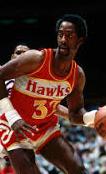
On May 29, 1975 the 1975 NBA Draft (last one held before June) sees 18 teams select 174 players in 10 rounds; on Dec. 30, 1975 the NBA holds a supplementary draft for ABA players who have never been drafted by NBA teams; after leading the Wolfpack to its first NCAA championship in 1974, then making a slam dunk in his last home game against UNC-Charlotte and seeing it ruled a technical foul, 6'4" guard-forward David O'Neil "Skywalker" Thompson (1954-) of N.C. State U. (#44) (known for his 44-in. vertical leap and for inventing the alley-oop pass along with teammate Monte Towe, becoming Michael Jackson's childhood hero, causing him to introduce him to the Basketball Hall of Fame) is selected #1 by the Atlanta Hawks, but after they act cheap and take him to a meal at McDonald's during the interview, he signs with the ABA Denver Nuggets (#33) along with his friend Monte Towe, moving to the Seattle Supersonics (#44) in 1982-4; 6'9" forward-center Alvan Leigh Adams (1954-) of the U. of Okla. (junior) is selected #4 by the Phoenix Suns (#33), being named rookie of the year and helping his team reach the 1976 NBA Finals, scoring a triple-double (47 points, 18 rebounds, 12 assists) on Feb. 22, 1977 against the Buffalo Braves, and retiring in 1988 as the Suns' 2nd all-time scorer with 13,910 points; 6'11" center Darryl ""Double D" Chocolate Thunder" Dawkins (1957-) of Maynard Evans H.S. in Orlando, Fla. is selected #5 by the Philadelphia 76ers (#53), getting touted as the next Wilt Chamberlain but being too green and ending up on the bench for two seasons, finally coming into his own in the 1978-9 season on the front line with Caldwell Jones, making a .607 field goal percentage in the 1980-1 season, then losing in the 1982 NBA Finals to the Los Angeles Lakers after he is unable to handle Kareem Abdul-Jabbar, causing him to be traded to the New Jersey Nets (#45) in 1982, while Caldwell Jones is traded to the Houston Rockets in exchange for Moses Malone; after two good years despite a record 379 fouls in the 1982-3 season and 386 in the 1983-4 season, injuries limit him to 39 games in the 1984-5 season, and he misses 31 of the last 32 games in the 1985-6 season, causing him to be traded to the Utah Jazz (#45) in 1987, and the Detroit Pistons (#50) in 1987-9; 6'3" point guard Lionel Eugene Hollins (1953-) of Ariz. State U. is selected #6 by the Portland Trail Blazers (#14), helping it win the 1977 NBA Finals before moving to the Philadelphia 76ers (#9) in 1980-2, the San Diego Clippers (#9) in 1982-3, the Detroit Pistons (#9) in 1983-4, and the Houston Rockets (#9) in 1984-5, after which he begins a coaching career, becoming head coach of the Memphis Grizzlies in 2009-13, and the Brooklyn Nets in 2014-; 6'2" point guard Gus "Wizard" Williams (1953-) of USC is selected #20 by the Golden State Warriors (#1), moving to the Seattle SuperSonics (#1) in 1977-84, leading them to the 1979 NBA championship, sitting out the 1980-1 season due to a contract dispute, playing the 1984-5 season alongside Guy Williams, then moving to the Washington Bullets (#1) in 1984-6, and the Atlanta Hawks (#1) in 1987; 6'2" guard ("the Prince of Midair") ("All-World") Lloyd Bernard Free (1953-) of Guilford U. (junior), known for his 44 in. vertical leap and 360 deg. dunks is selected #23 by the Philadelphia 76ers (#21), moving to the San Diego Clippers (#24) in 1978-80, leading the NBA in scoring in the 1978-9 and 1979-80 seasons, then moving to the Golden State Warriors (#21) in 1980-2, the Cleveland Cavaliers (#21) in 1982-6, and back to Philly in 1987-8; on Dec. 8, 1981 he changes his name to World B. Free; 6'8" forward-center Danny Thomas "Dan" Roundfield (1953-2012) of Central Mich. U. is selected #28 by the Cleveland Cavaliers, who trade him to the Indiana Pacers (#32), moving to the Atlanta Hawks (#32) in 1978-84, the Detroit Pistons (#32) in 1984-5, and the Washington Bullets (#5) in 1985-7, making five NBA All-Defensive Teams.
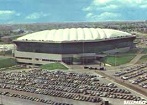
On Dec. 6, 1975 the Pontiac Silverdome in Pontiac, Mich. (begun 1973) opens as the home of the NFL Detroit Lions and NBA Detroit Pistons; it features the first domed roof supported completely by air.

In 1975 7'2" Milwaukee Bucks star center (since 1969) Kareem Abdul-Jabbar (Ferdinand Lewis "Lew" Alcindor Jr.) (1947-) moves to the Los Angeles Lakers as #33 (until 1989), becoming known for his Skyhook.
On Jan. 27, 1976 the 1976 ABA All-Star Game (last) at McNichols Arena in Denver, Colo. sees the first place Denver Nuggets (coach Larry Brown) defeat the ABA All Stars (coach Kevin Loughery) by 144-138 after a record 52 Denver points in the 4th quarter; MVP is David Thompson of the Denver Nuggets; halftime sees the first-ever Slam Dunk Contest, which is won by Julius Erving of the New York Nets with a foul-line dunk, setting the bar for future contests; runner-up is David Thompson; the 1976-7 NBA Slam Dunk Contest takes all season, and is won by Darnell Hillman; the next contest is held in 1984 in Denver, and sees Larry Nance defeat Julius Erving in the final round; Denver goes on to finish the season at 60-24 then lose in the 1976 ABA Finals to the New York Nets by 4-2 on May 13, 1976; starting in 1984 the NBA All-Star Weekend is held every Feb. in the middle of the NBA season, starting with the Slam Dunk Contest, followed in 1986 by the Three-Point Shootout Contest (first winner Larry Bird), always culminating in the NBA All-Star Game on Sun.
In Mar. 1976 after winning a preseason exhibition game against the Soviet nat. team by 94-78, the 1976 NCAA Men's Div. 1 Basketball Tournament is won by the Indiana U. Hoosiers (coach Bob Knight) of the Big Ten, who end their season with a perfect 32-0 record (next in ?).
On May 13, 1976 the New York Nets defeat the Denver Nuggets 4-2 in the 9th and final ABA championship, after which the ABA-NBA Merger disbands the ABA.

On May 23-June 6, 1976 the 1976 NBA Finals is won 4-2 by the Boston Celtics over the Phoenix Suns; on June 4 the Phoenix Suns lose 128-126 in triple OT against the Boston Celtics in Game 5; MVP is 6'3" point guard Joseph Henry "Jo Jo" White (1946-) (#10) of the Celtics.








On June 8, 1976 the 1976 NBA Draft sees 18 teams select 173 players in 10 rounds; 6'3" point guard John Harding Lucas II (1953-) of the U. of Md. is selected #1 by the Houston Rockets (#5/#15), moving to the Golden State Warriors (#4) in 1978-81, the Washington Bullets (#5) in 1981-3, the San Antonio Spurs (#15) in 1983-4, the Houston Rockets (#5) in 1984-6, losing the NBA Finals to the Boston Celtics then getting in trouble for drugs in the offseason and avoid being banned by undergoing drug treatment, then moving to the Milwaukee Bucks (#10) in 1986-8, ending up a reserve player in his 2nd season, finishing with the the Seattle SuperSonics (#15) in 1988-9, and the Rockets (#10) in 1989-90, never being named to an All-Star Team, then becoming head coach of the San Antonio Spurs in 1992-3 and 1993-4, the Philadelphia 76ers in 1994-6, and the Cleveland Cavaliers in 2001-3; 6'7" forward Scott Glenn May (1954-) of the Ind. U. is selected #2 by the Chicago Bulls (#17), moving to the Milwaukee Bucks (#7) in 1981-2, and the Detroit Pistons (#24) in 1982; after becoming the leading scorer on the 1976 gold medal U.S. men's basketball team in Montreal, 6'5" forward-guard Adrian Delano Dantley (1955-) of Notre Dame U. (scoring leader in 1974-5 and 1975-6) is selected #6 by the Buffalo Braves (#44), winning the rookie of the year award before moving to the Indiana Pacers (#4) in 1977, the Los Angeles Lakers (#4) in 1977-9, the Utah Jazz (#4) in 1979-86, leading the NBA in scoring in 1980-1 and 1983-4, missing 60 games in 1983 after tearing ligaments in his right wrist, then moving to the Detroit Pistons (#45) in 1986-9, the Dallas Mavericks (#4) in 1989-90, and the Milwaukee Bucks (#7) in 1990-1, going on to work as an asst. coach for the Denver Nuggets, and head coach in 2009-10; 7'0" center Robert Lee "the Chief" Parish (1953-) of Centenary College (nicknamed The Chief after stoic Chief Bromden in the 1975 film "One Flew Over the Cuckoo's Nest") is selected #8 by the Golden State Warriors (#00), who are in decline, getting traded to the Boston Celtics (#00) in 1980 in exchange for the #1 pick which the Warriors use to select Joe Barry Carroll, and another 1st round pick that Boston uses to sign Kevin McHale, both helping Boston win NBA titles in 1981, 1984, and 1986; he then moves to the Charlotte Hornets (#00) in 1994-6, and the Chicago Bulls (#00) in 1996-7, helping win an NBA title in 1997; 6'7" forward Alexander "Alex" English (1954-) of the U. of S.C. (#22) is selected #23 by the Milwaukee Bucks (#22), moving to the Indiana Pacers (#22) in 1978-80 before being traded for George McGinnis to the Denver Nuggets (#2) in 1980, becoming one of the NBA's highest scorers, leading the team to nine straight playoffs before moving to the Dallas Mavericks (#3) in 1990-1; after turning down an offer in 1975 from the ABA Memphis Sounds (Baltimore Claws), 6'8" forward-center Lonnie Jewel Shelton (1955-) of Oregon State U. is selected #25 by the New York Knicks (#?), leading the NBA in personal fouls for two seasons before moving to the Seattle SuperSonics (#?) as their starting forward in 1978-83, and the Cleveland Cavaliers (#?) in 1983-6; 6'4" guard Dennis Wayne "DJ" Johnson (1954-2007) of Pepperdine U., known as a defensive stopper and clutch player is selected #29 by the Seattle SuperSonics (#24), leading them to the NBA championship in 1979 and winning the MVP award, moving to the Phoenix Suns (#24) in 1980-3, and the Boston Celtics (#3) as starting point guard in 1983-90, hooking up with Larry Bird and helping them win two more championships, going on to become head coach of the Los Angeles Clippers in 2003.

On June 17, 1976 four former ABA teams join the NBA, incl. the San Antonio Spurs, Denver Nuggets, Indiana Pacers, and New York Nets; on Aug. 8 the ABA Dispersal Draft for players from the defunct Kentucky Colonels and Spirts of St. Louis sees 7'2" star center Artis "the A-Train" Gilmore (1949-) (#53) of the Kentucky Colonels selected #1 by the Chicago Bulls.

In 1976 James Arthur "Jim" Boeheim (1944-) becomes head coach of the Syracuse U. men's basketball team (until ?), going on to lose the nat. title to Indiana in 1987 and Kentucky in 1996 before defeating Kansas in 2003.
On May 22-June 5, 1977 after the ABA-NBA merger allows Philadelphia to sign Julius "Dr. J." Erving, and Portland to sign power forward Maurice Lucas, the Portland Trail Blazers (coach Jack Ramsay) defeat the Philadelphia 76ers (coach Gene Shue) by 109-107 to win the 1977 NBA Finals by 4-2; Bill Walton is named series MVP; five of 10 starting players are former ABA players, incl. Julius Erving, Caldwell Jones, George McGinnis, Dave Twardzik, and Maurice Lucas; Game 2 sees Maurice Lucas shows why he's called the Enforcer as the 76ers score 14 points in less than 3 min. en route to a 107-89, and in the last 5 min. 76er Darryl Dawkins and Blazer Bob Gross go up for a rebound and wrestle each other to the floor, getting into a fight that clears both benches incl. the coaches, after which Maurice Lucas slaps Dawkins from behind and challenges him, causing both to be ejected; Doug Collins needs four stitches after he catches a punch from Dawkins that missed its target; Dawkins and Lucas are each fined $2.5K; the brawl unifies the Blazers, helping them turn the series around.



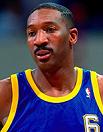



On June 10, 1977 after the New York Nets relocate to N.J., becoming the New Jersey Nets, the 1977 NBA Draft sees 22 teams select 170 players in eight rounds; first time for the Denver Nuggets, Indiana Pacers, New Jersey Nets, and San Antonio Spurs; Big Ten player of the year 6'10" center Michael Kent "Benny" Benson (1954-) of the U. of Indiana is selected #1 by the Milwaukee Bucks (#54), getting his jaw broken by Los Angeles Lakers center Kareem Abdul-Jabbar 2 min. into his first game, which breaks Kareem's hand and puts him out of action for 2 mo., avoiding suspension; after failing to live up to his #1 draft pick potential, Benson is traded to the Detroit Pistons (#54) for Bob Lanier in 1980, then traded again to the Utah Jazz (#54) along with Kelly Tripucka for Adrian Dantley in 1986, ending up with the Cleveland Cavaliers (#54) in 1987-8; 6'3" guard Otis Lee Birdsong (1955-) of the U. of Houston (#10) (who scored a total of 2,832 points) is selected #2 by the Kansas City Kings (#10), moving to the New Jersey Nets (#10) in 1981-8, and the Boston Celtics (#10) in 1988-9; 6'7" forward Marques Kevin Johnson (1956-) of UCLA (#54) is selected #3 by the Milwaukee Bucks (#8), helping them win div. titles in 1980-4, coining the term "point forward" before moving to the Los Angeles Clippers (#8) in 1984-7, injuring his neck in 1987 and returning for 10 games with the Golden State Warriors (#8) before retiring on Dec. 27, 1989; 6'6" guard-forward Walter Paul "the Greyhound" "the Candyman" "the Man with the Velvet Touch" Davis (1954-) of the U. of N.C. is selected #5 by the Phoenix Suns (#6), winning the rookie of the year award and becoming their all-team leading scorer (15,666 points) before getting fouled-up in a drug scandal and moving to the Denver Nuggets (#6) in 1988-91, the Portland Trail Blazers (#6) for half a season in 1991, and back to the Denver Nuggets (#6) in 1991-2, returning as an announcer for the Nuggets; 6'7" small forward Bernard King (1956-) of the U. of Tenn. (#53) (junior) is selected #7 by the New York Nets (#22), setting a team record of 1,909 points in his rookie season (24.2 points per game), moving to the Utah Jazz (#22) in 1979-80, the Golden State Warriors (#30) in 1981-2, the New York Knicks (#30) in 1982-7, scoring 2,027 points in the 1983-4 season and leading the NBA in scoring in the 1984-5 season with 32.9 points per game; on Jan. 31 and Feb. 1, 1984 he becomes the first NBA player since 1964 to score 50+ points in consecutive games against the San Antonio Spurs and Dallas Mavericks; on Dec. 25, 1984 he scores 60 points in a loss to the New Jersey Nets; too bad, on Mar. 23, 1985 he injures his right knee during a game against the Kansas City Kings, causing him to miss the 1985-6 season, after which he attempts a comeback with the Washington Bullets (#30) in 1987-91, retiring after 32 games with the New Jersey Jets (#30) in 1993; 6'11" forward-center Jack Wayne Sikma (1955-) of Ill. Wesleyan U., known for curly blonde hair and patented step-back behind-the-head jump shot is selected #8 by the Seattle SuperSonics (#43), leading the NBA in defensive rebounds in 1981-2 and 1983-4 before moving to the Milwaukee Bucks (#43) in 1986-91, leading the NBA in free-throw percentage (92.2%) in the 1987-88 season (career avg. 84.9%), then retiring after making 200+ 3-pointers in his career (32.8% accuracy), going on to become asst. coach for the Seattle Supersonics in 2003-7, the Houston Rockets in 2007-11, and the Minnesota Timberwolves in 2011-14; 6'3" point guard Thomas Ray Williams (1954-2013) (younger brother of Gus Williams) of the U. of Minn. is drafted #10 by the New York Knicks (#13), becoming team captain in his 4th season.
On Dec. 13, 1977 a chartered DC-3 en route to Nashville, Tenn. crashes in rain and fog after takeoff from Evansville, Ind., killing 29, incl. 14 U. of Evansville basketball players (Purple Aces) and head coach Robert "Bobby" Watson; retired NBA star Jerry Sloan worked as asst. coach for five days earlier in the season.
In 1977 the first annual R. Williams Jones Cup Team of USA Basketball (FIBA), named after FIBA founding secy.-gen. Renato William Jones is held in Taipei, Taiwan, with players selected from univ. and h.s. all-stars; the men's version ends up being dominated by U.S. teams, and the women's version by teams from South Korea, Taiwan, and the U.S.
In 1977 the first annual John R. Wooden Award, named after John Wooden of Purdue U., the 1932 nat. collegiate basketball player of the year for the outsidanging men's college basketball player is presented to Marques Johnson, followed by Phil Ford (1978), Larry Bird (1979), Darrell Griffith (1980), Danny Ainge (1981), Ralph Sampson (1982-3), Michael Jordan (1984), Chris Mullin (1985), Walter Berry (1986), David Robinson (1987), and Danny Manning (1988); in 2004 women are included; in 1999 the first Legends of Coaching Award is presented.
On May 21-June 7, 1978 the 1978 NBA Finals sees the Washington Bullets, who had compiled only a 44-38 regular season record defeat the Seattle SuperSonics by 4-3; the Game 7 V is sealed with a dunk by guard Bob Dandridge; Wes Unseld of the Bullets is MVP.












On June 9, 1978 the 1978 NBA Draft sees 22 teams select 202 players in 10 rounds; after the Portland Trail Blazers, Kansas City Kings, Indiana Pacers, New York Knicks, and Golden State Warriors pass, 6'9" West Baden, Ind.-born ("Larry Legend") ("Hick from French Lick") ("Basketball Jesus") ("Great White Hope") Larry Joe Bird (1956-) of Indiana State U. (sophomore) is selected #6 by the Boston Celtics (#33), but opts to stay in school another year before entering the league in 1979, going on to win rookie of the year and stay with the Celtics his entire 13-year career (until 1992), winning three NBA championships, three straight MVP awards, and two Finals MVP awards, playing in 13 straight All-Star Games, then becoming the head coach of the Indiana Pacers in 1997-2000; 6'10" Nassau, Bahamas-born center-forward Mychal George Thompson (1955-) of the U. of Minn. is selected #1 by the Portland Trail Blazers (#43), becoming the first foreign-born player to be selected #1 overall; in Feb. 1987 he is traded to the Los Angeles Lakers (#43) (until 1991) to back Kareem Abdul-Jabbar and defend against Celtics forward Kevin McHale, giving the Lakers four #1 draft selections incl. Magic Johnson and James Worthy; 6'2" point guard Phil Jackson Ford Jr. (1956-) of the U. of N.C. (#12) (top scorer in history, with 2,290 points, not surpassed until Dec. 18, 2008 by Tyler Hansbrough) is selected #2 by the Kansas City Kings (#1), winning the rookie of the year award, moving to the New Jersey Nets (#18) in 1982, the Milwaukee Bucks (#12) in 1982-3, and the Houston Rockets (#1) in 1984-5; 6'11 center-forward Frederick Robert "Rick" Robey (1956-) of the U. of Ky. (#53) is selected #3 by the Indiana Pacers (#53), moving to the Boston Celtics (#53) in 1979-83, and the Phoenix Suns (#8) in 1983-6; 6'5" guard Micheal "Sugar" Ray Richardson (1955-) of the U. of Montana is selected #4 by the New York Knicks (#20), getting billed as "the next Walt Frazier", leading the NBA in assists and steals in 1979-80 before being traded for Bernard King to the Golden State Warriors (#20) in 1982, playing 33 games before moving to the New Jersey Nets (#20) in 1982, becoming an all-star and playing on the Eastern Conference all-star team that freezes out Michael Jordan in the 1984 playoffs, lead the Nets to a shocking upset of the defending champion Philadelphia 76ers in game 5 after scoring 24 points and making 6 steals; too bad, in 1986 he is banned for life by NBA commissioner David Stern for drug abuse, going on to play in Canada and Europe; 6'7" small forward Purvis "Rainbowman" Short (1957-) of Jackson State U. (#45), known for his rainbow arc shots is selected #5 by the Golden State Warriors (#45), scoring 59 points in a 1984 game against the New Jersey Nets, moving to the Houston Rockets (#10) in 1987-9, and the New Jersey Nets (#45) in 1989-90; 6'4" guard Ronald Charles "Ron" Brewer (1955-) of the U. of Ark. (#10) is selected #7 by the Portland Trail Blazers (#10), moving to the San Antonio Spurs (#34) in 1980-1, the Cleveland Cavaliers (#10) in 1981-2, and the Golden State Warriors (#17) in 1983-4; 6'4" guard-forward Freeman Williams (1956-) of Portland State U. is selected #8 by the Boston Celtics, who trade him to the San Diego Clippers (#20), becoming the first Clippers player in Dec. 1980 to win a player of the month award until Elton Brand in 2005, after which in Sept. 1982 he is traded along with John Drew in exchange for Dominique Wilkens to the Utah Jazz, but refuses to sign, playing 27 games with the Utah Jazz (#5) in 1983 and 9 games with the Washington Bullets (#20) in 1986; 6'7" guard Reginald Wayne "Rush Street Reggie" Theus (1957-) of UNLV (#23) (junior) is selected #9 by the Chicago Bulls (#24), becoming runner-up for rookie of the year, moving to the Kansas City Kings (#6) in 1984-8, the Atlanta Hawks (#24) in 1988-9, the Orlando Magic (#24) in 1989-90, the New Jersey Nets (#24) in 1990-1, going on to play in Italy and Greece before becoming head coach of the ABA Las Vegas Slam in 2002, New Mexico State U. in 2005-7, the Sacramento Kings in 2007-8, and Cal State U. Northridge in 2013-; 6'7" small forward Michael Anthony "Mike" Mitchell (1956-2011) of Auburn U. (#30) (all-time leader in scoring and rebounding with 2,123 points and 996 rebounds) is selected #15 by the Cleveland Cavaliers (#30), moving to the San Antonio Spurs (#34) in 1981-7, moving to Europe to play for Filodoro Brescia of Italy in 1988-90 before returning to the Spurs in 1990, then back to Europe; 6'1" point guard Maurice Edward "Mo" Cheeks (1956-) of West Texas State U. is selected #36 by the Philadelphia 76ers (#10), moving to the San Antonio Spurs (#1) in 1989-90, the New York Knicks (#1) in 1990-1, the Atlanta Hawks (#10) in 1991-2, and the New Jersey Nets (#10) in 1993, retiring as all-time NBA leader in steals (2 per game), going on to become head coach of the Portland Trail Blazers in 2001-5, the Philadelphia 76ers in 2005-8, and the Detroit Pistons in 2013-14.
On July 7, 1978 Irv Levin swaps the Boston Celtics with John Y. Brown and Harry Mangurian for the Buffalo Braves, which move to San Diego, Calif., becoming the San Diego Clippers until 1984, when they move to Los Angeles, Calif.
On Nov. 8, 1978 the Philadelphia 76ers defeat the New Jersey Nets by 137-133 in double OT; after a protest is upheld the final 17:50 is replayed on Mar. 23, 1979 with the 76ers ahead by 84-81, and the 76ers win by 110-98; Harvey Catchings and Ralph Simpson of the 76ers are traded for Eric Money and Al Skinner before the rematch, becoming the only prof. sports players in history to play for both teams in the same game; Money becomes the only one to score for both teams, 23 for the Nets and 4 for the 76ers.

In the 1978-9 season the NBA adds a 3rd referee; 6'8" 2nd-year power forward Cedric Bryan "Cornbread" Maxwell (1955-) of the Celtics (#31), known for his effectiveness in the low post makes hay while Larry Bird tweet, er, hesitates to sign, averaging 19 points and 9.9 rebounds per game, setting the stage for the future Celtics NBA dynasty.


On Mar. 26, 1979 the 41st NCAA Men's Basketball Championship sees the Michigan State Spartans defeat the Indiana State Sycamores 75-64 as black point guard Earvin "Magic" Johnson Jr. (1959-) outscores white forward Larry Bird (1956-) by 24-19, snapping Indiana State's 33-game win streak; commentator Al McGuire utters the soundbyte that the game "put college basketball on its afterburner"; Johnson wins a high school championship, NCAA championship, and NBA championship all within three years (1977-80).
On May 20-June 1, 1979 the Seattle SuperSonics defeat the Washington Bullets by 4-1 in the 1979 NBA Finals AKA the George Washington Series, giving Seattle, Wash. its first pro sports championship since the Seattle Metropolitans won the Stanley Cup in 1917; Dennis Johnson of Seattle is MVP.





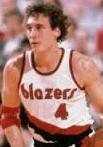
On June 25, 1979 the 1979 NBA Draft sees 22 teams select 202 players in 10 rounds; after they obtain the first round pick in a trade with the New Orleans Jazz, 6'9" Lansing, Mich.-born point guard Earvin "Magic" Johnson Jr. (1959-) of Michigan State U. (sophomore) is selected #1 by the Los Angeles Lakers (#32), becoming the tallest point guard in NBA history (until ?), going on to play until 1991, form the Magic Johnson All-Stars barnstorming team, then return as coach in 1994, making a player comeback in the 1995-6 season for 32 games; 6'9" Lynwood, Calif.-born forward-guard David Kasim "Dave" Greenwood (1957-) of UCLA is selected #2 by the Chicago Bulls (#34), becoming a marquee player along with Reggie Theus and Orlando Woolridge before being traded to the San Antonio Spurs (#10) on Oct. 24, 1985 in exchange for George Gervin; on Jan. 26, 1989 he and Darwin Cook are traded to the Denver Nuggets (#22) for Calvin Natt and Jay Vincent; on Oct. 6, 1989 he signs as a free agent with the Detroit Pistons (#33); on Aug. 17, 1990 he signs as a free agent with the Spurs until May 21, 1991; Lodi, Calif.-born 7'1" center James William "Bill" Cartwright (1957-) of the U. of San Francisco is selected #3 by the New York Knicks (#25), moving to the Chicago Bulls (#24) in 1988-94; 6'4" Little Rock, Ark.-born guard Sidney A. "Sid the Squid" "Sir Sid" "El Sid" Moncrief (1957-) of the U. of Ark. is selected #5 by the Milwaukee Bucks (#4), becoming known for his defensive play, winning the first two NBA Defensive Player of the Year awards in 1983-4; 6'6 Monroe, La.-born forward Calvin Leon Natt (1957-) of Northeast Louisiana U. (older brother of Kenny Natt) is selected #8 by the New Jersey Nets (#43), moving to the Portland Trail Blazers (#33) in 1980, and the Denver Nuggets (#33) in 1984-9; 6'6" Kettering, Ohio-born guard-forward James Joseph "Jim" Paxson (1957-) of Dayton U. is selected #12 by the Portland Trail Blazers (#4), switching to the Boston Celtics (#4) in 1988-90.
On Oct. 12, 1979 after the NBA adopts a 3-point line, guard Chris Ford of the Boston Celtics hits the NBA's first 3-pointer.


On Nov. 11, 1979 6'11" Orlando, Fla. native Darryl "Double D" "Chocolate Thunder" Dawkins (1957-) of the Philadelphia 76ers (#53) makes history for his city by shattering a backboard while dunking in an NBA game against the Kansas City Kings at Kemper Arena, then does it again on Dec. 6 against the San Antonio Spurs at the Spectrum Arena, causing the NBA on Dec. 9 to announce a rule making it an offense and introduce breakaway rims; Dawkins names the first dunk "The Chocolate-Thunder-Flying, Robinzine-Crying, Teeth-Shaking, Glass-Breaking, Rump-Roasting, Bun-Toasting, Wham-Bam, Glass-Breaker-I-Am-Jam" - not every gift comes in a box, or bag, or stocking?

On Mar. 18, 1980 Chicago, Ill.-born Michael William "Mike" "Coach K" Krzyzewski (1947-), head coach (since 1975) of the West Point Army Cadets becomes head coach of the Duke U. Blue Devils men's basketball team (until ?), becoming the first Div. 1 men's basketball coach to reach 1K wins with a 77-68 defeat of St. John's U. on Jan. 25, 2015, going on to win five NCAA championships (1991, 1992, 2001, 2010, 2015).





On May 1, 1980 the NBA expands to 23 teams as the Dallas Mavericks (Mavs) team is founded by Don Carter, and named after the 1957-62 TV series "Maverick", with Dick Motta as head coach #1; Kiki Vandeweghe of UCLA is their first pick, but he holds out for the Denver Nuggets; 6'3" guard Bradley Ernest "Brad" Davis (1955-) (#15) from the CBA is signed in Dec.; the debut game in the new Reunion Arena (opened Apr. 28; closed June 30, 2008) sees the Mavericks defeat the Spurs by 103-92, but their first season starts 6-40 and ends 15-67; in 1981 they draft 6'6" forward Mark Anthony Aguirre (1959-) (#24), Panamanian-born 6'6" guard Rolando Antonio Blackman (1959-) (#22), and 6'7" forward Jay Fletcher Vincent (1959-) (#31).
On May 4-16, 1980 the 1980 NBA Finals sees the Los Angeles Lakers (coach Paul Westhead) defeat the Philadelphia 76ers (coach Billy Cunningham) by 4-2; MVP is rookie Magic Johnson of the Lakers, who started at center in place of injured Kareem Abdul-Jabbar; Game 6 sees Johnson score 42 points, 15 rebounds, and 7 assists, and veteran teammate Jamaal Wilkes score 37 points and 10 rebounds, with Johnson uttering the soundbyte: "Jamaal Wilkes had an unbelievable game. Everybody talked about my 42, but it was also his."
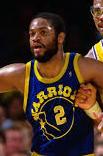

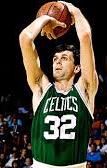
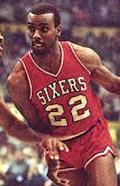


On June 10, 1980 the 1980 NBA Draft in New York City sees 23 teams select 214 players in 10 rounds; the Dallas Mavericks expansion team is assigned the 11th pick in each round; after trading Robert Parish and the #2 draft choice for him, the Golden State Warriors select 7'0" Pine Bluff, Ark.-born center Joe Barry Carroll (1958-) of Purdue U. #1 overall (#2), who goes on to be nicknamed "Joe Barely Cares" and "Just Barely Carroll" after snubbing interviewers, leaving in 1984 to play for Simac Milano in Italy before returning in 1985-7; 6'4" Louisville, Ky.-born shooting guard Darrell Steven "Dr. Dunkenstein" "Golden Griff" Griffith (1958-) of the U. of Louisville is selected #2 by the Utah Jazz (#35) to replace Pete Maravich, winning rookie of the year, teaming with small forward Adrian Dantley and playing his entire career with them (until 1991); in the 1983-4 season he sets an NBA record for most 3-pointers in a season (91), topping it next season with 92, and passing Joey Hassett for most career 3-pointers; 6'10" Hibbing, Minn.-born forward-center Kevin Edward McHale (1957-) of the U. of Minn. is selected #3 by the Boston Celtics (#32), spending his entire 13-season career with them (until 1993), going on to coach the Minnesota Timberwolves in 2005 and 2008-9, and the Houston Rockets in 2011-; 6'3" Birmingham, Ala.-born shooting guard Andrew "the Boston Strangler" Toney (1957-) of Southwestern Louisiana U. is selected #8 by the Indiana Pacers, who trade him to the Philadelphia 76ers (#22), going on to single-handedly dominate games against the Celtics; 6'8" Wiesbaden, West Germany-born forward Ernest Maurice "Kiki" Vandeweghe (1958-) of UCLA (son of New York Knicks player Ernie Vandewegh), known for the Kiki Move (stepback) is selected #11 by the Dallas Mavericks, refusing to play until he is traded on Dec. 3 to the Denver Nuggets (#55), who trade him in 1984 to the Portland Trail Blazers, followed in 1989-92 by the New York Knicks, and 1992-3 by the Los Angeles Clippers, after which he becomes head coach of the New Jersey Nets in 2009-10; 6'10" Bayshore, N.Y.-born center Jeffrey Allen "Jeff" Ruland (1958-) of Iona College (junior) is selected #25 by the Golden State Warriors, but decides to play for FC Barcelona in Spain for one year before returning to play for the Washington Bullets (#43) in 1981-6, suffering a broken bone in his foot in the 1984-5 season that tanks his career.
On May 5-14, 1981 the 1981 NBA Finals sees the Boston Celtics (coach Bill Fitch) defeat the Houston Rockets (coach Del Harris) by 4-2; MVP is Cedric Maxwell of the Celtics.

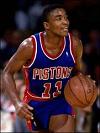
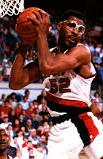
On June 9, 1981 the 1981 NBA Draft in New York City, broadcast on the USA Network sees 23 teams select 223 players in 10 rounds; 6'6" forward Mark Anthony Aguirre (1959-) of DePaul U. is drafted #1 by the Dallas Mavericks (#24) after his junior year, becoming the 2nd underclassman to be drafted #1 overall after Magic Johnson in 1979; 6'1" guard Isiah Lord Thomas III (1961-), a sophomore from Indiana U. is drafted #2 by the Detroit Pistons (#11), going on to be accused of freezing-out rookie Michael Jordan in the 1985 NBA All-Star Game, devising the Jordan Rules in 1988 to limit Jordan's offensive effectiveness, and walking out with his teammates with 7.9 sec. remaining in game 4 of the 1991 NBA Playoffs against Michael Jordan and the Bulls, causing Jordan to get him passed over for the 1992 Dream Team; Thomas leaves the Pistons in 1994 and becomes head coach of the Indiana Pacers in 2003, followed by the New York Knicks in 2006-8; 6'8" forward-center Charles Linwood "Buck" Williams (1960-), a junior from the U. of Md. (known for wearing goggles) is drafted #3 by the New Jersey Nets (#52), becoming rookie of the year and being selected to the All-Star Game in his rookie season, becoming the first time that the first three selections are college underclassmen; in 1989 after becoming the Nets' all-time leader in points, rebounds, games played, turnovers, rebounds per game, and free throws made, Williams is traded to the Portland Trail Blazers, followed in 1996-9 by the New York Knicks.
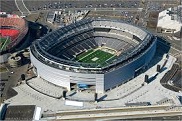
On July 2, 1981 the $85M Meadowlands Arena in East Rutherford, N.J. opens as the home of the New York Nets NBA team and the New Jersey Devils (formerly the Colo. Rockies) NHL team; it closes on Apr. 3, 2015 - with Jimmy Hoffa buried in one of its concrete pillars?


In 1981 Brooklyn, N.Y.-born New Orleans Jazz gen. mgr. (since 1979) Frank Layden (1932-) (asst. coach of the Atlanta Hawks in 1976-9) becomes head coach of the Utah Jazz, replacing Tom Nissalke, going on to draft John Stockton and Karl Malone and move into the team's front office in 1989 after being replaced by former Chicago Bulls player (1966-76) and coach (1978-82) Gerald Eugene "Jerry" Sloan (1942-), who coaches the Jazz to 15 straight playoff appearances in 1989-2003, leaving in 2011 after coaching for one team longer than anyone in NBA history with a 3rd place 1,221-803 record, becoming the 5th coach to reach 1K wins, and 3rd coach to reach 1K wins with one club.

On Feb. 15, 1982 6'9" future coach (1992-4, 1999-2001) Daniel Paul "Dan" Issel (1948-) of the NBA Nuggets (#44) begins a streak of 63 consecutive free throws.
On May 27-June 8, 1982 the 1982 NBA Finals sees the Los Angeles Lakers (coach Pat Riley) defeat the Philadelphia 76ers (coach Billy Cunningham) by 4-2; MVP is Magic Johnson of the Lakers.



On June 29, 1982 the 1982 NBA Draft at the Felt Forum in Madison Square Garden in New York City, broadcast on USA Network sees 23 teams select 46 players in two rounds; after the last-place Cleveland Cavaliers trade their first round draft pick for Don Ford in 1980, Gastonia, N.C.-born 6'9" goggle-wearing forward James Ager "Big Game" Worthy (1961-) of the U. of N.C. (junior) is selected #1 by the Los Angeles Lakers (#42), becoming known for his Statue of Liberty dunk and swooping finger roll, going on to p Robert Terrell "Terry" Cummings (1961-) of DePaul U. is selected #2 by the San Diego Clippers (#34), winning the rookie of the year award before switching to the Milwaukee Bucks (#34) in 1984-9, and the San Antonio Spurs (#34) in 1989-95; Paris, France-born 6'8" forward (dunking expert) Jacques Dominique "the Human Highlight Film" Wilkins (1960-) of the U. of Ga. (junior) is selected #3 by the Utah Jazz, who trade him to the Atlanta Hawks (#21) in exchange for John Drew and Freeman Williams, going on to average 20+ points per game, while Drew and Williams play a combined four seasons.
On May 13, 1983 "Mr. October" Reggie Martinez Jackson (1946-) of the Calif. Angels becomes the first ML baseball player to strike out 2,000x (until ?); he ends his careers with 2,597 strikeouts, followed y Andres Gallaraga (2,003), Alex Rodriguez (2,287), Sammy Sosa (2,306), Adam Dunn (2,379), and Jim Thorne (2,548).
On May 22-31, 1983 the 1983 NBA Finals sees the "Fo' fi' fo" Philadelphia 76ers (coach Billy Cunningham), incl. Julius Erving, center Moses Malone, Bobby Jones, Maurice Cheeks, and Andrew Toney defeat the Los Angeles Lakers (coach Pat Riley) by 4-0; MVP is Moses Malone of the 76ers; Kareem Abdul-Jabbar of the Lakers (oldest player in the playoffs at 35) showcases his signature skyhook, causing Brent Musburger to call him "The unstoppable one"; during the playoffs against the Milwaukee Bucks, the Philadelphia Inquirer paraphrases the famous John Havlicek call by Johnny Most with the soundbyte: "Bobby Jones stole the ball. It was grand larceny. Bobby Jones stole the ball and robbed the Milwaukee Bucks of a game, turning an almost-sure upset into a 111-109 overtime victory for the 76ers."
On Dec. 13, 1983 the Detroit Pistons defeat the Denver Nuggets 186-184 in triple OT in the highest combined regular season scoring game in NBA history(370) (until ?); a record four players score over 40 points; Kiki Vandewegh of the Nuggets scores a career high 51 points; the most field goals by two teams (142), most field goals by one team (74), most assists by two teams (93), the most points scored by one team (186), and the most points scored by a losing team (184).
In 1983 Bobby Jones of the Philadelphia 76ers wins the first NBA Sixth Man of the Year Award, followed by Kevin McHale of the Boston Celtics in 1984-5, and Bill Walton of the Boston Celtics in 1986.


On June 28, 1983 the 1983 NBA Draft at the Felt Forum in New York City, broadcast on the USA Network sees 23 teams select 226 players in 10 rounds; 7'4" Harrisonburg, Va.-born center-forward Ralph Lee Sampson Jr. (1960-) of the U. of Va. is selected #1 over all by the Houston Rockets (#50), becoming rookie of the year, then pairing with Hakeem Olajuwon in 1984 to become known as the Twin Towers; 6'7" New Orleans, La.-born guard-forward Clyde Austin "the Glide" Drexler (1962-) of the U. of Houston (part of the Phi Slama Jama fraternity incl. Hakeem Olajuwon and Larry Micheaux) is selected #14 by the Portland Trail Blazers (#22), moving to the Houston Rockets in 1995-8, then becoming coach at the U. of Houston in 1998-2000.
On Dec. 13, 1983 the Detroit Pistons defeat the Denver Nuggets 186-184 in triple OT in the highest combined scoring game in NBA history (until ?); Kiki Vandewegh of the Nuggets scores a career high 51 points.
On Jan. 11, 1984 the Denver Nuggets defeat the San Antonio Spurs by 163-55 in the highest combined scoring NBA regulation game of all time (218); Kiki Vandewegh of the Nuggets scores 50 points.
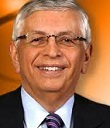
On Feb. 1, 1984 New York City-born David Joel Stern (1944-2020) becomes NBA Comissioner #4 (until Jan. 31, 2014), inheriting a dwindling viewership and watching it turn around with new players Michael Jordan, Hakeem Olajuwon, Charles Barkley, and John Stockton, going global.

On Apr. 3, 1984 Georgetown U. coach John Thompson Jr. (1941-) becomes the first black coach to win an NCAA basketball tournament.
On Apr. 5, 1984 Kareem Abdul-Jabbar of the Los Angeles Lakers passes Wilt Chamberlain to become NBA's all-time leader in points scored in a game against the Utah Jazz at the U. of Nev. in Las Vegas, Nev. (31,420).


On May 27-June 12, 1984 after Bernard King (1956-) overcomes a 102-deg. F. fever and two dislocated middle fingers to score 44 points for the New York Knicks to lead them to a 127-123 OT win in game 5 against the Detroit Pistons to clinch the Eastern Conference title in five games, and Isiah Lord "Zeke" "Pee Wee" "Mr. Wonderful" Thomas III (1961-) of the Pistons scores 35 points (King retires after the 1991 season having played for five teams), the 1984 NBA Finals sees the Boston Celtics defeat the Los Angeles Lakers 4-3; Larry Bird is awarded finals MVP.




On June 19, 1984 the 1984 NBA Draft at the Felt Forum in New York City, broadcast on USA Network sees 23 teams select 47 players in two rounds; 7'0" Nigerian-born Hakeem (Arab. "wise one") Abdul "the Dream" Olajuwon (1963-) is drafted #1 by the Houston Rockets, and the Portland Trail Blazers pass on him for #2 Samuel Paul "Sam" Bowie (1961-), after which 6'6" Michael Jeffrey "Air" Jordan (1963-) is drafted #3 by the Chicago Bulls (#23), going on to win six NBA championships and six finals MVP awards, five NBA MVP awards, 14 All-Star picks, two gold medals, two dunk contests et al.; in Mar. 1982 as a U. of N.C. freshman he made a jump shot that beat Georgetown to win the NCAA title; on Oct. 26 he scores 16 points in his first NBA game against the Boston Celtics, helping the Chicago Bulls win by 109-83; next May he wins the NBA rookie of the year award; Portland goes on to suffer 19 consecutive postseason exits and fail to make the playoffs in 2003-8, causing rumors that they are cursed; 6'1" relative unknown John Houston Stockton (1962-) (#12) of Gonzaga U. is drafted in the first round by the Utah Jazz, causing stunned silence in the Salt Palace, going on to become known as "the Iron Man", retiring in 2003 after becoming the first point guard to play into his 40s and holding the all-time records for assists and steals.
In the 1984-5 season after an agreement between the owners and the Nat. Basketball Players Assoc. (NBPA), the NBA institutes its first salary cap, which allows "salary exceptions" to sign key players, becoming the first in any major prof. sport.

On May 16, 1985 Michael Jeffrey "Air" Jordan (1963-), #23 of the Chicago Bulls wins the NBA Rookie of the Year award - uh-oh, spoke too soon?
On May 27-June 9, 1985 the 1985 NBA Finals sees the Los Angeles Lakers (coach Pat Riley) defeat the Boston Celtics (coach K.C. Jones) by 4-2; MVP is Kareem Abdul-Jabbar of the Lakers; Game 1 AKA the Memorial Day Massacre sees Boston defeat the Lakers by 148-114 after small forward Scott Wedman comes off the bench and hits all 11 of his shots incl. four 3-pointers, scoring 26 points total.








On June 18, 1985 the 1985 NBA Draft at the Felt Forum in New York City, broadcast by TBS Superstation sees 23 teams select 162 players in seven rounds (reduced from 10); after winning the first-ever NBA Draft Lottery on May 12, the New York Knicks select 7'0" Jamaican-born center Patrick Aloysius Ewing Sr. (1962-) (#33) of Georgetown U. #1 overall (until 2000), who goes on to win rookie of the year and become an 11x all-star; 6'9" Ft. Worth, Tex.-born Oklahoma U. junior Wayman Lawrence Tisdale (1964-2009) (center-forward) is selected #2 by the Indiana Pacers (#23), switching to the Sacramento Kings in 1989-94 and hooking up with Mitch "the Rock" Richmond in 1991, retiring in 1997 to become a smooth jazz bass guitarist; Christopher Paul "Chris" Mullin (1963-) of St. John's U. is selected #7 by the Golden State Warriors (#17), going on to become part of the Run TMC Trio incl. Tim Hardaway and Mitch Richmond; 6'10" German-born forward Detlef Schremp (1963-) of Washington U. is selected #8 by the Dallas Mavericks (#32) before being traded to the Indiana Pacers (#11) (1989-93), Seattle SuperSonics (#12) (1993-9), and Portland Trail Blazers (1999-2001); 6'9" Cleveland, Ohio-born power forward (great rebounder) Charles Oakley (1963-) of Virginia Union U. is selected #9 by the Chicago Bulls (#34), protecting Michael Jordan as his "cop" until 1988, when he is traded to the New York Knicks (#33) (until 1998), followed by the Toronto Raptors (1998-2001), Chicago Bulls (2001-2), Washington Wizards (2002-3), and Houston Rockets (2004); 6'9" Summerfield, La.-born power forward Karl Anthony "the Mailman" Malone (1963-) of Louisiana Tech U. is selected #13 by the Utah Jazz (#32) (until 2003), going on to appear in the playoffs every season in his career incl. the 1997 and 1998 NBA Finals before switching to the Los Angels Lakers (#11) in 2003-4, playing his 3rd Finals in 2004, racking up the most career postseason losses of any NBA player (95) (until ?); 6'3" Shreveport, La.-born guard Joe Dumars III (1963-) of McNeese State U. is selected #18 by the Detroit Pistons (#4), combining with Isiah Thomas to form one of the best backcourts in NBA history; 7'3" Lithuanian-born center Arvydas Romas Sabonis (1964-) of the prof. Zalgiris Kaunas team (1981-9) is selected #77 by the Atlanta Hawks, but their selection is voided because he's under 21; next year he is selected #24 by the Portland Trail Blazers, but is not allowed to play by the Soviet govt. until 1989, by which time he is suffering from an Achilles tendon and other injuries while helping the Soviet Union defeat the U.S. team in the 1988 Summer Olympics; he ends up signing with the Portland Trail Blazers (#11) in 1995-2001, becoming known as a 7'3" Larry Bird (Bill Walton), being named to the basketball hall of fame on Aug. 12, 2011 as the tallest player until 7'4" Ralph Sampson in 2012.
On Oct. 25, 1985 the Sacramento Kings play their first regular season game after moving from Kansas City, Mo., losing 108-104 to the Los Angeles Clippers.

In 1985 after playing on the 1984 gold medal women's Olympic basketball team, Wichita, Kan.-born Lynette Woodard (1959-) becomes the first woman to play with the Harlem Globetrotters, going on to play for the WNBA Cleveland Rockers in 1997 and the Detroit Shock in 1998.
In 1985 the United States Basketball League (USBL) is founded as a spring-summer league for aspiring NBA players; the Rhode Island Gulls go on to produce NBA stars Manute Bol, Spud Webb, John "Hot Rod" Williams, and Muggsy Bogues; it folds after the 2007 season.

In 1985 Italian-born Luigi "Geno" Auriemma (1954-) becomes head coach of the U. of Conn. Huskies women's basketball team, which has only one winning season so far, turning it around and winning 10 NCAA Div. 1 nat. championships by 2015, becoming head coach of the U.S. women's nat. basketball team in 2009-14, winning the 2010 and 2014 world championships and the gold medal at the 2012 Summer Olympics.
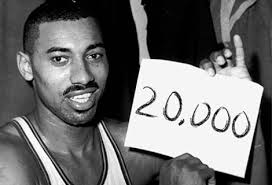
In the mid-1980s Rod Roddewig stays at the playboy penthouse of Wilt Chamberlain in Honolulu, and uses a Daytimer to clock him bedding 23 women in 10 days, using the number to calculate that he must have slept with 20K women since age 15, creating a legend; in 1999 he utters the soundbyte: “With all of you men out there who think that having a thousand different ladies is pretty cool, I have learned in my life I've found out that having one woman a thousand different times is much more satisfying."



On Feb. 8, 1986 5'7" Atlanta Hawks basketball player Anthony Jerome "Spud" Webb (1963-) wins the slam-dunk contest during All-Star Weekend, beating 6'8" defending champ Jacques Dominique Wilkins (1960-), "the Human Highlight Film", proving that size doesn't necessarily matter (but white men can't jump?); the shortest NBA player in history is 5'3" Tyrone Curtis "Muggsy" Bogues (1965-) (1987/8-2000/1); of the five shortest players in NBA history, three played for the Denver Nuggets: 5'7" Monte Towe, 5'7" Greg Grant, 5'5" Earl Boykins; 5'9" hall-of-famer Calvin Murphy is the most successful player under 6 ft., with a career avg. 17.9 points.
On Feb. 15, 1986 the largest NBA crowd to date numbers 44,180 with Philadelphia at Detroit.
On Apr. 13, 1986 the Celtics go 40-1 at home, becoming the best home record in NBA history (until ?).
On Apr. 20, 1986 2nd-year Chicago Bulls player Michael Jordan scores 63 points in Game 2 of a 1st-round Eastern Conference series against the Boston Celtics, becoming a high for the NBA playoffs; the Bulls lose 135-131 in double OT and are eventually swept; on May 26-June 8 the 1986 NBA Finals sees the Boston Celtics (coach K.C. Jones) defeat the Houston Rockets (coach Bill Fitch) by 4-2; MVP is Larry Bird of the Celtics.




On June 17, 1986 the 1986 NBA Draft at Felt Forum in New York City, broadcast by TBS Superstation sees 23 teams select a record 66 players who debut with the NBA, with second-rounders shining over first-rounders, incl. 6'7" small-power forward Dennis Keith "the Worm" Rodman (1961-) ("best rebounding forward in NBA history"), who is drafted as the 3rd pick (27th overall) by the Detroit Pistons (#10) to join the Bad Boys of head coach (1983-92) Charles Jerome "Chuck" Daly (1930-2009), incl. guards Isiah Thomas and Joe Dumars, forwards Adrian Dantley and Sidney Green, and center Bill Laimbeer, who end the runs of the Boston Celtics and Larry Bird, and the Los Angeles Lakers and Magic Johnson; Rodman goes on to lead the NBA in rebounds per game for a record seven straight years, and win five NBA championships, playing for the San Antonio Spurs in 1993-5, the Chicago Bulls in 1995-8, the Los Angeles Lakers in 1999, and the Dallas Mavericks in 2000; in 2008-9 the first Chuck Daly Lifetime Achievement Award is presented to Tommy Heinsohn, followed by Jack Ramsay and Tex Winter in 2009-10, Lenny Wilkens in 2010-11, Pat Riley in 2011-12, Bill Fitch in 2012-13, and Bernie Bickerstaff in 2013-14; 6'0" point guard William Mark Price (1964-) is selected #25 by the Dallas Mavericks, who believe the hype that he's too small and slow (and white?) and trade him to the Cleveland Cavaliers (#25), where he becomes the 2nd player after Larry Bird to join the NBA 50-40-90 Club (40% accuracy from 3-point range, 50% from the field, and 90% from the free throw line), setting the team record of 734 steals (broken on Dec. 9, 2008 by LeBron James), and pioneering the splitting of the double team, playing for three more teams and winning two NBA 3-Point Contests before retiring in 1998, then becoming a coach, seeing his hometown of Enid, Okla. rename their basketball arena in his name.

On June 19, 1986 less than 48 hours after being selected by the Boston Celtics in the 1st round of the NBA draft, black college basketball star (#34 for Maryland) Leonard Kevin "Len" Bias (b. 1963) dies from a cocaine OD, shocking the nation.

On Nov. 14, 1986 David Anspaugh's Hoosiers (Orion Pictures) debuts, loosely based on the 1954 Milan H.S. team, starring Gene Hackman as small town Hickory, Ind. h.s. basketball coach Norman Dale (based on Marvin Wood), who fights the players and the town to bring home the 1952 Ind. state championship; Maris Valainis plays star player Jimmy Chitwood (based on Bobby Plump); Barbara Hershey plays teacher Myra Fleener; Dennis Hooper plays basketball-loving drunk asst. coach Shooter Flatch; does $28.6M box office on a $6M budget.
On Apr. 22, 1987 the NBA expands to 27 teams; in 1988 the Charlotte Hornets plays in the new Charlotte Coliseum (24K cap.); the name refers to British Gen. Lord Cornwallis calling the town "a veritable hornet's nest of rebellion"; it becomes the first team to choose teal as its primary color, starting a fashion craze; they start off with Dick Harter as head coach, who recruits ex-Pistons guard Kelly Tripucka, first draft pick Rex Chapman, and 5'3" (shortest player in NBA history) Muggsy Bogues; on Nov. 4, 1988 their first regular season game is a 133-933 loss to the Cleveland Cavaliers at home before 23,388 fans (sold-out); on Nov. 8, 1988 they score their first win against the Los Angeles Clippers by 117-105; on Dec. 23, 1988 they defeat the Chicago Bulls by 103-1 after beating Michael Jordan at the buzzer in his first prof. game in N.C.; they finish their first season at 20-62 after leading the NBA in attendance, selling-out for 9 straight seasons (364 games); in the 1990 NBA Draft they select guard Kendall Gill, and win 8 of their first 15 games, then going flat and finishing with an 8-18 record; in the 1991 NBA Draft after hiring new gen. mgr. Allan Bristow they draft power forward Larry Johnson from UNLV, who wins 1992 NBA rookie of the year; after the 2001-2 season it moves to New Orleans, La., becoming the New Orleans Hornets, changing its name in 2013 to the New Orleans Pelicans, allowing the Charlotte Bobcats to become the Charlotte Hornets.


On May 17, 1987 the San Antonio Spurs win the 1987 NBA Draft Lottery, paving the way for the 1987 NBA Draft in Felt Forum in New York City on June 22 (23 teams, 7 rounds) (last to go over three rounds), when they pick 7'1" superstar center (1989-2003) David Maurice "the Admiral" Robinson (1965-) (#50) #1 overall, who joins the NBA in the 1989-90 season after serving in the U.S. Navy, and who in 1997 with 6'11" teammate (power forward/center) Timothy Theodore "Tim" Duncan (1976-) (#21). become known as the Twin Towers.
On June 2-14, 1987 the 1987 NBA Finals sees the mostly-black Los Angeles Lakers win with a 106-93 home-court V over the mostly-white defending champion Boston Celtics; Magic Johnson of the Lakers is MVP.
On Oct. 23-25, 1987 the first McDonald's Championship (Open) in Milwaukee, Wisc. becomes the first tournament between the NBA and FIB, incl. the Milwaukee Bucks, the Soviet nat. team, and the Italian nat. team; in 1991 it becomes biannual; it ceases after 1999 after the NBA wins them all.
On Apr. 26, 1988 after experimenting in 1978-9, the NBA permanently adds a 3rd referee.
On June 7-21, 1988 the 1988 NBA Finals is won 4-3 by the Los Angeles Lakers over the Detroit Pistons.
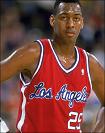




On June 28, 1988 the 1988 NBA Draft in Felt Forum in New York City sees 25 teams select 75 players in three rounds (reduced from seven); 6'10" Hattiesburg, Miss.-born power forward Daniel Ricardo "Danny" Manning (1966-) of the U. of Kansas (son of Ed Manning) is selected #1 by the Los Angeles Clippers (#5/#25), switching in 1994 to the Atlanta Hawks (#5) then the Phoenix Suns (#15) (until 1999), ending up as a coach at his alma matter (until 2012), followed by Wake Forest U. (2014-); 7'4" Netherlands-born center ("the Dunkin' Dutchman") Rik Smits (1966-) of Marist College is selected #2 by the Indiana Pacers (#24/#45), playing his entire career for them (until 2000); 6'5 Ft. Lauderdale, Fla.-born shooting guard Mitchell James "Mitch" Richmond (1965-) of Kansas State U. is selected #5 by the Golden State Warriors (#23), winning rookie of the year as part of coach Don Nelson's fast-paced Run TMC offense with Tim Hardaway and Chris Mullin, then being traded for Billy Owens to the Sacramento Kings (#2) in 1991-8, becoming their first star, becoming their top scorer every year; 6'3" Chicago, Ill.-born Hersey R. "Hawk" Hawkins Jr. (1966-) of Bradley U. is selected #6 by the Los Angeles Clippers, who trade him to the Philadelphia 76ers (#33) for Charles Smith (until 1993), becoming their #2 scorer after Charles Barkley; 6'6" Traverse City, Mich.-born guard-forward Daniel Lewis "Dan" Majerle (1965-) of Central Mich. U. is selected #14 by the Phoenix Suns (#9), and is booed by the audience, causing coach Cotton Fitzsimmons to tell them: "You'll be sorry you ever booed this man"; he ends up become a big star, moving to the Cleveland Cavaliers in 1995 and Miami Heat in 1992 before returning in 2001-2, with his number retired by the Suns after his last season; in 2008-13 he becomes an asst. coach for the Suns.
On July 25, 1988 the Atlanta Hawks defeat the Soviet team by 85-4, becoming the first NBA team to play in the Soviet Union.
On Sept. 17-30, 1988 the 12th Olympic Basketball Tournament at the 1988 Summer Olympics in the Jamsil Gymnasium in Seoul, South Korea sees the Soviet Union men's basketball team incl. Arvydas Sabonis win gold (2nd and last time), Yugoslavia win silver, and the U.S. team incl. Mitch Richmond, Hersey Hawkins, Dan Majerle, Danny Manning, Charles Smith, and David Robinson win bronze; the U.S. women's basketball team incl. Cynthia Cooper repeats their 1984 gold performance, Yugoslavia wins silver, and the Soviet Union wins bronze.


In 1988 the Miami Heat NBA team is founded, hiring Pat Riley as head coach #1, who acquires 6'10" center-forward Alonzo Harding "Zo" "the Ultimate Warrior" Mourning Jr. (1970-) and 6'0" point guard Timothy Duane "Tim" Hardaway Sr. (1966-).
In 1988 the Minnesota Timberwolves (T-Wolves) NBA team is founded, named after a contest produces two leading candidates, and the loser "Polars" is rejected by 842 Minn. city councils by 2-1; on Nov. 3, 1989 they lose their first regular season game to the Seattle SuperSonics by 106-94 on the road; on Nov. 8, 1989 they lose to the Chicago Bulls by 96-84 in their home debut in the Hubert H. Humphrey Metrodome; they go 22-60 in their first season after drawing a record 1M attendance, incl. 49,551 (3rd largest ever) on Apr. 17, 1990 in a 98-88 loss to the Denver Nuggets in their final season home game; in 1990 they move to the Target Center, finishing 29-53 for the season.
In 1988 the Orlando Magic NBA team is founded, winning its first exhibition game on Oct. 13, 1989 against the Detroit Pistons; on Nov. 4, 1989 it loses by 111-106 to the New Jersey Nets in Orlando; on Nov. 6, 1989 it wins its first regular season game, defeating the New York Knicks by 118-110; the first season record is 18-64.

In 1988 former U.N.C. Wilmington player (#11) John Vincent Calipari (1959-) becomes head coach of the U. of Mass. (UMass), coaching them to five straight Atlantic 10 titles and a 193-71 record, winning the nat. coach of the year award in 1996 before moving to the NBA New Jersey Nets in 1996-9, then the U. of Memphis in 2000-9, becoming known for the Memphis Attack (dribble drive motion offense), followed by the U. of Ky. in 2009-.
On Apr. 8, 1989 the IBA allows the NBA to send players to the Olympics.
On June 6-13, 1989 the 1989 NBA Finals sees the Detroit Pistons complete a 4-0 sweep of the Los Angeles Lakers to win their first NBA championship; they go on to end the Lakers and Celtics dynasties and delay the start of the Bulls dynasty despite their anti-social behavior and roughhousing playing style by Rick Mahorn (who likes to throw forearms), Dennis Rodman (throws elbows), and Bill Lambeer (throws fits); other key players are Isiah Thomas, Joe Dumars, and Vinnie "Microwave" Johnson.



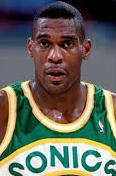
On June 27, 1989 the 1989 NBA Draft in Felt Forum in New York City sees 27 teams select 54 players in two rounds (down from three); 8 of the top ten picks turn out bad, incl. #1 Pervis Ellison, and #2 Danny Ferry; 6'8" Tucson, Ariz.-born small forward Sean Michael Elliott (1968-) of the U. of Ariz. is selected #3 by the San Antonio Spurs (#32); 6'8" Flint, Mich.-born small forward Glen Anthony Rice Sr. (1967-) of the U. of Mich. is selected #4 by the Miami Heat (#41); in 2011 Joe McGinniss pub. The Rogue: Searching for the Real Sarah Palin, in which he claims that Sarah Palin had an affair with Rice in 1987; 6'0" point guard Timothy Duane "Tim" Hardaway Sr. (1966-) is selected #14 by the Golden State Warriors (#5/#10), becoming part of Run TMC with Mitch Raymond and Chris Mullin, losing the 1991 playoffs to the Los Angeles Lakers in five games after 8 steals in game 2, setting a record for worst shooting performance (0 for 17) in a 106-102 win against the Minnesota Timberwolves on Dec. 27, 1991, then sitting out the 1993-4 season with a knee injury, reaching 5K points and 2.5K assists in 262 games, faster than any NBA player except Oscar Robertson (247); in the middle of the 1995-6 season he is traded with Chris Gatling to the Miami Heat (#10) in exchange for Kevin Willis and Bimbo Coles, sitting out most of the 2000-1 season with a kidney disease, becoming Miami's all-time leader in assists (1,947) (beaten by Dwayne Wade on Jan. 16, 2010); on Aug. 22, 2001 he is traded to the Dallas Mavericks (#10), starting only 2 of 54 games beored being traded in the middle of the season to the Denver Nuggets (#10) in 2002 in exchange for Nick Van Exel, starting 14 games and getting suspended for 2 games for throwing a TV onto the court, then retiring to work for ESPN until he signs with the Indiana Pacers (#14) on Mar. 27, 2003, going on to become asst. coach of the Detroit Pistons on Aug. 7, 2014 (until ?); 6'10" power forward Shawn Travis "Reign Man" Kemp (1969-) of Trinity Valley Community College, known for his dominating tomahawk slam dunk is selected #17 by the Seattle Supersonics (#40), teaming with Gary Payton to lead the team to the 1996 NBA Finals and losing to the Chicago Bulls before moving to the Cleveland Cavaliers (#4) in 1997-2000, the Portland Trail Blazers (#40) in 2001-2, and the Orlando Magic (#40) in 2002-3.
On Nov. 9, 1989 Dale Ellis of the Seattle Supersonics plays 69 of 73 min. in a 5-OT game vs. the Milwaukee Bucks.
On Feb. 7, 1990 Lisa Leslie of Morningside H.S. in Inglewood, Calif. scores 101 points in a single half in 16 min. in a basetball game against South Torrance H.S., causing the loser team to quit at halftime, robbing her of the chance to break Cheryl Miller's nat. record of 105 points in a game despite being allowed to make four foul shots at the start of the 2nd half, which are disqualified.
On June 5-14, 1990 the 1990 NBA Finals is won 4-1 by the Detroit Pistons over the Portland Trail Blazers; MVP is Isiah Thomas.
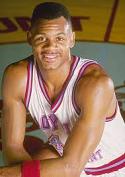

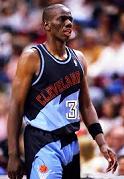
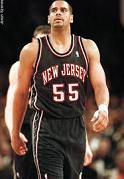

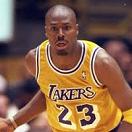
On June 27, 1990 after top media pick Eric "Hank" Gathers (1967-90) of Loyola Marymount U. (#44) dies of heart failure during a game on Mar. 4, the 1990 NBA Draft at Felt Forum in New York City, broadcast on TNT sees 27 teams select 54 players in two rounds; forward-center Derrick Coleman of Syracuse U. is selected #1 by the New Jersey Nets; 6'4" point guard Gary Dwayne "the Glove" Payton (1968-) of Oregon State U. (#20), known for his defensive play is selected #2 by the Seattle SuperSonics (#20), setting franchise records in points, assists, and steals, becoming the first point guard to win the NBA defensive player of the year award in 1996, moving to the Milwaukee Bucks (#20) in 2003, the Los Angeles Lakers (#20) in 2003-4, the Boston Celtics (#20) in 2004-5, and the Miami Heat (#20) in 2005-7; 6'9 power forward Tyrone Hill (1968-) of Xavier U., the ultimate "lunch pail and hard hat player" is selected #11 by the Golden State Warriors (#32), moving to the Cleveland Cavaliers (#32) in 1993-97, the Milwaukee Bucks (#42) in 1997-9, the Philadelphia 76ers (#40) in 1999-2001, where he teams with Theo Ratliff and later with Dikembe Mutombo before finishing with the Miami Heat (#32) in 2003; 6'10" forward-center Jayson Williams (1968-) of St. John's U. is selected #21 by the Phoenix Suns, who trade him to the Philadelphia 76ers (#55), riding the bench before moving to the New Jersey Nets (#55) in 1992-9, finally becoming a starter in the 1996-97 season, leading the NBA in offensive rebounds and offensive rebound percentage; on Apr. 1, 1999 he collides with teammate Stephon Marbury in a game against the Atlanta Hawks, breaking his right leg and ending his career, retiring on June 28, 2000; in 2010 he pleads guilty to the accidental shooting death of limo driver Costas "Gus" Christofi at his estate in Alexandria Township, N.J. and serves 18 mo. in prison before being released in Apr. 2012; 6'9" forward-center Antonio Lee Davis (1968-) of UTEP is selected #45 by the Indiana Pacers, deciding to play in Europe instead, returning to the NBA as a free agent, signing with the Indiana Pacers (#33) in 1993, becoming part of the Davis Brothers tandem of power forwards with Dale Davis before moving to the Toronto Raptors (#33) in 1999-2003, the Chicago Bulls (#34) in 2003-5, and the New York Knicks (#32) in 2005-6; too bad, on Jan. 18, 2006 Davis sees Michael Axelrod, son of Barack Obama's campaign mgr. David Axelrod messing with his wife in the stands, and goes into the stands to confront him, drawing a 5-game suspension on Jan. 19; on Feb. 3, 2006 he is traded for Jalen Rose to the Raptors, starting eight games then missing 12 with a back injury, causing them to release him on Mar. 23; 6'7" small forward Cedric Z. Caballos (1969-) of Cal State Fullerton is selected #48 by the Phoenix Suns (#23/#1), scoring an NBA high 57.6% field goal percentage in 1992-3 before moving to the Los Angeles Lakers (#23) in 1994-7, leading them in scoring in 1994-5 with a 21.7 avg., sitting out the 1995-6 season with an injury, then leading the Lakers again with a 21.2 avg. incl. the Lakers' first 50-point game in 20+ years in 1995, winning the 1992 NBA Slam Dunk Contest with a blindfolded dunk and playing for Mexico in the 1992 Summer Olympics before returning to the Suns in 1997-8, moving to the Dallas Mavericks (#23) in 1998-2000, the Detroit Pistons (#23) in 2000, and the Miami Heat (#23) in 2000-1; he goes on to leave the NBA and play for a variety of teams incl. the ABA Las Vegas Slam (2002), Harlem Globetrotters (2002), and teams in Israel (2002), Russia (2002-3), and the Philippines (2003-4).
On Nov. 2, 1990 the Golden State Warriors defeat the Denver Nuggets by 162-158 in McNicholas Arena, setting the NBA record for most points scored by two teams in a non-OT game (320).
On Nov. 2, 1990 the first major sports event to be played by a U.S. team outside North Am. sees the NBA Phoenix Suns defeat the Utah Jazz by 119-96 in Tokyo, Japan; on Nov. 3 the Jazz win by 102-101.

On Dec. 30, 1990 Scott Allen Skiles (1964-) of the Orlando Magic (#4) scores an NBA record 30 assists in 155-116 win over the Denver Nuggets, breaking Kevin Porter's record of 29, going on to win the NBA most improved player award.
In 1990 Georgia Tech in Atlanta has a big sports year, with its basketball team reaching the NCAA Final Four and its football team winning a share of the nat. championship (11-0-1).
On June 2-12, 1991 the 1991 NBA Finals (first broadcast by NBC-TV after 17 years with CBS-TV) sees the Chicago Bulls win their first NBA championship, defeating the Los Angeles Lakers (coach Mike Dunleavy) by 4-1; MVP is Michael Jordan of the Bulls.

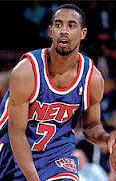


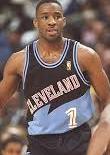
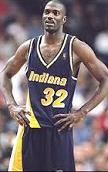
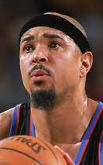
On June 26, 1991 the 1991 NBA Draft at Felt Forum in New York City sees 27 teams select 54 players in two rounds, becoming the last NBA draft held in New York City until 2001; 6'6" forward Larry Demetric "LJ" "Grandmama" Johnson (1969-) of UNLV is selected #1 by the Charlotte Hornets (#2), winning the rookie of the year award and getting voted to the 1993 All-Star Game (first Hornet), gaining the nickname "Grandmama" from a Converse commercial, then spraining his back on Dec. 27, 1993 in a game against the Detroit Pistons and missing 31 games and getting into friction with Alonzo Mourning, causing both to be traded, with Mourning traded to the Miami Heat for Glen Rice and Matt Geiger, and Johnson traded to the New York Knicks (#2) for Anthony Mason and Brad Lohaus, getting into trouble during the 1999 NBA Finals for calling the Knicks "rebellious slaves" on a plantation, and complaining how everybody else in his old hood "ended up dead, in jail, on drugs, selling drugs", retiring on Oct. 10, 2001 after converting to the Nation of Islam in ?; 6'10" point guard Kenneth "Kenny" Anderson (1970-) of Georgia Tech is selected #2 by the New Jersey Nets (#7), becoming the youngest player in the NBA, moving to the Charlotte Hornets (#12) in 1996, the Portland Trail Blazers (#7) in 1996-8, the Boston Celtics (#7) in 1998-2002, and five other NBA teams before leaving the NBA to play for Zalgiris Kaunas in Lithuania in 2005-6; Congolese-born 7'2" center ("Mount Mutombo") Dikembe Mutombo (Dikembe Mpolondo Mukamba Jean-Jacques Wamutombo) (1966-2024) of Georgetown U., known for his defensive play and fluent in 9 languages is selected #4 by the Denver Nuggets (#55), moving to the Atlanta Hawks (#55) in 1996-2001, the Philadelphia 76ers (#55) in 2001-2, the New Jersey Nets (#55) in 2002-3, the New York Knicks (#55) in 2003-4, and the Houston Rockets (#55) in 2004-9, injuring his knee in round 1 of the 2009 NBA playoffs and announcing his retirement; 6'8" shooting guard Steven Delano "Steve" Smith (1969-) of Mich. State U. is selected #5 by the Miami Heat (#3), moving to the Atlanta Hawks (#8) in 1994-9, the Portland Trail Blazers (#8) in 1999-2001, the San Antonio Spurs (#8) in 2001-3, helping them win a championship in 2003, the New Orleans Hornets (#8) in 2003-4, and the Charlotte Bobcats (#8) in 2004-5 before being traded for Malik Allen to the Miami Heat (#8) in 2005, retiring after becoming one of three players to make seven 3-pointers in a single quarter; 5'11" point guard Thomas Terrell Brandon (1970-) of the U. of Oregon is selected #11 by the Cleveland Cavaliers (#11/#1), sitting behind Mark Price for four years until he leaves in 1995, then being called "the best point guard in the NBA in a 1997 issue of Sports Illustrated, winning the 1997 NBA Sportsmanship Award for his work with underprivileged youth; in Sept. 1997 he and Tyrone Hill are traded to the Mulwaukee Bucks (#1) in exchange for Shawn Kemp, moving to the Minnesota Timberwolves (#7) in 1999-2002 and teaming with mentor Chauncey Billups before being placed on the injured list on Feb. 13, 2002; on July 23, 2003 he is traded to the Atlanta Hawks (#?), then waived on Feb. 17, 2004, retiring on Mar. 9 6 points short of 10K career points, with five games in which he scored 16 assists; 6'11" forward-center Elliott Lydell "Dale" Davis (1969-) of Clemson U. (#34) is selected #13 by the Indiana Pacers (#32), becoming their all-time leader in rebounds and start wearing a headband on the court before moving to the Portland Trail Blazers (#34) in 2000-4, the Golden State Warriors (#32) in 2004-5, the Indiana Pacers in 2005, and the Detroit Pistons (#34) in 2005-7; 6'10" power forward Chris Raymond Gatling (1967-) of Old Dominion U. is selected #16 by the Golden State Warriors (#25), getting tomahawk slam dunked by Shawn "Reign Man" Kemp of the Sonics in Game 4 of the 1992 playoffs, who then stares Gatling down, causing Gatling to accept the humiliation and high-five and dap him up, permanently scarring his career; after setting an NBA field goal percentage record in the 1994-5 season of 0.633, he is traded midway through the 1995-6 season along with Tim Hardaway to the Miami Heat (#15), going on to play for six more NBA teams before moving to Europe to play for CSKA Moscow in Russia in 2002, and Scavolini Pesaro in Italy in 2003; in 2013 he is accused of squatting in a house in Ariz. for 13 mo. and attempting to rent it out on Craigslist.

On Nov. 7, 1991 LA Lakers basketball star Earvin "Magic" Johnson Jr. (1959-) announces that he is HIV-positive, offering to retire for fear of infecting others, returning to play in the 1992 All-Star Game and winning the MVP award, then retiring again for four years, returning in 1996 to play 32 games for the Lakers before retiring for the last time.
On Dec. 21, 1991 the 100th anniv. of the invention of basketball by Dr. James Naismith is celebrated in Springfield, Mass. with a gala featuring players Julius Erving, George Mikan, Bob Kurland, Rick Barry, and coach John McLendon.

On Mar. 27, 1992 Ron Shelton's White Men Can't Jump (20th Cent. Fox) debuts, written by Ron Shelton, starring Woody Harrelson as white basketball hustler Billy Hoyle, who teams up with black hustler Sidney Deane (Wesley Snipes) to scam suckers who think that you know what; Rosie Perez plays Hoyle's Jeopardy-loving babe Gloria Clemente; does $90.7M box office.
On June 3-14, 1992 the 1992 NBA Finals sees the Chicago Bulls (coach Phil Jackson) defeat the Portland Trail Blazers (coach Rick Adelman) 4-2, giving them their 2nd straight NBA title; Michael Jordan becomes MVP for the 2nd straight year.



On June 24, 1992 the 1992 NBA Draft in Portland, Ore. sees 27 teams select 54 players in two rounds; 7'1" 325 lb. center (size 22 shoe) Shaquille ("Little Warrior") Rashaun "Shaq" O'Neal (1972-) of LSU is selected #1 by the Orlando Magic (#?), winning the rookie of the year award, moving to the Los Angeles Lakers (#34) and winning championships in 2000, 2001, and 2002 before developing friction with Kobe Bryant and being traded to the Miami Heat (#?) in 2004, winning his 4th championship in 2006 before being traded to the Phoenix Suns (#?) midway through the 2007-8 season, moving to the Cleveland Cavaliers (#33) in 2009-10, and the Boston Celtics (#36) in 2010-11; 6'10" center-forward Alonzo Harding "Zo" "the Ultimate Warrior" Mourning Jr. (1970-) of Georgetown U., known for his tenacious defense is selected #2 by the Charlotte Hornets (#33), becoming the runner-up to Shaquille O'Neal for rookie of the year, moving to the Miami Heat (#33) in 1995-2002, and the New Jersey Nets (#33) in 2003-4, undergoing a kidney transplant on Dec. 19, 2003, and returning to the Heat (#?) on Mar. 1, 2005 after being traded to the Toronto Raptors and failing to pass the physical, working for a minimum salary as backup to O'Neal until injuring his right knee on Dec. 19, 2007, then retiring on Jan. 22, 2009; 6'11" forward-center Christian Donald Laettner (1969-) of Duke U. (#32) (star player in the 1991 and 1992 nat. championship teams, and the only college player on the 1992 Dream Team) is selected #3 by the Minnesota Timberwolves (#32), moving to the Atlanta Hawks (#32) in 1996-9, the Detroit Pistons (#32) in 1999-2000, the Dallas Mavericks (#32) in 2000-1, the Washington Wizards (#44) in 2001-4, the Miami Heat (#44) in 2004-5, finishing with the ABA Jacksonville Giants in 2011-12; forward Tom Gugliotta of N.C. State U. is selected #6 by the Washington Bullets; guard Harold "Baby Jordan" Miner of USC (junior) is selected #12 by the Miami Heat; guard Latrell Sprewell of the U. of Ala. is selected #24 by the Golden State Warriors.
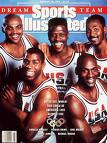

On July 25-Aug. 9, 1992 the XXV (25th) Summer Olympics are held in Barcelona, Spain; the U.S. Basketball Dream Team, coached by Detroit Pistons head coach (1983-92) Charles Jerome "Chuck" Daly (1930-2009) incl. NBA stars Michael Jordan, Magic Johnson, Larry Bird et al., and wins gold, beating eight opponents by an avg. of 44 points, causing basketball to explode in popularity worldwide, rivalling soccer; it is followed by Dream Team II at the 1994 FIBA World Championship, and Dream Team III at the 1996 Olympic Games in Atlanta, Ga.
In 1992 the Nat. Basketball Retired Players Assoc. (NBRPA) (Legends of Basketball) is founded in New York City by NBA hall-of-famers Oscar Robertson, Dave DeBusschere, Dave Cowens, Dave Bing, and Archie Clark, becoming the official alumni org. for the NBA, ABA, WNBA, and Harlem Globetrotters.

On Mar. 24, 1993 after passing Calvin Murphy's 1981 record of 78 by making his final 84 attempts in the 1992-3 season, followed by his first 13 attempts in 1993, 6'2" Micheal Douglas Williams (1966-) of the Minn. Timberwolves (#24) makes the first of an NBA record 97 straight free throws (until ?) in 19 regular season games (ends Nov. 9).


On May 4, 1993 Phoenix Suns power forward (#32) "Sir" Charles Wade Barkley (1963-), mad about being called a "punk" in Game 2 of a 1st-round Western Conference NBA series comes back in Game 3 and scores 27 points in the first quarter, 56 points total, and 14 rebounds, causing the Suns to sweep the Golden State Punks, er, Warriors 140-133; on June 9-20 the 1993 NBA Finals sees the Chicago Bulls defeat the Phoenix Suns 4-2 for their 3rd straight title (first since the Boston Celtics); Game 6 (99-98) (first won by the home team) is clinched by a 3-pointer by point guard (#5) John MacBeth Paxson (1960-), who becomes the Bulls gen. mgr. in 2003-9; superstar basketball player (#23) Michael Jordan (1963-) becomes MVP for the 3rd straight year, after which on Oct. 6 he announces his retirement.
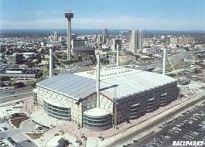
On May 15, 1993 the $200M Alamodome in San Antonio, Tex. opens, putting the city on the ML baseball map, also serving as the home of the NBA San Antonio Spurs; on Sept. 10 78K fans fill the dome to watch Julio Cesar Chavez win a 12-round decision against Pernell Whitaker, for the largest indoor boxing audience in history.

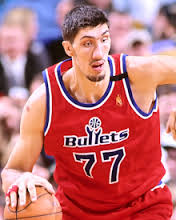
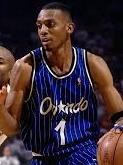
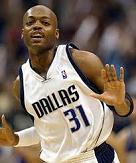

On June 30, 1993 the 1993 NBA Draft in Auburn Hills, Mich. sees 27 teams select 54 players in two rounds; 6'10" forward-center Mayce Edward Christopher "Chris" "C-Webb" Webber III (1973-) of the U. of Mich. (#4) (sophomore) is selected #1 by the Orlando Magic, who trade him to the Golden State Warriors (#4) in exchange for Anfernee Hardaway, winning the rookie of the year award, moving to the Washington Bullets (#2) in 1994-8, the Sacramento Kings (#4) in 1998-2005, the Philadelphia 76ers (#4) in 2005-7, the Detroit Pistons (#84) in 2007, and back to the Warriors (#4) in 2008; 6'7" guard-forward Anfernee Deon "Penny" Hardaway (1971-) of Memphis State U. (#25) (junior) (known for having incredible size and quickness for a point guard, drawing comparisons to Magic Johnson) is selected #3 by the Golden State Warriors, who trade him for Chris Webber to the Orlando Magic (#1), taking over as point guard from Scott Skiles and teaming with Shaquille O'Neal, scoring his first career triple double on Apr. 15 against the Boston Celtics and becoming runner-up for rookie of the year to Chris Webber, sitting out most of the 1997-8 season with a left knee injury before being traded to the Phoenix Suns (#1) in 1999, moving to the New York Knicks (#1) in 2004-6; on Aug. 9, 2007 he returns to the Miami Heat (#7), reuniting with O'Neal until he is waived on Dec. 12 for Luke Jackson; forward Jamal Mashburn of the U. of Ky. (junior) is selected #4 by the Dallas Mavericks; forward Vin Baker of the U. of Hartford is selected #8 by the Milwaukee Bucks; guard Allan Houston of the U. of Tenn. is selected #11 by the Detroit Pistons; guard Sam Cassell of Fla. State U. is selected #24 by the Houston Rockets; 7'7" Romanian-born center Gheorghe Dumitru "George" "Ghita" "Gidza" "My Giant" Muresan (1971-) of Pau-Orthez U. in France is selected #30 by the Washington Bullets (#77), moving to the New Jersey Nets (#77) in 1999-2000, and the ABA Maryland Nighthawks in 2005-6; 6'1" guard Nickey Maxwell "Nick the Quick" Van Exel (1971-) of the U. of Cincinnati, known for his flashy play is selected #37 by the Los Angeles Lakers (#9), teaming with Eddie Jones; in 1996 in a game against the Denver Nuggets he pushes a referee, drawing a 7-game suspension; on June 24, 1998 he is traded for Tony Battie and Tyronn Lue to the Denver Nuggets (#31); on Feb. 21, 2002 he traded for Tim Hardaway, Juwan Howard, and Donnell Harvey to the Dallas Mavericks (#31); on Aug. 18, 2003 he is traded in a multiplayer exchange to the Golden State Warriors (#37); on July 20, 2004 he is traded in exchange for Dale Davis and Dan Dickau to the Portland Trail Blazers (#19) in 2004-5, playing only 53 games; on Aug. 3, 2005 he is waived, and on Aug. 29 signs with the San Antonio Spurs (#31), retiring on May 24, 2006 after being knocked out of the playoffs by the Dallas Mavericks due to knee and elbow problems, going into coaching; 6'7" Merced, Calif.-born small forward Bruce E. Bowen Jr. (1971-) of Cal State Fullerton U. goes undrafted, going on to play in 1993-5 in France before ending up playing for the San Antonio Spurs (#12) in 2001-9.

On July 23, 1993 basketball star Michael Jordan's father James Raymond Jordan Sr. (b. 1936) is murdered in a roadside robbery as he sleeps in his car near Fayetteville, N.C., stealing his $40K Lexus (a gift from his son) and two NBA championship rings; his body is not discovered until Aug. 3 in a creek near McColl, S.C.; too bad, the dopes make calls from their victim's cell phone and are caught, and on Sept. 7 a grand jury indicts Larry Martin Demery (1977-) of Rowland, N.C. and Daniel Andre Green (1974-) of Lumberton, N.C. for the murder, and they both get life in priz. On Oct. 6, 1993 Michael Jordan announces his retirement after leading the Chicago Bulls to their 3rd straight NBA championship in June.
On Nov. 4, 1993 the NBA expands to 28 teams with the Toronto Raptors after John Bitove agrees to pay a record $125M expansion fee; they pick the name after the 1993 film "Jurassic Park" after Huskies is rejected as too similar to Timberwolves, causing a nat. contest with 2K entries; the first head coach is Isiah Thomas; team colors are bright red, purple, black, and "Naismith silver".
On Feb. 7, 1994 after retiring from the Chicago Bulls in 1993 after his three-peat, Michael Jordan honors a dream of his late father and signs a minor league baseball contract with the Chicago White Sox, reporting to spring training in Sarasota, Fla.; on Nov. 1, 1994 Jordan's jersey number 23 is retired by the Bulls in a ceremony which incl. the unveiling of the sculpture "The Spirit" outside the new United Center; in the 1993-4 season the Bulls go 55-27, falling to 31-31 by Mar. 18, 1995, when Jordan announces his return with the soundbyte "I'm back", receiving jersey number 45, going on to lead them to another three-peat in 1996-8.

On Feb. 18, 1994 William Friedkin's Blue Chips (Paramount Pictures) debuts, filmed in French Lick, Ind., starring Nick Nolte as Western U. Dolphins basketball coach Pete Bell, who pays "blue chip" prospects under the table, incl. giving a Lexus to Neon Boudeaux (Shaquille O'Neal) (film debut) and a house and job to the mother of Butch McRae (Anfernee "Penny" Hardaway), which is exposed by sportswriter Ed (Ed O'Neill); Mary McDonnell plays Pete's wife Jenny; J.T. Walsh plays shady school booster Happy Kuykendahl; features cameos by Bob Knight, Larry Bird, Bob Cousy, Jim Boeheim, Jerry Tarkanian, Matt Painter, Louis Gossett Jr. et al.; does $23M box office on a $35M budget.
On Apr. 27, 1994 the NBA expands to 29 teams with the Vancouver Grizzlies, playing at Gen. Motors Place; after the 2000-1 season it relocates to Memphis, Tenn., becoming the Memphis Grizzlies, playing at the Pyramid Arena; in fall 2004 they move to the FedExForum.
On June 8-22, 1994 the 1994 NBA Finals sees the Houston Rockets (coach Rudy Tomjanovich) win their first NBA title by 4-3, defeating the New York Knicks (coach Pat Riley) 90-84 in Game 7 after trailing three games to two.
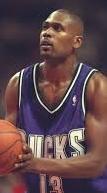

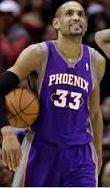
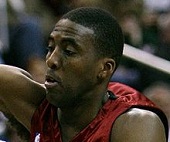
On June 29, 1994 the 1994 NBA Draft in Indianapolis, Ind. sees 27 teams draft 54 players in two rounds; 6'7" small forward Glenn Alann Robinson Jr. (1973-) of Purdue U. (#13) (junior) is selected #1 by the Milwaukee Bucks (#13), demanding a 13-year $100M contract before settling for a 10-year $68M contract, the richest NBA rookie contract ever, causing the NBA to implement a fixed salary cap next year; Robinson moves to the Atlanta Hawks (#13) in 2003-2, the Philadelphia 76ers (#31) in 2003-5, sitting out the 2004-5 season due to injury before being traded on Feb. 24, 2005 to the New Orleans Hornets in exchange for Rodney ROgers and Jamal Mashburn, never suiting up, then signing on Apr. 4, 2005 with the San Antonio Spurs (#3), helping them win the 2005 NBA championship before retiring; 6'4" point guard Jason Frederick Kidd (1973-) of the UCB (#5) (sophomore) is drafted #2 by the Dallas Mavericks (#2), sharing the rookie of the year award with Grant Hill, helping them improve their record from the league worst 13-69 to 36-46 before moving to the Phoenix Suns (#32) in 1996-2001, the New Jersey Nets (#5) in 2001-8, the Dallas Mavericks (#2) in 2008-12, and the New York Knicks (#5) in 2012-13, going on to become head coach of the Brooklyn Nets in 2013-14, and the Milwaukee Bucks in 2014-; 6'8 small forward Grant Henry Hill (1972-) of Duke U. (#33) is drafted #3 by the Detroit Pistons (#33), sharing rookie of the year with Jason Kidd, moving to the Orlando Magic (#33) in 2000-7, contracting MRSA from an ankle operation in Mar. 2003, moving to the Phoenix Suns (#33) in 2007-12, and the Los Angeles Clippers (#33) in 2012-13; forward Juwan Howard of the U. of Mich. (junior) is drafted #5 by the Washington Bullets; the last draft to see all first three picks make All-Star rosters with the teams that originally drafted them (until ?); 6'6" shooting guard Eddie Charles Jones (1971-) of Temple U. is selected #10 by the Los Angeles Lakers (#25/#6), rising to starting shooting guard in 1995-6 and being compared to Michael Cooper before moving to the Charlotte Hornets in 1999-2000, the Miami Heat in 2000-2005, the Memphis Grizzlies in 2005-7, back to the Miami Heat in 2007, and the Dallas Mavericks in 2007-8.
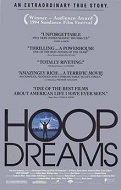
On Oct. 14, 1994 Steve James' Hoop Dreams (Oct. 14) (Kartemquin Films) (Fine Line Features) is a documentary of two inner-city basketball players, Arthur Agee and William Gates trying to go from high school to the NBA, showing the long odds they face; does $11.8M box office on a $700K budget; watch film.
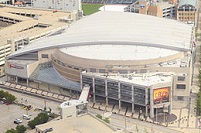
On Oct. 17, 1994 $100M Quicken Loans Arena (AKA The Q) in Cleveland, Ohio opens as the home of the NBA Cleveland Cavaliers.


On Nov. 8, 1994 before changing from shooting guard to point guard when teammate Isiah Thomas retires at the end of the season, 6'3 Joe Dumars III (1963-) (#4) of the Detroit Pistons ties Brian Shaw's NBA record of 10 3-pointers in 18 attempts, finishing with 40 points in a 126-112 win over the visiting Minnesota Timberwolves; on Apr. 18, 1996 6'8" small forward Dennis Eugene Scott (1968-) (#3) of the Orlando Magic makes 11 3-pointers against the Atlanta Hawks.
On Nov. 15, 1994 KAZN-AM in Los Angeles, Calif. becomes the first to broadcast an NBA game in Mandarin Chinese, a Lakers-Clippers game.

On Feb. 1, 1995 6'1" point guard "Iron Man" John Houston Stockton (1962-) (#12) of the Utah Jazz becomes the all-time NBA steals leader, breaking Magic Johnson's record of 9,221 in a game in Salt Lake City against the Denver Nuggets with 6:22 left in the first half with a bounce pass to Karl Malone, ending up with 9,227 in a 129-98 win; his 860th game, vs. 874 for Johnson.


On Mar. 19, 1995 Michael Jordan returns to the NBA in a game with the Indiana Pacers, scoring a rusty 19 points; on June 6 the Orlando Magic defeat the Indiana Pacers 105-81 to win the Eastern Conference and advance to the NBA Finals. On June 7-14 the 1995 NBA Finals sees the #6 seed Houston Rockets (coach Rudy Tomjanovich), led by Hakeem "the Dream" Olajuwon (1963-) defeat the Orlando Magic (coach Brian Hill), led by Shaquille Rashaun O'Neal (1972-) 113-101 to sweep in four games (4-0) and win their 2nd consecutive title; next year O'Neal leaves Orlando for the Los Angeles Lakers with a 7-year contract worth $120M, only to be on the injured list with knee problems for 28 games between Feb. and Apr.










On June 28, 1995 the 1995 NBA Draft at the SkyDome in Toronto, Ont., Canada (first draft held outside the U.S., and first draft for the Canadian expansion teams the Toronto Raptors and Vancouver Grizzlies) sees 29 teams select 58 players in 2 rounds; 6'10" power forward Joseph Leynard "Joe" Smith (1975-) of the U. of Md. (sophomore) is selected #1 by the Golden State Warriors (#32), going on to become one of the NBA's most-traded players; 6'9" power forward Antonio Keithflen McDyess (1974-) of the U. of Ala. (a sopohomore) is selected #2 by the Los Angeles Clippers, who trade him to the Denver Nuggets (#24), after which knee injuries cause his career to spiral downward, ending his career with the San Antonio Spurs (#34), 2009-11; 6'6" guard Jerry Darnell Stackhouse (1974-) of the U. of N.C. (sophomore) is selected #3 by the Philadelphia 76ers (#42), getting billed as "the Next Jordan", and being selected as Sports Illustrated's player of the year, teaming with Allen Iverson in the 1996-7 season, scoring a combined 44.2 points per game, moving to the Detroit Pistons (#24) in 1998-2002, scoring a team record 57 points in a late 2001-2 season V over the Chicago Bulls before being traded to the Washington Wizards (#42) in 2002, leading them in points and assists until a knee injury forces him to sit out most of the 2003-4 season, then moving to the Dallas Mavericks (#42) in 2004-9; 6'11" forward-center Rasheed Abdul "Sheed" Wallace (1974-) of the U. of N.C. (sophomore) is selected #4 by the Washington Bullets (#30), moving to the Portland Trail Blazers (#36) in 1996-2004, going on to become the NBA leader in personal fouls (300), receiving 41 in 80 games in the 2000–01 season; 6'11 power forward Kevin Maurice Garnett (1976-) of Farragut Academy H.S. in Chicago, Ill. is selected #5 by the Minnesota Timberwolves (#11), becoming the first NBA player drafted out of h.s. since 1975, moving to the Boston Celtics (#5) in 2007-13, and the Brooklyn Nets (#2) in 2013-15 before returning to the Timberwolves in 2015; 5'10" point guard Damon Lamon Stoudamire (1973-) of the U. of Ariz. is selected #7 by the Toronto Raptors (#20), winning rookie of the year then getting into trouble numerous times for marijuana; 6'3" guard Shawn Christopher Respert (1972-) of Mich. State U. is selected #8 by the Portland Trail Blazers, who trade him to the Milwaukee Bucks (#3), moving to the Toronto Raptors (#31) in 1997-8, the Dallas Mavericks (#21) in 1998, and the Phoenix Suns (#2) in 1999, hiding stomach cancer until 2005 and only playing four seasons in the NBA; in Sept. 2003 he becomes an asst. coach for the Memphis Grizzlies; after helping his team win the 1995 NCAA championship on a bad knee, 6'8" forward Edward Charles "Ed" O'Bannon Jr. (1972-) of UCLA (#31) is selected #9 by the New Jersey Nets, going on to become a big bust who only plays two years in the NBA, later filing the class action lawsuit O'Bannon v. NCAA, later joined by Oscar Robinson, attempting to end the use of former student athlete images for commercial purposes, winning a judgment on Aug. 8, 2014; 6'10" forward-center Theophalus Curtis "Theo" Ratliff (1973-) of the U. of Wyo. is selected #18 by the Detroit Pistons (#42), going on to be traded several times and lead the NBA in shot-blocking 3x, retiring in 2011; 6'7" forward-guard Michael Howard Finley (1973-) of the U. of Wisc. (#24) is selected #21 by the Phoenix Suns (#4), scoring over 1K points in his rookie season, moving to the Dallas Mavericks (#4) in 1996-2005 and becoming part of the Run & Gun Offense along with guard Steve Nash and forward Dirk Nowitzki, then to the San Antonio Spurs (#4) in 2005-10, becoming the backup to Manu Ginobili and helping win the 2007 NBA championship, being awarded the game ball by his teammates, finishing his career with the Boston Celtics (#40) in 2010.

In 1995 Tom Izzo (1955-) becomes head coach of the Michigan State. U. Spartans basketball team (until ?), turning the team (located near depressed Detroit, Mich.) around and leading them to nat. championships in 2000 and 2009, becoming the winningest coach in school history with his 341st win on Nov. 9, 2009, becoming known as "Mr. March".
In 1995 the Internat. Basketball Assoc. (IBA) is founded in Alexandria, Minn. with five teams by Thomas Anderson, growing to 18 teams before merging with the CBA and IBL, continuing under the CBA name.

White men can jump? On Feb. 11, 1996 the 1996 NBA All-Star Game at the Alamodome in San Antonio, Tex. sees the East defeat the West by 129-118; Michael Jordan of the Bulls is MVP; 6'7" guard Brent Robert Barry (1971-) (son of Rick Barry) of the Los Angeles Clippers becomes the first Caucasian player to win the 1996 NBA Slam Dunk Contest with a Julius Erving copycat slam dunk from the free throw line.
On Feb. 16, 1996 Radio Shack spokesman Shaquille O'Neill scores his only 3-pt. shot in 12 straight NBA games.
On Apr. 21, 1996 the Chicago Bulls defeat the Washington Wizards to finish the season with an NBA-best record of 72-10.

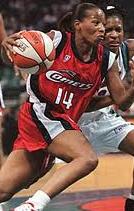


On Apr. 24, 1996 the all-female Woman's Nat. Basketball Assoc. (WNBA) is founded as a counterpart to the all-male NBA, beginning play in May 1997, using an oatmeal and orange game ball developed by Spalding; it starts out with eight teams incl. the Houston Comets (1997-2008), Cleveland Rockers (1997-2003), New York Liberty, Phoenix Mercury, Sacramento Monarchs (1997-2009), Los Angeles Sparks, Charlotte Sting (1997-2007), and Utah Starzz (San Antonio Silver Stars in 2003); the first player drafted is 6'0" Olympic gold medal winner ("female Michael Jordan") Sheryl Denise Swoopes (1971-) (#22), who goes to the Houston Comets (until 2007); the Comets also draft 5'10" Olympic gold medal winner Cynthia Lynne Cooper (Cooper-Dyke) (1963-) (#14); 5'8" Pineland, Tex.-born guard Teresa Gaye "T-Spoon" Witherspoon (1965-) is drafted by the New York Liberty (#11), going on to win the WNBA's first defensive player of the year award in 1997, and again in 1998; by 2003 she becomes the only WNBA player to start every one of her games; on June 21, 1997 the first WNBA game sees the New York Liberty play the Los Angeles Sparks; the first 1997 WNBA Finals sees the Houston Comets defeat the New York Liberty by 65-51; MVP is Cynthia Cooper; the Comets and Cooper repeat in 1998-2000, after which Cooper retires with 2.5K+ career points incl. 30+ points in 16 of 120 games and a 92-game double-figure scoring streak; in 1998 they expand to 12 teams, adding the Orlando Miracle, and Minnesota Lynx; San Antonio Stars, Tulsa Shock; in 1999 they add the Connecticut Sun, and Minnesota Lynx; in 2000 they add the Indiana Fever, Portland Fire (2000-2), Miami Sol, and Seattle Storm; on May 23, 2000 the Houston Comets become the first WNBA team and first women's sport teams to visit the White House; in 2001 after Cynthia Cooper retires, the Los Angeles Sparks, led by 6'5" Olympic star Lisa Deshaun Leslie (1972-) (#9) sweep the Charlotte Sting in the 2001 WNBA Finals, and defeat the New York Liberty in the 2002 WNBA Finals; in 2006 the WNBA adds the Chicago Sky, followed in 2008 by the Atlanta Dream.

On Apr. 26, 1996 Steve Gomer's Sunset Park (TriStar Pictures) debuts, produced by Danny DeVito et al., starring Rhea Perlman as novice boys' basketball coach Phyllis Saroka in Sunset Park H.S. in a black neighborhood of New York City, who coaches them to a city championship in Madison Square Garden; the soundtrack features Ghostface Killah; does $10M box office.
On June 16, 1996 the 1996 NBA Finals sees the 72-10 Chicago Bulls (coach Phil Jackson) defeat the Seattle SuperSonics (coach George Karl) 87-75 in game 6 to win their 4th NBA championship in six years.

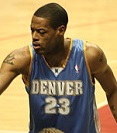
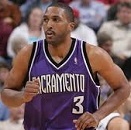
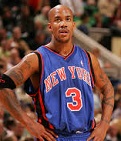
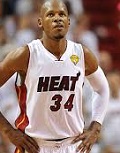

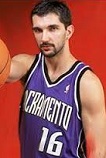



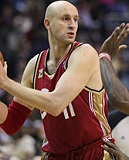

On June 26, 1996 the 1996 NBA Draft in East Rutherford, N.J., broadcast by TNT-TV sees 29 teams select 58 players in two rounds, becoming the best draft since 1984 (best of all time?); 6'0" guard Allen Ezail Iverson (1975-) of Georgetown U. (sophomore) is selected #1 by the Philadelphia 76ers (#3), winning the rookie of the year award, scoring a record 40+ points in five straight games in 1997, and becoming the NBA scoring champion in 1999, 2001-2, and 2005, and the NBA steals leader in 2001-3 before moving to the Denver Nuggets (#3) in 2006-8, the Detroit Pistons (#1) in 2008-9, the Memphis Grizzlies (#3) in 2009, and back to the 76ers (#3) in 2009-10 before playing for Besiktas in Turkey in 2010-11; 6'11" Hartford, Conn.-born center Marcus D. Camby (1974-) of the U. of Mass. (junior) is selected #2 by the Toronto Raptors (until 1998), moving to the New York Knicks in 1998-2002, and the Denver Nuggets (#23) in 2002-8, going on to become a defensive star and leader in blocked shots; 6'9" Marietta, Ga.-born forward Shareef Abdur-Rahim (1976-) (Muslim) of the UCB (freshman) is selected #3 by the Vancouver Grizzlies (#3) (until 2001), becoming their star before moving to the Atlanta Hawks in 2001-4, the Portland Trail Blazers in 2004-5, sharing the NBA record for most games played without a playoff appearance before moving to the Sacramento Kings in 2005-8, retiring after right knee problems; 6'2" Brooklyn, N.Y.-born point guard Stephon Xavier Marbury (1977-) of Georgia Tech (freshman) is selected #4 by the Milwaukee Bucks, who trade him to the Minnesota Timberwolves (until 1999), moving to the new Jersey Nets in 1999-2001, making NBA All-Star, then the Phoenix Suns in 2001-4, the New York Knights in 2004-9, and the Boston Celtics in 2010; 6'5" shooting guard Walter Ray Allen Jr. (1975-) of the U. of Conn. (junior) is selected #5 by the Minnesota Timberwolves, who trade him to the Milwaukee Bucks (#20) (until 2003), moving to the Settle SuperSonics (#34) in 2003-7, the Boston Celtics (#20) in 2007-12, and the Miami Heat (#34) in 2012-14, going on to become a 10-time NBA All-Star and win two NBA championships (2008, 20013), along with an Olympic gold medal in 2000, retiring as the NBA all-time career leader in 3-pointers in both the regular and postseason; 6'9" forward Antoine Devon Walker (1976-) of the U. of Ky. (sophomore) is selected #6 by the Boston Celtics (#8) (until 2003) 6'6" shooting guard Kobe Bean "Black Mamba" "KB24" Bryant (1978-) of Lower Merion H.S. in Penn., son of NBA player Joe Bryant, named after the Japanese dish Kobe beef is selected #13 by the Charlotte Hornets, who trade him to the Los Angeles Lakers (#8/#24) (until 2016); 6'9" Croatian-born forward Predrag "Peja" Stojakovic (1977-) of PAOK in Greece is selected #14 by the Sacramento Kings (#16) (until 2006), retiring in 2011 with 1,760 career 3-pointers; 6'3" Johannesburg, South Africa-born point guard Stephen John "Steve" Nash (1974-) of the U. of Santa Clara is selected #15 by the Phoenix Suns (#13) (until 1998), followed by the Dallas Mavericks in 1998-2004, back to the Suns in 2004-12, and the Los Angeles Lakers in 2012-15, going on to win the NBA MVP award 2x; forward-center Jermaine Lee O'Neal (1978-) of Eau Claire H.S. in Columbia, S.C. is selected #17 by the Portland Trail Blazers #5 (until 2000), moving to the Indiana Pacers in 2000-8; 7'3" center Zydrunas Ilgauskas (1975-) of Atletas in Lithuania is selected #20 by the Cleveland Cavaliers (#11)(until 2010), teaming with LeBron James and Drew Gooden in 2003; 6'9" White Hall, Ala.-born power forward Ben Camey Wallace (1974-) of Virginia Union U. goes undrafted, and signs wth the Washington Bullets (#30), moving to the Orlando Magic (#4) in 1999-2000, the Detroit Pistons (#6) in 2000-6, the Chicago Bulls (#?) in 2006-8, the Cleveland Cavaliers (#?) in 2008-9, and the Detroit Pistons in 2009-12.
On Nov. 2, 1996 the Miami Heat defeats the Indiana Pacers by 97-95, making Heat head coach Pat Riley the 8th NBA head coach to win 800 games in a record 2 weeks short of 15 years.

On Nov. 15, 1996 Joe Pytka's Space Jam (Warner Bros.) debuts, featuring basketball superstar Michael Jordan playing ball against animated evil intergalactic invaders seeking to capture Bugs Bunny and the rest of the Looney Tunes chars.; features the hit song I Believe I Can Fly, by R. Kelly; does $230M box office on an $80M budget.

On Dec. 27, 1996 after the Suns lose their first 13 games, disgruntled 6'4" point guard Jason Frederick Kidd (1973-) of the Dallas Mavericks is traded to the Phoenix Suns (#32), turning the team around, winning 10 in a row and improving the team's win total by 16 games with a 56-26 record; he goes on to lead the New Jersey Nets to two straight NBA Finals appearances in 2002-3, then wins his only NBA championship with the Mavericks in 2011; after retiring after the 2012-13 season, he becomes head coach for the new Brooklyn Nets, followed in 2014 by the Milwaukee Bucks (until ?).
In 1996 the Am. Basketball League (ABL) for women is founded as a rival to the WNBA, playing during the winter; it starts out signing a majority of the players from the 1996 U.S. women's nat. team, with higher salaries than the WNBA; too bad, it folds on Dec. 22, 1998 after playing 12-15 games of the 1998-9 season.
In 1996 the Ed Martin (U. of Mich. Basketball) Scandal begins when an investigation of an automobile accident during a recruiting trip uncovers payments by Wolverines booster Ed Martin to U. of Mich. men's basketball players Chris Webber, Maurice Taylor, Robert Traylor, and Louis Bullock; Webber is convicted of lying to a 1999 federal grand jury and fined, briefly suspended by the NBA, and stripped of his 1993 All-American honors; Traylor is stripped of his MVP awards in the 1997 NIT and 1998 Big Ten Tournament; in 1997 coach Steve Fisher is fired.

On Jan. 28, 1997 6'6" Philly-born Kobe Bean "Black Mamba" "KB24" Bryant (1978-) becomes the youngest player (18 years, 158 days old) to start an NBA basketball game as he plays for the Los Angeles Lakers (#8) against the Dallas Mavericks; at the start of the 2006-7 season he changes his jersey number from 8 to his h.s number of 24.
On Feb. 9, 1997 the NBA announces its 50 Greatest NBA Players of All Time.
On June 1-13, 1997 the 1997 NBA Finals sees the Chicago Bulls (coach Phil Jackson) defeat the Utah Jazz (coach Jerry Sloan) by 4-2; Michael Jordan is MVP for the 5th straight time.

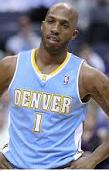
On June 25, 1997 the 1997 NBA Draft in Charlotte, N.C. sees 29 teams select 57 players in two rounds; Virgin Islands-born 6'11" forward-center Timothy Theodore "Tim" Duncan (1976-) of Wake Forest U. (#21) (who switched from swimming to basketball after 1989 Hurricane Hugo destroyed the only Olympic-size pool on St. Croix) is selected #1 by the San Antonio Spurs (#21) (until 2016), winning the rookie of the year award, going on to team up with David Robinson and become known as the Twin Towers; 6'3" guard Chauncey Ray "Mr. Big Shot" Billups (1976-) of the U. of Colo. (#4) (sophomore) is selected #3 by the Boston Celtics (#4), playing 51 games until he is traded by Kenny Anderson to the Toronto Raptors (#3) in 1998, moving after a few months to the Denver Nuggets (#1) in 1999, who trade him to the Orlando Magic (#2), staying on the injured list with a shoulder injury until he is traded to the Minnesota Timberwolves (#4) in 2000, playing backup to point guard Terrell Brandon, who suffers a serious knee injury in the 2001-2 season, allowing Billups to finally shine and become a free agent, signing in June 2002 with the Detroit Pistons (#1), helping them win the 2004 championship, after which on Nov. 3, 2008 he is traded to the Denver Nuggets (#7/#1) along with Antonio McDyess and Cheikh Samb for Allen Iverson, leading them to the 2009 conference finals, scoring 32 points in a 128-125 win over the New York Knicks (teammate Carmelo Anthony scores 50), and 39 points incl. 9 3-pointers in a road win over the Los Angeles Lakers on Feb. 5, 2010; on Feb. 22, 2011 despite wanting to finish his career in Denver he is traded to the New York Knicks (#4) as part of the Carmelo Anthony deal, suffering a knee injury in game 1 of the 2011 NBA playoffs, causing them to put him on waivers in Dec. 2011 despite a change of mind about playing there, and on Dec. 12, 2011 the Los Angeles Clippers (#1) claim him; too bad, on Feb. 7, 2012 after playing only 20 games an MRI reveals a tear in his Achilles tendon, playing in only 22 games in the 2012-13 season; on July 16, 2013 he signs with the Detroit Pistons (#1), missing most of the season then retiring on Sept. 9, 2014; guard-forward Tracy McGrady of Mt. Zion Christian Academy in Durham, N.C. is selected #9 by the Toronto Raptors; 6'11" Dublin, Ireland-born Patrick John "Pat" Burke (1973-) of Auburn U. goes undrafted, signing with the Orlando Magic (#31) in 2002-3, becoming the NBA's first Irish player.
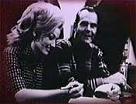
On Sept. 25, 1997 the newly-forming NBA Nashville Predators team adopts a saber-toothed cat (Smilodon) logo after the first skeleton E of the Mississippi River was discovered in 1971 during the construction of the First Am. Nat. Bank in downtown Nashville, Tenn. by Willow Springs, Mo.-born anthropologist Robert Bruce "Bob" Ferguson Sr. (1927-2001), Nashville record exec and composer of the song "On the Wings of a Dove".
On Nov. 7, 1997 the Sacramento Kings' record 497 straight sellout streak ends.

On Dec. 2, 1997 the $260M Verizon Center in Washington, D.C. (cap. 20K) opens as the new home of the NHL Washington Capitals, NBA Washington Wizards, the WNBA Washington Mystics, and the Georgetown U. men's basketball team.
In 1997 the Nat. Women's Basketball League (NWBL) is founded in the U.S to play games during the WNBA off-season starting in fall; it folds in 2007.
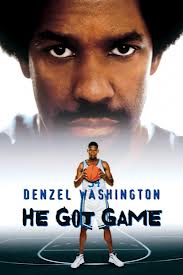
On May 1, 1998 Spike Lee's He Got Game (Buena Vista Pictures) debuts, starring Denzel Washington as Attica convict Jake Shuttlesworth, and Ray Allen as his estranged sun, er, son Jesus, who is a top h.s. basketball player, who must agree to play for the state governor's alma mater Big State to get daddy's sentenced reduced; Milla Jovovich plays hotel ho Dakota; soundtrack by Public Enemy; does $21.5M box office on a $25M budget.
On June 3-14, 1998 the 1998 NBA Finals sees the Chicago Bulls (coach Phil Jackson) defeat the Utah Jazz (coach Jerry Sloan) by 4-2 after Michael Jordan steals the ball from Karl Malone in Game 6 and sinks an 18-ft. jump shot over Byron Russell with only 5.2 sec. left to play, helping the Chicago Bulls to defeat the Utah Jazz 87-86 in game 6 and win their 3rd straight title (6th during the 1990s); this is MVP Jordan's last game with the Bulls, scoring 45 points, incl. 16 in the 4th quarter and all of their last 8 points in the final 2 min. 6 sec.; this game marks 25K+ regular season games and 5M+ points scored in the NBA - what a drag it is getting old?


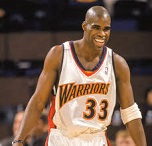
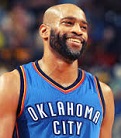
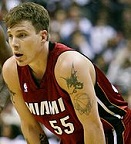

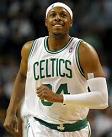

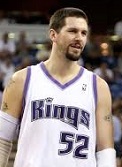
On June 24, 1998 the 1998 NBA Draft at General Motors Palace in Vancouver, Canada sees 29 teams select 58 players in two rounds; Nigerian-born 7'0" center Michael Olowokandi (1975-) of the U. of Pacific (#55) is selected #1 by the Los Angeles Clippers (#34), playing for Kinder Bologna in Italy during the 1998-9 NBA Lockout first, then moving to the Minnesota Timberwolves (#34) in 2003-6, and the Boston Celtics (#41) in 2006-7, becoming one of the biggest draft busts in NBA history, plagued by lack of skills, inconsistency, and injuries; 6'2" point guard (reliable clutch performer) Michael "Mike" Bibby (1978-) of the U. of Ariz. (sophomore) is selected #2 by the Vancouver Grizzlies (#10), who in 2001 trade him to the Sacramento Kings (#10), followed in 2008 by the Atlanta Hawks, in 2011 by the Washington Wizards, in 2011 by the Miami Heat, and in 2011-2 by the New York Knicks (#20); 6'9" power/small forward Antawn Cortez Jamison (1976-) of the U. of N.C. (junior) is selected #4 by the Toronto Raptors, who trade him to the Golden State Warriors (#33) for Vince Carter, turning them around; in 2003 he is traded to the Dallas Mavericks, followed in 2004 by the Washington Wizards, winning the NBA Sixth Man Award in 2004, in 2010 by the Cleveland Cavaliers, in 2012 by the Los Angeles Lakers (#4), and in 2013-4 by the Los Angeles Clippers; 6'6" guard-forward Vincent Lamar "Vince" Carter (1977-) of the U. of N.C. (junior) is selected #5 by the Golden State Warriors, who trade him to the Toronto Raptors (#15), winning the NBA Rookie of the Year Award; in 2004 he is traded to the New Jersey Nets (#15), followed in 2009 by the Orlando Magic, in 2010 by the Phoenix Suns, in 2011 by the Dallas Mavericks (#25), in 2014 by the Memphis Grizzlies (#15), and in 2017 by the Sacramento Kings; on Feb. 23, 2012 Pres. Obama praises Carter as "a huge treat for me ever since he's been playing for the Tar Heels"; 6'1" flashy point guard Jason Chandler "White Chocolate" Williams (1975-) of the U. of Fla. (junior) is selected #7 by the Sacramento Kings, who also sign Chris Webber, turning them around; in 2001 he is traded to the Memphis Grizzlies, followed in 2005 by the Miami Heat (#55), helping them win the 2006 NBA Championship, then in 2009 to the Orlando Magic, and back in 2011 to the Grizzlies; 7'0" power forward Dirk Werner Nowitzki (1978-) of DJK Wurzburg in Germany is selected #9 by the Milwaukee Bucks, who trade him and Steve Nash to the Dallas Mavericks (#41) for Robert Traylor, helping turn them around, going on to become one of the top power forwards of all time, becoming one of seven players to paly 20+ seasons in the NBA and the 2nd to do it with a single franchise, also becoming the first non-Am. player to win the Naismith Legacy Award on Dec. 10, 2012; 6'7" small forward Paul Anthony "The Truth" Pierce (1977-) of the U. of Kansas (junior) is selected #10 by the Boston Celtics (#34), going on to become their captain and sold star player for nine seasons before forming the Big Three with Kevin Garnett and Ray Allen in 2007 that leads the Celtics to the NBA Finals in 2008 and 2010, winning the 2008 NBA Championship, winning the Finals MVP award, scoring 20K+ points (along with Larry Bird and John Havlicek) before being traded to the Brooklyn Nets in 2013, followed by the Washington Wizards in 2014, and the Los Angeles Clippers in 2015-7; 6'10" small/power forward Rashard Quovon Lewis (1979-) of Alief Elsik H.S. in Houston, Tex. (USA Mr. Basketball) is selected #32 by the Seattle SuperSonics (#7), who in 2007 trade him to the Orlando Magic (#9), followed in 2010 by the Washington Wizards, and in 2012-14 by the Miami Heat (#9); 7'0" Kendallville, Ind.-born center-forward Bradley Alan "Brad" Miller (1976-) of Purdue U. goes undrafted, signing with the Charlotte Hornets (#40), followed by the Chicago Bulls (#52) (2002-2), Indiana Pacers (2002-3), and Sacramento Kings (#52) (2003-9), ending up playing for six NBA teams.
On July 1, 1998 the 1998-9 NBA Lockout starts after owners refuse to raise the min. salary and begin a lockout, forcing the regular season down to 50 games and causing the All-Star Game to be canceled; it ends on Jan. 6 after the Nat. Basketball Players Assoc. (NBPA) agrees to max player salaries and a pay scale for first-year players, after which TV ratings and ticket sales go on a multi-season slump.
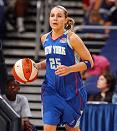
On May 12, 1999 Rapid City, S.D.-born Colo. State U. Rams star Rebecca "Becky" "Big Shot" Hammon (1977-) signs with the WNBA New York Liberty (#25), taking over in 2004 from Teresa Witherspoon as the starting point guard and becoming a co-captain with Vickie Johnson and Crystal Robinson; in 2008 she becomes a naturalized Russian citizen, playing for the Russian team in the 2008 and 2012 Olympics; on Aug. 5, 2014 she becomes the first full-time female asst. coach in the NBA and first in a major prof. sport in North Am. when she signs with the San Antonio Spurs.
On June 16-25, 1999 after a shortened season (by 32 games), the 1999 NBA Finals sees the San Antonio Spurs (coach Gregg Popovich) defeat the New York Knicks (coach Jeff Van Gundy) by 4-1 to win their first NBA title in 26 years; MVP is Tim Duncan of the Spurs.
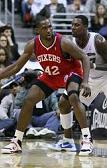

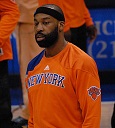
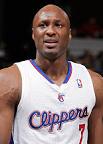
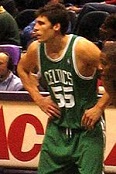
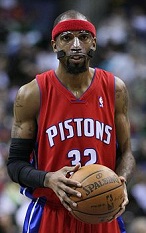
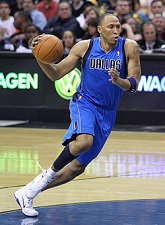



On June 30, 1999 the 1999 NBA Draft at the MCI Center in Washington, D.C. sees 29 teams select 58 players in two rounds; 6'9" forward-center Elton Tyron Brand (1979-) of Duke U. (sophomore) (1999 nat. college player of the year), known for his athleticism and wing span is selected #1 by the Chicago Bulls (#42), moving to the Los Angeles Clippers (#42) in 2001-8, who match an offer worth $82M over six years from the Miami Heat in 2003, after which he moves to the Philadelphia 76ers (#42) in 2008-12, the Dallas Mavericks (#42) in 2012-3, and the Atlanta Hawks (#42/#7) in 2013-; 6'3" guard Steve D'Shawn Francis (1977-) of the U. of Md. (junior) is selected #2 by the Vancouver Grizzles, who trade him to the Houston Rockets (#1) (until 2004), where he becomes known as "the Franchise" for his flashy dunks, crossover dribble, and driving ability; 6'3" guard Baron Walter Louis Davis (1979-) of UCLA (sophomore) is selected #3 by the Charlotte Hornets, moving to the Golden State Warriors in 2005-8, and the Los Angeles Clippers in 2011; 6'10" forward Lamar Joseph Odom (1979-) of the U. of R.I. (freshman) is selected #4 by the Los Angeles Clippers (#7), getting into trouble for violating the NBA's drug policy before moving to the Miami Heat in 2003-4, and the Los Angeles Lakers in 2004-11, teaming with Ron Artest to win the 2010 NBA title; 6'7" forward Walter Robert "Wally" Szczerbiak (1977-) of Miami U. is selected #6 by the Minnesota Timberwolves (#10) (until 2006), setting a franchise record of 44 points on Apr. 13, 2003, ending up plagued with knee injuries and being traded to the Boston Celtics (#55) in 2006, the Seattle SuperSonics in 2007, and the Cleveland Cavaliers (#10) in 2008, retiring in 2009; 6'7 guard Richard Clay "Rip" Hamilton (1978-) of the U. of Conn. (junior) is selected #7 by the Washington Wizards (#32), moving to the Detroit Pistons (#32) in 2002-11, becoming known for wearing a clear plastic face mask to cover his nose (after breaking it twice), which he calls his "Superman cape", leading the Pistons to the NBA title in 2004; 6'7" forward Shawn Dwayne Marion (1978-) of UNLV (junior) is selected #9 by the Phoenix Suns (#31) (unti 2008), earning the nickname "The Matrix" from Kenny Smith of TNT for his athleticism and versatility; 6'7" small forward Ronald William "Ron" Artest Jr. (1979-) of St. John's U. (sophomore), known for his quick hands and tough schoolyard style of play is selected #16 by the Chicago Bulls (#15), moving to the Indiana Pacers (#15) in 2002-6, getting into the Pacers-Pistons Brawl (Malice at the Palace) on Nov. 19, 2004 with the Detroit Pistons at the Palace of Auburn Hills incl. Pistons center Ben Wallace after a spectator throws a drink at him and he enters the crowd, after which 9 players are suspended for a total of 146 games, and he is suspended for the rest of the season (86 games) (longest suspension for an on-court incident in NBA history until ?); he goes on to play for the Sacramento Kings (#93) in 2006-8, the Houston Rockets (#96) in 2008-9, the Los Angeles Lakers (#37/#15) in 2009-13, and the New York Knicks (#51) in 2013-14, after which he leaves the NBA and plays in China for the Sichuan Blue Whales in 2014, and in Italy for Pallacenestro Cantu in 2015-; on Sept. 16, 2011 he changes his name to Metta World Peace; forward Andrei Gennadyevich "AK-47" Kirilenko (1981-) (born in Izhevsk, Russia, home of the AK-47 rifle) of CSKA Moscow in Russia is selected #24 by the Utah Jazz (until 2011); 6'6" Buenos, Argentina-born shooting guard Emanuel David "Manu" Ginobili (Ginóbili) (1977-) of Viola Reggio Calabria in Italy is selected #57 by the San Antonio Spurs (#20), not playing for the NBA until 2002, becoming one of the biggest draft steals of all time after he becomes a star, winning four championships and the 2008 NBA sixth man of the year award, becoming the 2nd player after Bill Bradley to win a EuroLeague title, an NBA championship, and an Olympic gold medal.
On Oct. 12, 1999 Wilt Chamberlain (b. 1936) dies in Bel-Air, Calif. of heart failure; on Nov. 8 the Philadelphia 76ers pay tribute to him when hosting the Seattle SuperSonics with a moment of silence and a video highlight of his 1962 100-point game, inviting Teddy Pendergrass to sing the national anthem - didn't want to have to break in another 20K women after the millennium?

On Oct. 17, 1999 $375M Staples Center in Los Angeles, Calif. opens, becoming the home of the Los Angeles Lakers (NBA), Clippers (NBA), Kings (NHL), Sparks (WNBA), and Avengers (AFL) (first arena to become home of five different pro sports franchises); on Nov. 3 the Los Angeles Lakers make their debut at home, defeating the Vancouver Grizzlies by 103-98; too bad, on Oct. 10 the LA Times stinks itself up by pub. a special Sun. mag. issue dedicated to it, generating $2M in ad revenue and secretly sharing it with Staples office supply corp., causing retired publisher Otis Chandler to call it "unbelievably stupid" and "the most serious single threat to the future" of the paper - other than the Internet?

On Nov. 2, 1999 (7:00 p.m. ET) (NBA season opening night) NBA.com 24-hour TV network debuts, with free Japanese audio broadcasts of games on Nov. 6-7 involving the Minnesota Timberwolves and Sacramento Kings in Tokyo; 6'10" rookie forward Lamar Joseph Odom (1979-) (#7) of the Los Angeles Clippers scores 30 points in his NBA debut in a 104-92 loss to the Seattle SuperSonics.
On June 7-19, 2000 the 2000 NBA Finals sees the Los Angeles Lakers (coach Phil Jackson) defeat the Indiana Pacers (coach Larry Bird) 4-2; on June 14 the Lakers defeat the Pacers 120-118 in OT to win Game 4, with Shaquille O'Neal scoring 36 points and 21 rebounds, and teammate Kobe Bryant scoring 28 points; on June 16 (Game 5) the Pacers rout the Lakers 120-87; on June 19 the Lakers capture their first title since 1988 in Game 6; Shaquille O'Neal of the Lakers is MVP; Bryant misses most of Game 2 and all of Game 3 because of an ailing left ankle.
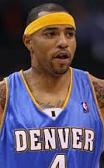
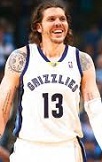

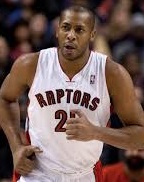
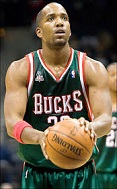
On June 28, 2000 the 2000 NBA Draft at the Target Center in Minneapolis, Minn. 29 teams select 58 players in two rounds, becoming the last draft held at the home arena of an NBA team until 2011, during which all drafts are held at The Theater at Madison Square Garden in New York City; the only draft in NBA history to worsen the talent pool (until ?); 6'9" power forward Kenyon Lee Martin (1977-) of the U. of Cincinnati (#4) is selected #1 by the New Jersey Nets (#6), moving to the Denver Nuggets (#4/#6) in 2004-11, the Xinjiang Flying Tigers in China in 2011, the Los Angeles Clippers (#2) in 2012, the New York Knicks (#3) in 2013-4, and the Milwaukee Bucks (#6) in 2015; 6'8" forward-guard Michael Lloyd "Mike" Miller (1980-) of the U. of Fla. (sophomore) is selected #5 by the Orlando Magic (#50), then traded in 2003 to the Memphis Grizzlies (#130) (until 2008), playing for for four other teams before finishing his career with the Denver Nuggets (#3) in 2015-17; 6'5" guard Aaron Jamal Crawford (1980-) of the U. of Mich. (freshman) is selected #8 by the Cleveland Cavaliers, who trade him to the Chicago Bulls (#1) for Chris Mihm, who trade him in 2004 to the New York Knicks (until 2008), after which he plays for four more teams before ending up with the Minn. Timberwolves (#11) in 2017; 6'11" center Jamaal Dane Magloire (1978-) of the U. of Ky. is selected #19 by the Charlotte Hornets, who trade him in 2005 to the Milwaukee Bucks (#20) (until 2006), after which he plays for four more teams before ending his career with the Toronto Raptors (#21) in 2011-12; 6'6" shooting guard Michael Wesley Redd (1979-) of Ohio State U. (junior) is selected #43 by the Milwaukee Bucks (#22), who sign a 6-year $91M contract in 2004-5 with him after he turns down an offer from the Cleveland Cavaliers, ending his career with the Phoenix Suns (#22) in 2011-12.
On Dec. 16, 2000 the day after Shaquille O'Neal's graduation (after he left early in 1992 after three years, then returned to fulfill a vow), LSU retires his jersey #33.
On Jan. 27, 2001 (19:37 EST) the Okla. State U. Cowboys Basketball Team Plane Crash sees their Beechcraft Super King Air 200 crash in a field in a snowstorm en route home from Jefferson County Airport near Stasburg, Colo. 40 mi. E of Denver carrying two players and six broadcasters and coaching staff, killing 10 incl. the pilot and co-pilot, causing a memorial titled "Remember the Ten" to be erected in the Gallagher-Iba Arena in Stillwater, Okla.
On Mar. 6, 2001 Shaquille O'Neal scores 61 points at the Staples Center in Los Angeles against the Clippers.
On June 6-15, 2001 the 2001 NBA Finals sees the Los Angeles Lakers (coach Phil Jackson) defeat the Philadelphia 76ers (coach Larry Brown) by 4-1; the 76ers take game 1 107-101 in OT; Shaquille O'Neal of the Lakers is MVP.
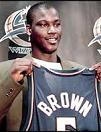
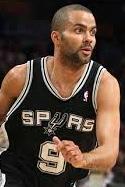
On June 27, 2001 the 2001 NBA Draft sees 30 teams draft 58 players in two rounds; 6'11" center Kwame James Brown (1982-) of Glynn Academy in Brunswick, Ga. is drafted by the Washington Wizards (#5), becoming the first high schooler to be selected #1 overall in the NBA draft; center Tyson Chandler of Dominguez H.S. in Compton, Calif. is selected #2 by the Los Angeles Clippers, who trade him to the Chicago Bulls; forward-center Pau Gasol of FC Barcelona in Spain is selected #3 by the Atlanta Hawks, who trade him to the Vancouver Grizzlies; center Ed Curry of Thornwood H.S. in South Holland, Ill. is selected #4 by the Chicago Bulls; guard Jason Richardson of Mich. State U. (sophomore) is drafted #5 by the Golden State Warriors; forward-guard Shane Battier of Duke U. is selected #6 by the Vancouver Grizzlies; guard Joe Johnson of the U. of Ark. (sophomore) is selected #10 by the Boston Celtics; forward Zach Randolph of Mich. State U. (freshman) is selected #19 by the Portland Trail Blazers; forward Gerald Wallace of the U. of Ala. (freshman) is selected #25 by the Sacramento Kings; Bruges, Belgium-born 6'2" point guard William Anthony "Tony" Parker Jr. (1982) of Paris Basket Racing in France is drafted #28 by the San Antonio Spurs (#9), initially backing up Antonio Daniels but soon becoming a starter, leading the team in assists and steals, becoming the first foreign-born guard to be named to the All-Rookie First Team for 2001-2, becoming the 2nd leading scoring in David Robinson's last season (2002-3), going on to help the Spurs wins championships in 2003, 2005, 2007, and 2014; on July 7, 2007 he marries actress Eva Longoria, divorcing in Nov. 2010; guard Gilbert Arenas of the U. of Ariz. (sophomore) is drafted #31 by the Golden State Warriors; center Mehmet Okur of Efes Pilsen in Turkey is drafted #38 by the Detroit Pistons.

On Nov. 3, 2001 after being traded from the Portland Trail Blazers, 6'8" shooting guard Steven Delano "Steve" Smith (1969-) (#8) of the San Antonio Spurs ties the NBA record for most 3-pointers in a game without a miss, going 8 for 8 and finishing with 36 points in a 106-90 win over the Portland Trail Blazers.
On Nov. 16, 2001 the 8-team NBA Development League (NBA D-League) (NBDL) plays its first game at the BI-LO Center in Greenville, S.C., with the Greenville Groove hosting the North Charleston Lowgators; in 2005 it expands to 15 teams, becoming a true minor league farm system for the NBA; in 2014 it expands to 18 teams; by then 33% of NBA players have played in it.
In 2001 Slamball, invented by Mason Gordon and played on four trampolines plays its first exhibition series in Los Angeles, Calif., featuring the Los Angeles Rumble vs. the Chicago Mob, debuting in 2002 on the Nat. Network (Spike TV) with a 6-team league incl. draft pick #1 Robert Wilson, with former NBA All-Star player Reggie Theus as commentator; the league dissolves in 2003, then reopens for one more season in 2008.
On June 2, 2002 the Sacramento Kings lose 112-106 to the Los Angeles Lakers in OT of Game 7 of the Western Conference finals, becoming the best season Sacramento fans have seen to date.
On June 5-12, 2002 the 2002 NBA Finals sees the Los Angeles Lakers (coach Phil Jackson) defeat the New Jersey Nets (coach Byron Scott) by 4-0; Shaquille O'Neal of the Lakers is MVP.

On June 26, 2002 the 2002 NBA Draft sees 30 teams draft 58 players in two rounds; 7'6" center Yao Ming (1980-), who played for the Shanghai Sharks for five seasons (MVP of the Chinese Basketball Assoc. in 2000-1) and played center for the Chinese Nat. Team at the FIBA World Championships is selected #1 by the Houston Rockets of the NBA, coming to Houston in Oct., becoming the first #1 overall pick to never college ball in the U.S.; guard Jay Williams of Duke U. (junior) is selected #2 by the Chicago Bulls, then has a bad motorcycle accident that ends his career, with the Bulls buying out his contract for $3M despite his violation by riding a motorcycle; forward Mike Dunleavy Jr. of Duke U. (junior) is selected #3 by the Golden State Warriors; forward Drew Gooden of the U. of Kansas (junior) is selected #4 by the Memphis Grizzlies; forward-center Amar'e Stoudemire forward Nene Hilario of Vasco da Gama in Brazil is drafted #7 by the New York Knicks, who trade him to the Denver Nuggets; of Cypress Creek H.S. in Orlando, Fla. is selected #9 by the Phoenix Suns; forward Caron Butler of the U. of Conn. (sophomore) is selected #10 by the Miami Heat; forward Carlos Boozer of Duke U. (junior) is selected #35 by the Cleveland Cavaliers;

On July 30, 2002 6'5" Compton, Calif.-born Lisa Deshaun Leslie (1972-) of the Los Angeles Sparks (1997-2009) becomes the first WNBA to score a slam dunk.
On Jan. 10, 2003 the NBA expands to 30 teams as the Charlotte Bobcats team is founded, changing to the Charlotte Hornets in 2013 after the New Orleans Hornets change their name to New Orleans Pelicans.
On June 4-15, 2003 after the #8 seed Philadelphia 76ers (coach Doug Collins) knock off the #1 seed Chicago Bulls, then lose to the Boston Celtics, the 2003 NBA Finals sees the San Antonio Spurs (coach Gregg Popovich) defeat the New Jersey Nets (coach Byron Scott) by 4-2; Tim Duncan of the Spurs is MVP.



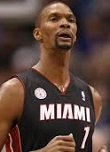
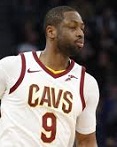



On June 26, 2003 the 2003 NBA Draft sees 30 teams select 58 players in two rounds; 6'8" small forward LeBron Raymone "King" James (1984-) of St. Vincent-St. Mary H.S. in Akron, Ohio is selected #1 by the Cleveland Cavaliers (#23), moving to the Miami Heat (#6) in 2010-14, then back to the Cavaliers (#23) in 2014-; 7'0" center Darko Milicic (1985-) of Serbia is selected #2 by the Detroit Pistons (#31), who trade him in 2006 to the Orlando Magic (#31), followed in 2007 by the Memphis Grizzlies (#31), in 2009 by the New York Knicks (#31), in 2010 by the Minn. Timberwolves (#31), and in 2012 by the Boston Celtics (#99); 6'8 small forward Carmelo Kyam "Mello" Anthony (1984-) of Syracuse U. (#15) (freshman) is selected #3 by the Denver Nuggets (#15), scoring 30 points in his 6th career game against the Los Angeles Clippers (2nd youngest after Kobe Bryant), reaching 1K career points (3rd youngest) on Feb. 9, 2004 against the Memphis Grizzlies before requesting a trade, after which on Feb. 22, 2011 he and Chauncey Billups are traded to the New York Knicks (#7) in 2011, reaching 20K career points (6th youngest) in game 3 of the 2014-15 season against the Charlotte Hornets; '11" power forward-center Christopher Wesson "Chris" Bosh (1984-) of Georgia Tech (freshman) is selected #4 by the Toronto Raptors (#4), who in 2010 trade him to the Miami Heat (#1); guard Dwayne Tyrone Wade Jr. (1982-) of Marquette U. (junior) is selected #5 by the Miami Heat (#3), who in 2016 trade him to the Chicago Bulls #3), who in 2017 trade him to the Cleveland Cavaliers (#9), who in 2018 trade him to the Miami Heat (#3); four of the top five picks become Redeem Team Olympic Gold Medalists; 7'0" center Christopher Zane "Chris" Kaman (1982-) of Central Mich. U. (junior) is selected #6 by the Los Angeles Clippers (#35), leading them to their first playoff V in 2006 and finishing the 2010/11 season with a 29-53 record before being traded in 2011 to the New Orleans Hornets, in 2012 to the Dallas Mavericks (#35), in 2013 to the Los Angeles Lakers, and in 2014 to the Portland Trail Blazers (#35); 6'4" shooting/point guard Kirk James Hinrich (1981-) of the U. of Kansas is selected #7 by the Chicago Bulls (#12), who trade him in 2010 to the Washington Wizards, followed in 2011 by the Atlanta Hawks (#12), in 2012 by the Chicago Bulls, and in 2016 back to the Atlanta Hawks (#12); 6'9" power forward David Moorer West (1980-) of Xavier U. is selected #18 by the New Orleans Hornets (#30), who trade him in 2011 to the Indiana Pacers (#21), followed in 2015 by the San Antonio Spurs (#30), and in 2016 to the Golden State Warriors #3), helping them win the 2017 NBA Championship with his passing abilities.
On July 1, 2003 Los Angeles Lakers basketball star Kobe Bean Bryant (1978-) allegedly rapes a woman in his room at the Lodge and Spa at Cordillera Hotel in Edwards, Colo. the night before surgery by Dr. Richard Steadman, causing the sheriff of Eagle, Colo. arrests him in July, causing mucho publicity; the case is dropped after he admits to an affair and she refuses to testify, then files a civil suit that is settled out of court after he apologizes but admits no guilt.
In 2003 Michael Jordan (b. 1963) leaves the game of basketball for good, with a total of 32,292 career points, six NBA championships with the Chicago Bulls, College Player of the Year for two years, and five NBA MVP awards; he is quickly chosen as one of the 50 greatest players in NBA history.
On June 6-15, 2004 the 2004 NBA Finals sees the Detroit Pistons (coach Larry Brown) defeat the Los Angeles Lakers (coach Phil Jackson) by 4-1; Chauncey Billups of the Pistons is MVP.

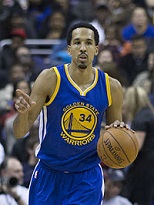


On June 24, 2004 the 2004 NBA Draft sees 30 teams draft 59 players in two rounds; 6'11" center Dwight David Howard (1985-) of Southwest Atlanta Christian Academy in Ga. is selected #1 by the Orlando Magic, who trade him in 2012 to the Los Angeles Lakers, who trade him in 2013 to the Houston Rockets, who trade him in 2016 to the Atlanta Hawks, who trade him in 2017 to the Charlotte Hornets (#12), becoming an NBA All-star 8x, NBA defensive player of the year 3x, and NBA rebounding leader 5x in 2008-13; 6'10" forward-center Chukwuemeka (Igbo "God has done well") Ndubuisi "Emeka" Okafor (1982-) of the U. of Conn. (junior) is selected #2 by the Charlotte Bobcats (#50) (their first-ever draft pick), winning rookie of the year, making an NBA 10 blocks in a game against the New York Knicks on Jan. 12, 2007 (most at Madison Square Garden); on July 28, 2009 he is traded for Tyson Chandler to the New Orleans Hornets (#50), leading them to their first-ever playoff series, which they lose 4-2 to the Los Angeles Lakers before being traded on June 20, 2012 along with Trevor Ariza to the Washington Wizards (#50) in 2012 in exchange for Rashard Lewis; on Oct. 25, 3013 he is traded to the Phoenix Suns in exchange for Marcin Gortat, Shannon Brown, Kendall Marshall, and Malcoln Lee, but misses the season due to a herniated disc in his neck, and goes unsigned in the 2014-15 season; 6'3" shooting guard Benjamin Ashenafi "Ben" Gordon (1983-) of the U. of Conn. (junior) is selected #3 by the Chicago Bulls, becoming the first rookie to win the NBA Sixth Man Award before being traded in 2009 to the Detroit Pistons, in 2012 to the Charlotte Bobcats, in 2014 to the Orlando Magic, and in 2017 to the Texas Legends of the NBA Development League; 6'7" guard Shaun Patrick Livingston (1985-) of Peoria H.S. in Ill. is selected #4 by the Los Angeles Clippers, badly injuring his left knee on Feb. 26, 2007 in a game against the Charlotte Bobcats, causing him to miss 101 of his first 246 regular season games before being traded in 2014 to the Golden State Warriors and winning the 2015 NBA Finals; 6'3" point/shooting guard Devin Lamar Harris (1983-) of the U. of Wisc. (junior) is selected #5 by the Washington Wizards, who trade him to the Dallas Mavericks, who in 2008 trade him to the New Jersey Nets, who in 2011 trade him to the Utah Jazz, who in 2012 trade him to the Atlanta Hawks, who in 2013 trade him to the Dallas Mavericks, who in 2018 trade him to the Denver Nuggets (#34), where on Mar. 6, 2018 he reaches 10K career points; 6'9" South Sudan-born small forward Luol Ajou Deng (1985-) of Duke U. (freshman) is selected #7 by the Phoenix Suns, who trade him to the Chicago Bulls (#9), who in 2014 trade him to the Cleveland Cavaliers, who in 2014 trade him to the Miami Heat, who in 2016 trade him to the Los Angeles Lakers; 6'6" guard-forward Andre Tyler Iguodala (1984-) of the U. of Ariz. (sophomore) is selected #9 by the Philadelphia 76ers (#9), moving to the Denver Nuggets in 2012-13, and the Golden State Warriors (#9) in 2013-; 6'0" point guard Jameer Nelson (1982-) of St. Joseph's U. (#14) is selected #20 by the Orlando Magic (#14), getting traded in 2014 to the Dallas Mavericks (#14), in 2014 to the Boston Celtics, in 2015 to the Denver Nuggets, in 2017 to the New Orleans Pelicans, and in 2018 to the Detroit Pistons;
In Aug. 2004 the Internat. Basketball League (IBL) is founded with eight teams by Portland, Ore. sports promoter to play a faster, more exciting, higher-scoring (by 30 points) form of the game, incl. a 22-sec. shot clock and the immediate inbound rule; by Apr. 2005 it has 17 teams; the first championship is won by the Battle Creek Knights after they defeat the Dayton Jets; in July 2011 it is sold to Bryan Hunter of Vancouver, Wash.; in Mar. 2014 it merges with the West Coast Basketball League (WCBL).
In the 2004-5 season the avg. NBA salary tops $4M ($4.4M), making basketball players the world's highest-paid athletes.
On June 9-23, 2005 the 2005 NBA Finals sees the San Antonio Spurs (coach Gregg Popovich) defeat the Detroit Pistons (coach Larry Brown) by 4-3; Tim Duncan of the Spurs is MVP.


On June 15, 2005 former Baylor U. basketball player Carlton Eric Dotson Jr. (1982-) is sentenced to 35 years in prison in Waco, Tex. for the murder of his teammate and best friend Patrick James Dennehy (1982-2003), whose body was found in 2003 in a field after Dotson called police to say he was hearing voices saying he is Jesus Christ, and told them where to find the body, launching the Baylor U. Basketball Scandal, causing head basketball coach (since 1999) David Gregory "Dave" Bliss (1943-) to resign after he is exposed for paying Dennehy's tuition, not reporting failed drug tests, and asking players to lie about it; the team doesn't have another winning season until 2008.
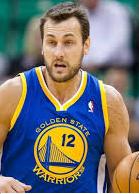

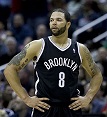
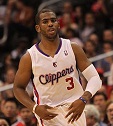


On June 28, 2005 the 2005 NBA Draft sees 30 teams draft 60 players in two rounds; Australian-born Croatian-descent 7'0" center Andrew Michael Bogut (1984-) of the U. of Utah (sophomore) is selected #1 by the Milwaukee Bucks (#6) (first Aussie and 2nd Utah player to be drafted #1), coming in 3rd for rookie of the year, drawing a $25K fine in a 2007-8 season game against the Toronto Raptors for making an obscene gesture after being ejected; on Apr. 3, 2010 he suffers a major injury to his hand, wrist, and right elbow, then returns to Australia during the 2011 NBA Lockout, returning to the Bucks then fracturing his ankle on Jan. 25, 2012, sitting out the rest of the season; on Mar. 13, 2012 he and Stephen Jackson are traded to the Golden State Warriors (#12) in exchange for Monta Ellis, Ekpe Udoh, and Kwame Brown, becoming the first Warrior since Larry Smith on May 12, 1987 to grab 20 rebounds in a May 2, 2013 playoff game; 6'9" power/small forward Marvin Gaye Williams Jr. (1986-) of the U. of N.C. (freshman) is selected #2 by the Atlanta Hawks (#24), who in 2012 trade him to the Utah Jazz, who in 2014 trade him to the Charlotte Hornets (#2); 6'3" point guard Deron Michael "D-Will" Williams (1984-) of the U. of Ill. (junior) is selected #3 by the Utah Jazz, who in 2011 trade him to the New Jersey/Brooklyn Nets (#8), who in 2015 trade him to the Dallas Mavericks, who in 2017 trade him to the Cleveland Cavaliers; 6'0" point guard Christopher Emmanuel "Chris" Paul (1985-) of Wake Forest U. (sophomore) is selected #4 by the New Orleans Hornets, who in 2011 trade him to the Los Angeles Clippers, who in 2017 trade him to the Houston Rockets (#3), winning the NBA Rookie of the Year Award, the NBA All-Star Game MVP Award, and leads the NBA in assists 4x and steals 6x (all-time leader); 7'0" center Andrew Bynum (1987-) of St. Joseph H.S. in Metuchen, N.J. is selected #10 by the Los Angeles Lakers (#17), winning the NBA title in 2009 and 2010 before being traded in 2013 to the Cleveland Cavaliers, and in 2014 to the Indiana Pacers, where his career ends with a sore right knee; 6'11" Lodz, Poland-born center Marcin "the Polish Hammer" Gortat (1984-) is selected #57 by the Phoenix Suns, electing to say with Rhein-Energie Cologne in Germany until Nov. 20, 2007, when he signs with the NBA-D Anaheim Arsenal, moving to the Orlando Magic (#4) on Dec. 2, 2007, backing up Dwight Howard before being traded on Dec. 18, 2010 along with Vince Carter and Mickael Pietrus to the Phoenix Suns (#4) in exchange for Jason Richardson, Earl Clark, and Hedo Turkoglu, becoming starting center in his first season in place of Robin Lopez, becoming the only Suns player to start and play every game in the 2011-12 season, averaging a double-double; on Nov. 7, 2012 he scores 23 points, 10 rebounds, and a career-best 7 blocks in a 117-110 V against the Charlotte Bobcats, injuring his knee in Feb. and sitting out the rest of the season before being traded on Oct. 25, 2013 along with Shannon Brown, Malcolm Lee, and Kendall Marshall to the Washington Wizards (#4) in exchange for Emeka Okafor; on Feb. 27, 2014 he scores a career high 31 points, along with 12 rebounds and 4 blocks in a 134-129 triple OT win over the Toronto Raptors; on May 13, 2014 he scores 31 points and 16 rebounds to help win Game 5 of the playoffs against the Indiana Pacers, becoming the first Wizards with 30+points and 15+ rebounds in a playoff game since Moses Malone in 1987.

White men can't jump, but they can't open their mouths in public either in the new PC U.S.? On Oct. 25, 2005 after a 48-10 loss to Texas Christian U. (TCU), Cheraw, S.C.-born Air Force Academy coach (1980-2006) Fisher DeBerry (1938-) makes un-PC statements and touches the new third rail of U.S. politics at a media luncheon, commenting that TCU "had a lot more Afro-American players than we did and they ran a lot faster than we did. That doesn't mean that Caucasian kids and other descents can't run, but it's very obvious to me that they run extremely well"; also "The black athlete, statistically, from program to program, seems to have an edge as far as speed is concerned"; the PC police then come down on him hard, resulting in a reprimand, even though the statements are true and white men can't run with the black men?; black running backs have led the NFL in rushing for the past 43 consecutive seasons; between 1977-2005 96 receivers were drafted in the first round of the NFL, all of them black; the world records at every race distance under 800m are held by men of West African descent, as it has been since the middle of the 20th cent.; as of 2001, 494 of the fastest 500 times in the 100m run have been by men of West African descent; of the approx. 200 times the 10-sec. barrier has been broken, all have been by runners of West African descent; when it comes to distance running, Kenyans and Ethiopians dominate, with most of the top runners coming from one small Kenyan ethnic group - East is East and West is West, and never the what?

In Oct. 2005 WNBA basketball star Sheryl Swoopes comes out as a lesbian after divorcing her hubby with whom she had a child, announcing a relationship with Comets asst. coach Alisa Scott; in 2011 she gets engaged to a man, Chris Unclesho, and marries him.

On Nov. 2, 2005 7'0" center Andrew Bynum (1987-) (#17) of the Los Angeles Lakers (b. Oct. 27, 1987) becomes the youngest player to play in a regular season NBA game at 18 years 6 days, breaking Jermaine O'Neal's 1995 record by 46 days.
On Nov. 5, 2005 the 22-team BJ (Basketball Japan) League is founded in Japan, divided into Eastern and Western Conferences; it holds its first All-Star Game in 2006; in 2012 the Nat. Basketball League (NBL) is founded by the Japanese Basketball Assoc. to exist alongside the BJ League; in 2013-4 former Chicago Bulls coach Bill Cartwright becomes head coach of BJ team Osaka Evessa.
On June 8-20, 2006 the 2006 NBA Finals sees the Miami Heat (coach Pat Riley) defeat the Dallas Mavericks (coach Avery Johnson) by 4-2: Dwayne Wade of the Heat is MVP.
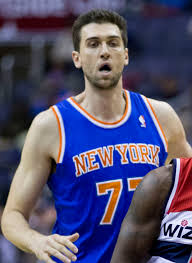
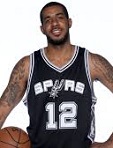
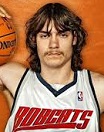
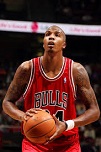
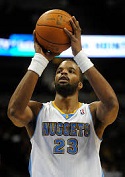
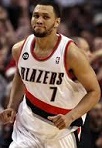

On June 28, 2006 the 2006 NBA Draft sees 30 teams select 60 players in two rounds; 7'0" power forward-center Andrea Bargnani (1985-) of Benetton Treviso in Italy (first Euro player and 2nd player without U.S. college or h.s. experienced to drafted #1 after Yao Ming) is selected #1 by the Toronto Raptors (#7), having a hard time getting used to the NBA before achieving his promise in the 2008-9 season, becoming the 4th Raptor to score 6K points in a game against the Denver Nuggets on Mar. 28, 2012, missing most of the 2012-13 season before being traded for Steve Novak, Marcus Camby, and Quentin Richardson to the New York Knicks (#77) on July 10, 2013, suffering a torn ligament in his left elbow on Jan. 22, 2014 that ends his season, then missing the 2014-15 preseason with a hamstring injury, finally playing on Dec. 31, 2014 after almost a year missed, only to reinjure his right calf in a game against the Detroit Pistons on Jan. 2, 2015, missing 16 more games before returning on Feb. 9; 6'11" power forward-center LaMarcus Nurae Aldridge (1985-) of the U. of Tex. (sophomore), known for his signature fadeaway shot is selected #2 by the Chicago Bulls, who trade him to the Portland Trail Blazers (#12), who in 2015 trade him to the San Antonio Spurs (#12); 6'8" forward Adam John "the White Mamba" Morrison (1984-) of Gonzaga U. (#3) (junior) is selected #3 by the Charlotte Bobcats, tearing his ACL on Oct. 21, 2007 and missing the 2007-8 season; in 2009 he is traded to the Los Angeles Lakers (#6), who release him after the 2009-10 season; in 2011 he signs with Red Star Belgrade; 6'10" power forward-center Tyrus Wayne Thomas (1986-) of LSU (freshman) is selected #4 by the Portland Trail Blazers, who trade him to the Chicago Bulls (#24), who in 2010 trade him to the Charlotte Bobcats (#12), who wave him via the amnesty clause on July 20, 2013; in 2015 he signs with the Iowa Energy of the NBA Development Lague, works 20-days for the Memphis Grizzles, then ends up in Eisbaren Bremerhaven; 6'9" power forward-center Shelden DeMar "the Landlord" Williams (1983-) of Duke U. (#23)is selected #5 by the Atlanta Hawks, going on to be traded to the Sacramento Kings (#22) in 2008, Minn. Timberwolves in 2009, Boston Celtics (#13) in 2009, Denver Nuggets (#23) in 2010, New York Knicks in 2011, and New Jersey Nets (#33) in 2011 before signing with Elan Chalon in 2012; 6'6" shooting guard Brandon Dawayne "B-Roy" "The Natural" Roy (1984-) of the U. of Washington is selected #6 by the Minnesota Timberwolves, who trade him to the Portland Trail Blazers (#7), who in 2012 trade him to the Minn. Timberwolves (#3), playing five games before retiring due to a degenerative knee condition; 6'4" shooting/point guard Randy Foye (1983-) of Villanova U. is selected #7 by the Minn. Timberwolves, going to be traded in 2009 to the Washington Wizards (#15), in 2010 to the Los Angeles Clippers (#4), in 2012 to the Utah Jazz, making a record 178 3-pointers out of 434 shots (41%), in 2013 to the Denver Nuggets, in 2016 to the Okla. City Thunder, and in 2016 to the Brooklyn Nets.
In 2006 Spalding Co. and the NBA announce a new NBA Official Game Ball made of synthetic material; too bad, players complain that it gets too slick and won't bounce right, causing the NBA to revert to the old leather balls effective Jan. 1, 2007.
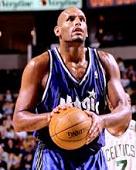

On Feb. 7, 2007 Boston, Mass.-born English-raised African-Am. retired former NBA player John Uzoma Ekwugha Amaechi (1970-) announces that he's gay, causing fellow Chicago-born African-Am. player Timothy Duane "Tim" Hardaway (1966-) to comment during a Feb. 14 interview with a sports radio show in Miami, Fla. that he would try to keep an arm's, er, distance himself from a gay player, with the soundbyte: "Well, you know I hate gay people, so I let it be known I don't like gay people and I don't like to be around gay people. I am homophobic. I don't like it. It shouldn't be in the world or in the United States", adding that he if he found he had a gay teammate he would try to get them fired, bringing out the PC police, which by this time incl. criticism from straights, with Shaquille O'Neal saying that anybody who wants to 'get' a gay player will have to go through him first, causing him to flop and apologize the same day, and make amends forever after?
In Feb. 2007 the U. of Ill. retires buckskin-clad basketball mascot Chief Illiniwek after 81 years after pressure from the NCAA, which barred colleges with Am. Indian mascots from hosting postseason events in 2005.

On Apr. 4, 2007 irreverent radio host John Donald "Don" Imus (1940-) describes the Rutgers women's basketball team as "nappy-headed hos", causing a firestorm by PC police; despite being put through an inquisition on Apr. 9 by Rev. Al Sharpton and apologizing to the team (apology accepted), CBS Radio fires him on Apr. 13 (Fri.), causing him to sue them for $40M, citing his contract that acknowledges that his services are expected to be "controversial"; meanwhile other groups cite black rappers for using the words Imus used in multi-million selling albums, raising the specter of double standards again; on Dec. 3 he returns to the airwaves on WABC-AM in New York City, properly contrite about daring to be non-PC?
On June 7-14, 2007 the 2007 NBA Finals sees the San Antonio Spurs (coach Gregg Popovich) defeat the Cleveland Cavaliers (coach Mike Brown) by 4-0; MVP is Tony Parker of the Spurs.
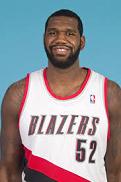
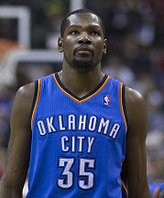
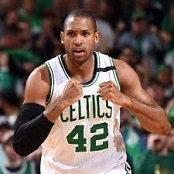
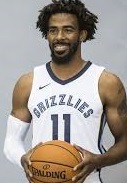
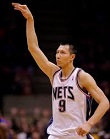


On June 28, 2007 the 2007 NBA Draft sees 30 teams select 60 players in two rounds broadcast on TV in 115 countries; 7'0" center Greg Wayne "Greg" Oden Jr. (1988-) of Ohio State U. (freshman) is selected #1 by the Portland Trail Blazers (#52), missing the 2007-8 season with knee problems, getting waived on Mar. 15, 2012 after more injuries, sitting out the 2012-13 season before signing with the Miami Heat (#20) on Aug. 7, 2013 after 3+ years without playing in an NBA game (Dec. 5, 2009); 6'9" small forward Kevin Wayne Durant (1988-) of UTA (freshman) is selected #2 by the Seattle SuperSonics (#35), moving to the Golden State Warriors (#35) in 2016 (until ?). Dominican Repub.-born 6'10" center Alfred Joel Horford Reynoso (1986-) of the U. of Fla. (junior) is selected #3 by the Atlanta Hawks (#15), who in 2016 trade him to the Boston Celtics (#42); 6'1" point guard Mike Alex Conley Jr. (1987-) of Ohio State U. (freshman) is selected #4 by the Memphis Grizzlies (#11); 6'9" power/small forward Jeffrey Lynn "Jeff" Green (1986-) of Georgetown U. (junior) is selected #5 by the Boston Celtics, who trade him to the Seattle SuperSonics, who in 2011 trade him to the Boston Celtics, who in 2015 trade him to the Memphis Grizzlies, who in 2016 trade him to the Los Angeles Clippers, who in 2016 trade him to the Orlando Magic, who in 2017 trade him to the Cleveland Cavaliers (#32); 7'0" power forward-center Yi Jianlian (1987-) of the Guandong Southern Tigers in China is selected #6 by the Milwaukee Bucks (#9), getting traded to the New Jersey Nets (#9) in 2008, the Washington Wizards (#31) in 2010, and the Dallas Mavericks (#9) in 2012; 6'9" forward/guard Corey Wayne Brewer (1986-) is selected #7 by the Minn. Timberwolves (#13), getting traded to the Dallas Mavericks in 2011, the Denver Nuggets in 2011, back to the Timberwolves in 2013, the Houston Rockets in 2014, the Los Angeles Lakers (#3) in 2017, and the Okla. City Thunder in 2018; 6'11 center Joakim Noah (1985-) of the U. of Fla. is drafted #9 by the Chicago Bulls (#13), who in 2016 trade him to the New York Knicks (#13).


On Oct. 3, 2007 former Northwestern U. basketball star Anucha Browne Sanders, who was fired as marketing exec. by the New York Knicks in Dec. 2003 wins a $11.6M sexual harassment lawsuit against them and "foul-mouthed bully" coach Isiah Lord "Zeke" Thomas III (1961-); Madison Square Garden is assessed $11.5M in punitive damages - a game that women play with men?
In 2007 the U. of Fla. becomes the first U.S. univ. to hold nat. titles in football and basketball in the same year.

On June 5-17, 2008 the 2008 NBA Finals sees the Boston Celtics (coach Doc Rivers) defeat the Los Angeles Lakers (coach Phil Jackson) by 4-2, becoming their first win since 1986 (17th overall); small forward Paul Pierce (1977-) (#34) of the Celtics is MVP.
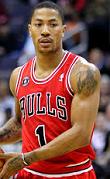
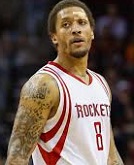
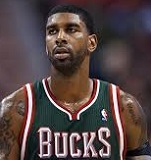
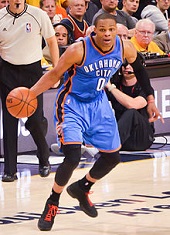

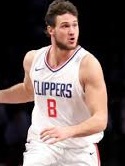

On June 26, 2008 the 2008 NBA Draft sees 30 teams select 60 players in two rounds, becoming the last draft appearance of the Seattle Supersonics, who in early July relocate to Oklahoma City, Okla., becoming the Oklahoma City Thunder; the first time that an NBA D-League player is drafted; 6'3" point guard Derrick Martell Rose (1988-) of Memphis U. (freshman), 2007 Ill. Mr. Basketball is selected #1 by the Chicago Bulls (#1), winning rookie of the year; 6'10" forward Michael Paul Beasley Jr. (1989-) of Kansas State U. (freshman) is selected #2 by the Miami Heat, who trade him in 2010 to the Minn. Timberwolves, returning in 2013-14 and 2015, after which in 2016 he ends up with the Houston Rockets (#8) (until ?); 6'5" guard Ovinton J'Anthony "O.J." Mayo (1987-) of USC (freshman) (first time freshmen are selected 1-2-3) is selected #3 overall by the Minnesota Timberwolves, who trade him to the Memphis Grizzlies, ending up with the Milwaukee Bucks (#3) in 2013-; 6'3" point guard Russell Westbrook Jr. (1988-) of UCLA (sophomore) is selected #4 by the Seattle SuperSonics (Okla. City Thunder) (#0); 6'10" forward-center Kevin Wesley Love (1988-) of UCLA (freshman) is selected #5 by the Memphis Grizzles, who trade him to the Minnesota Timberwolves, who trade him in 2014 to the Cleveland Cavaliers (#0); 6'10" small/power forward Danilo Gallinari (1988-) of Olimpia Milano in Italy is selected #6 by the New York Knicks (#8), who in 2011 trade him to the Denver Nuggets (#8), who in 2017 trade him to the Los Angeles Clippers (#8), getting his own sneaker called the Rooster manufactured by Reebok; 6'4" shooting guard Eric Ambrose Gordon Jr. (1988-) of the U. of Ind. (freshman) is selected #7 by the Los Angeles Clippers, who in 2011 trade him to the New Orleans Hornets/Pelicans, who in 2016 trade him to the Houston Rockets (#10).
On July 20, 2008 U.S. pres. Barack Obama shows everybody that he's not a girlie man by sinking a 3-pointer on the basketball court with troops in Kuwait.


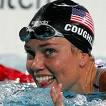
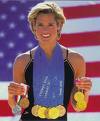





China says Hi, world, we're here, whatcha going to do about it? On Aug. 8, 2008 (8/8/8) at 8 p.m. (the number 8 being lucky to the Chinese) the XXIX (29th) Summer Olympic Games (slogan: "One World One Dream") open in Beijing, China after 400K Beijing residents are forcibly evicted from their homes (end Aug. 24); 11,028 athletes from 204 nations compete in 302 events in 28 sports in the new Feng Shui-approved Bird's Nest stadium and Water Cube swimming pavilion; the mascots are the Eight, er, Five Friendlies, representing China's four most popular animals (fish, panda, Tibetan antelope, swallow); the number 8 (ba) is lucky because it rhymes with fa (wealth); the number 4 (si) is unlucky since it means death in Chinese; the Chinese crowds like to yell "Jiayou!" (pr. jya-yo), meaning "add oil!", "lubricate!"; BMX (Bicycle Motocross) racing makes its debut; the U.S. wins 110 medals (36 golds), China 100 (51 golds), Russia 72 (23 golds), Britain 47 (19 golds); on Aug. 10 32-y.-o. Jason Edward Lezak (1975-) swims a record 46.06 sec. last leg of the 400m freestyle relay, running down French world record holder Alain Bernard (1983-) and breaking his world record of 47.50 by 1.5 sec. and giving the U.S. a gold with a final time of 3:08:24, shattering the world record of 3:12:23, and saving Michael Phelps' gold medal run, causing him to let out a loud victory yell which becomes the games' #1 soundbyte, being touted as the greatest relay of all time; meanwhile on Aug. 10 the Chinese basketball team led by Yao Ming loses by 101-70 to Team USA in the most watched basketball game in history, the crowd cheering wildly as he opens up the game with a 3-point shot; on Aug. 13 6'4" Jim, er, Michael Fred Phelps II (1985-), "the Baltimore Bullet" of the U.S. wins his 5th gold in swimming, giving him a record 11, followed by #6 on Aug. 15, #7 on Aug. 16, tying Mark Spitz's 1972 Munich record, and #8 on Aug. 17, setting the all-time Olympic record for most golds; on Aug. 16 Phelps defeats Am.-born swimmer Milorad Cavic (1984-) of Serbia by only 0.01 sec. in the final, giving Serbia its first Olympic swimming medal, with Cavic claiming he touched first but not with enough force to register; the Space Age Speedo LZR Racer (pr. like laser) swimsuit is used by 94% of the swimmers, bringing all their achievements, esp. Phelps' in question; on Aug. 15 Nastia Liukin (1989-) of the U.S. wins the all-round women's gold medal in gymnastics, with Shawn Johnson (1992-) of the U.S. winning the silver medal; on Aug. 17 Natalie Anne Coughlin (1982-) becomes the first U.S. female athlete to win six medals in one Olympics, and the first to win gold in 100m backstroke in two consecutive Olympics; 41-y.-o. Dara Grace Torres (1967-) becomes the first U.S swimmer to compete in five Olympics (1984-2008), and wins three silver medals; on Aug. 19 flyweight Henry Cejudo (1978-) of the U.S. (son of pesky fly-like illegal immigrants from Mexico) becomes the youngest Olympic freestyle gold winner; on Aug. 16 6'5" Usain "Lightning" Bolt (1986-) of Jamaica wins the 100M with a world record time of 9.69 sec., then on Aug. 20 wins the 200M with a world record time of 19.30 sec., shattering the supposedly unbreakable 19.32 sec. 1996 record of Michael Johnson, and becoming the first man to win both races since Carl Lewis in 1984, and the first to set world records in both in the same Olympics; on Aug. 24 (Sun.) the U.S. men's volleyball team wins gold after defeating defending champion Brazil, ending the Olympics on an upbeat, since the father-in-law of Kiwi-born coach Hugh McCutcheon (1969-) was fatally stabbed the day before competition started, and his mother injured, causing him to miss the team's first three games; the U.S. men's basketball Redeem Team (a play on the 1992 Dream Team) features Kobe Bryant, Carmelo Anthony, and LeBron James, plus coach Mike Krzyzewski, and wins gold after defeating Spain 118-109.
On Nov. 7, 2008 Utah Jazz head coach Jerry Sloan becomes the first in NBA history to win 1K games with the same team with a 104-97 win over the Oklahoma City Thunder.
In 2008 the Seattle SuperSonics relocate to Okla. City, Okla., becoming the Oklahoma City Thunder, changing the team colors to blue-yellow-sunset.
On June 4-14, 2009 the 2009 NBA Finals sees the Los Angeles Lakers (coach Phil Jackson) defeat the Orlando Magic (coach Stan Van Gundy) by 4-1: MVP is Kobe Bryant of the Lakers.




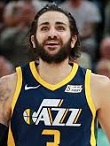
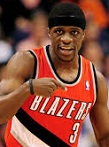

On June 25, 2009 2009 NBA Draft sees 30 teams draft 60 players in two rounds, incl. four freshmen, nine sophomores, 12 juniors, 22 seniors, and 13 internat. players; 6'10" power forward Blake Austin Griffin (1989-) of the U. of Okla. (sophomore) is drafted #1 by the Los Angeles Clippers (#32), breaking his left kneecap in the final 2009 pre-season game then sitting out the 2009-10 season, winning rookie of the year in 2010-11 along with the NBA Slam Dunk Contest, with Sports IIllustrated calling him one of the 15 greatest NBA rookies of all time, becoming a perennial All-Star; 7'3" Tanzanian-born center Hasheem Thabeet (Hashim Thabit Manka) (1987-) of the U. of Conn. (junior) is selected #2 by the Memphis Grizzlies, who trade him in 2011 to the Houston Rockets, who trade him in 2012 to the Portland Trail Blazers, who trade him in 2012 to the Oklahoma City Thunder (#34); 6'5" shooting/point guard James Edward Harden Jr. (1989-) of Ariz. State U. (sophomore) is selected #3 by the Oklahoma City Thunder, who trade him in 2012 to the Houston Rockets (#13), going on to become NBA MVP in 2015; 6'6" guard Tyreke Jamir Evans (1989-) of the U. of Memphis (freshman) is selected #4 by the Sacramento Kings, who trade him in 2013 to the New Orleans, then back to the Kings in 2017 before being traded in 2017 to the Memphis Grizzles (#12); 6'4" point guard Ricky Rubio i Vives (1990-) of DKV Joventut in Spain is selected #5 by the Minnesota Timberwolves, who trade him in 2017 to the Utah Jazz (#3); 6'0" guard Jonny William Flynn (1989-) of Syracuse U. (sophomore) is selected #6 by the Minnesota Timberwolves, who trade him in 2011 to the Houston Rockets, who trade him in 2012 to the Portland Trail Blazers; 6'3" guard Wardell Stephen "Steph" Curry II (1988-) of Davidson College (junior) is selected #7 by the Golden State Warriors (#30), going on to become one of the Two Splash Brothers with Klay Thompson (1990-) and lead them to the 2015 NBA Championship and win the MVP award (greatest shooter in NBA history?).
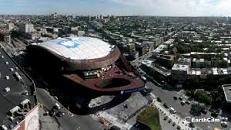
On Mar. 11, 2010 Barclays Center in Brooklyn, N.Y. is opened as the home of the NBA New Jersey Nets.

On Apr. 11, 2010 the TV reality series Basketball Wives debuts on VH1-TV for 61 episodes (until Oct. 21, 2013), filmed in Miami, Fla. and New York City, spawning Basketball Wives LA for 41 episodes on Aug. 29, 2011-Aug. 2012.
On June 3-17, 2010 the 2010 NBA Finals sees the Los Angeles Lakers (coach Phil Jackson) defeat the Boston Celtics (coach Doc Rivers) by 4-3; Kobe Bryant of the Lakers is MVP.
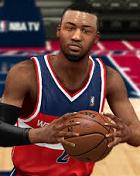
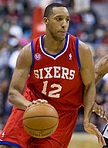


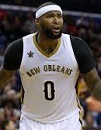
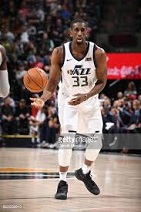
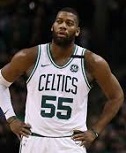
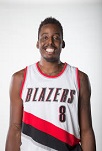
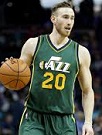
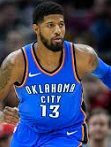
On June 24, 2010 the 2010 NBA Draft sees 30 teams draft 60 players in two rounds, broadcast on ESPN-TV; last draft conducted at Madison Square Garden until 2014 while it undergoes renovation; a record five players are drafted from the same school (U. of Ky.) in round 1; 6'4" point guard Johnathan Hildred "John" Wall Jr. (1990-) of the U. of Ky. (freshman), known for his blazing speed to the rim is selected #1 by the Washington Wizards (#2); 6'7" shooting guard Evan Marcel Turner (1988-) of Ohio State U. (junior) is selected #2 by the Philadelphia 76ers (#12), who trade him in Feb. 2014 to the Indiana Pacers, then to the Boston Celtics in July 2014, and the Portland Trail Blazers (#1) in 2016; 6'10" power forward/center Derrick Bernard Favors (1991-) of Georgia Tech (freshman) is selected #3 by the New Jersey Nets, who trade him in 2011 to the Utah Jazz (#15); forward Wesley JaMarr Johnson (1987-) of Syracuse U. (junior) is selected #4 by the Minn. Timberwolves, who trade him in 2013 to the Los Angeles Lakers, who trade him in 2015 to the Los Angeles Clippers (#33); 6'11" center DeMarcus Amir Cousins (1990-) of the U. of Ky. (freshman) is selected #5 by the Sacramento Kings, who trade him in 2017 to the New Orleans Pelicans (#0); 6'10" shot-blocking center-forward Ekpedeme Friday "Ekpe" Udoh (1987-) of Baylor U. (junior) is selected #6 by the Golden State Warriors, who trade him in 2012 to the Milwaukee Bucks, who trade him in 2014 to the Los Angeles Clippers, after which he spends a year with the Turkish Fenderbache club, then signs with the Utah Jazz (#33) in 2017 (until ?); 6'11" center-forward Greg Keith Monroe Jr. (1990-) of Georgetown U. (sophomore) is selected #7 by the Detroit Pistons (#10), who trade him in 2015 to the Milwaukee Bucks, who trade him in 2017 to the Phoenix Suns, who trade him in 2018 to the Boston Celtics (#55); 6'9" forward Al-Farouq Ajiede Aminu (1990-) of Wake Forest U. (sophomore) is selected #8 by the Los Angeles Clippers, who trade him in 2011 to the New Orleans Hornets/Pelicans, who trade him in 2014 to the Dallas Mavericks, who trade him in 2015 to the Portland Trail Blazers (#8); 6'8" forward Gordon Daniel Hayward (1990-) of Butler U. (sophomore) is selected #9 by the Utah Jazz, who trade him in 2017 to the Boston Celtics (#20); 6'9" small forward Paul Clifton Anthony George (1990-) of Fresno State U. (sophomore) is selected #10 by the Indiana Pacers, who trade him in 2017 to the Okla. City Thunder (#13).

On July 8, 2010 after seven seasons, two NBA MVPs, and six All-Star picks, superstar 6'8" forward (#23) LeBron Raymone "King" James (1984-) leaves the Cleveland Cavaliers for the Miami Heat (#6) (until 2014), as announced in the ESPN special The Decision.
On Nov. 26, 2010 Pres. Obama gets inadvertently elbowed in the upper lip by Rey Decerega during a friendly basketball game at Ft. McNair in Washington, D.C., requiring 12 stiches.
On Mar. 15, 2011 NCAA March Madness, jointly produced by CBS Sports debuts on TBS-TV (until ?) to cover the annual NCAA Men's Div. 1 Basketball Tournament.

On May 31-June 12, 2011 the 2011 NBA Finals see the Dallas Mavericks defeat the Miami Heat by 4-2; MVP is German-born power forward Dirk Werner Nowitzki (1978-) (#41) of the Mavericks.
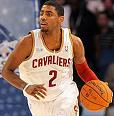
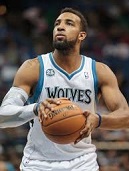
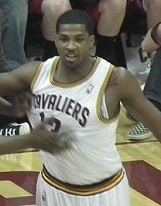



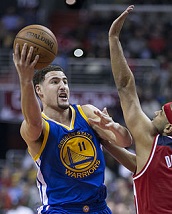

On June 23, 2011 the 2011 NBA Draft sees 30 teams draft 60 players in two rounds at Prudential Center in Newark, N.J., incl. seven freshmen, seven sophomores, 14 juniors, 19 seniors, and 12 internat. players, after which the New Jersey Nets relocate to Brooklyn, N.Y., becoming the Brooklyn Nets; 6'3" Australian-born point guard Kyrie Andrew Irving (1992-) of Duke U. (freshman) is selected #1 by the Cleveland Cavaliers (#2), winning the rookie of the year award, followed by the 2003 NBA 3-point shootout competition; 6'8" forward Derrick LeRon Williams (1991-) of the U. of Ariz. (sophomore) is selected #2 by the Minnesota Timberwolves (#23), moving to the Sacramento Kings in 2013, and the New York Knicks (#23) in 2015-; 6'9" center-forward Tristan Trevor James Thompson (1991-) of UTA (sophomore) is selected #4 by the Cleveland Cavaliers (#13); 7'0" center Jonas Valanciunas (1992-) of Lietuvos Rytas in Lithuania is selected #5 by the Toronto Raptors (#17); 7'0" center Jan Vesely (1990-) of Czech. is selected #6 by the Washington Wizards, who trade him in 2014 to the Denver Nuggets, who trade him in 2014 to the Turkish Fenerbachce club; Bismack Biyombo Sumba (1992-) of the Dem. Repub. of Congo is selected #7 by the Sacramento Kings, who trade him in 2011 to the Charlotte Bobcats/Hornets, who trade him in 2015 to the Toronto Raptors, who trade him in 2016 to the Orlando Magic (#11); 6'1" point guard guard Kemba Hudley Walker (1990-) of the U. of Conn. (junior) is selected #9 by the Charlotte Bobcats (#15); 6'7" shooting guard Klay Alexander Thompson (1990-) of Washington State U. (junior) is selected #11 by the Golden State Warriors (#11), going on to help them win the 2015 NBA Championship, their first since 1975; 6'7" small foarward Kawhi Anthony "the Klaw" Leonard (1991-) (San Diego State) (sophomore) is selected #15 by the Indiana Pacers, who trade him to the Antonio Spurs, who trade him in 2018 to the Toronto Raptors (#2).
On Nov. 11, 2011 Pres. Obama opens a college basketball game between Mich. State and the U. of N.C. aboard the Osama bin Laden-killing aircraft carrier USS Carl Vinson.
On June 12-21, 2012 the 2012 NBA Finals sees the Miami Heat defeat the Oklahoma City Thunder by 4-1; LeBron James of Miami is MVP.
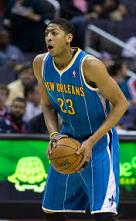
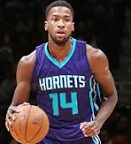
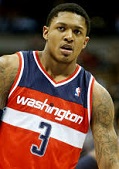
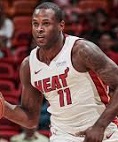
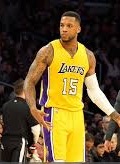

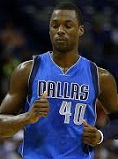
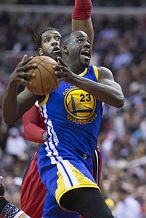
On June 28, 2012 the 2012 NBA Draft sees 30 teams select 60 players in two rounds at Prudential Center in Newark, N.J.; first time that the first two players come from the same school (U. of Ky.); first with six players from one school (U. of Ky.); first with the first selections being freshmen from the same conference (Southeastern Conference); first appearance of the Brooklyn Nets, and last for the New Orleans Hornets, who become the New Orleans Pelicans; 6'9" power forward-center Anthony Marshon Davis Jr. (1993-) of the U. of Ky. (freshman) (7'5" wingspan) is selected #1 by the New Orleans Hornets (#23), going on to become NBA All-Star Game MVP in 2017; 6'7" forward Michael Anthony Edward Kidd-Gilchrist (1993-) of the U. of Ky. (freshman) is selected #2 by the Charlotte Bobcats (#14); 6'5" shooting guard Bradley Emmanuel Beal (1993-) of the U. of Fla. (freshman) is selected #3 by the Washington Wizards (#3); 6'4" shooting guard Dion Waiters (1991-) of the U. of Syracuse (sophomore) is selected #4 by the Cleveland Cavaliers (#3), who trade him in 2015 to the Okla. City Thunder, who trade him in 2016 to the Miami Heat (#23); 6'10" power forward Thomas Earl Robinson (1991-) of the U. of Kansas (junior) is selected #5 by the Sacramento Kings, going to to be traded to the Houston Rockets in 2013, the Portland Trail Blazers in 2013, the Philadelphia 76ers in 2015, the Brooklyn Nets in 2015, and the Los Angeles Lakers in 2016-7; 6'3" point guard Damian Lamont Ollie Lillard Sr. (1990-) of Weber State U. is selected #6 by the Portland Trail Blazers (#0); 6'8" small/power forward Harrison Bryce Jordan Barnes (1992-) of the U. of N.C. (sophomore) is selected #7 by the Golden State Warriors, who trade him in 2016 to the Dallas Mavericks (#40); 6'7" power forward Draymond Jamal Green Sr. (1990-) is selected #35 (round 2) by the Golden State Warriors (#23), going on to help them win the 2015 NBA Finals.

On Sept. 21, 2012 $1B Barclays Center multipurpose indoor arena in Brooklyn, N.Y. opens as the home of the NBA Brooklyn Nets and NHL New York Islanders.
On June 6-20, 2013 the 2013 NBA Finals sees the Miami Heat defeat the San Antonio Spurs by 4-3; MVP is LeBron James of Miami.
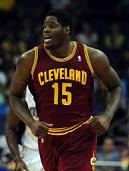
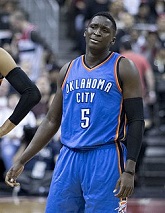
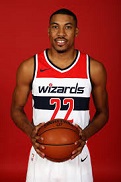

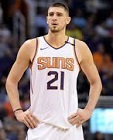
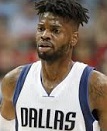
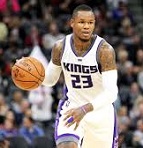
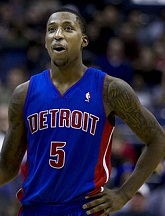

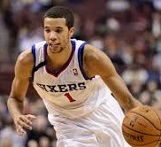
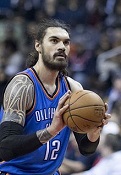

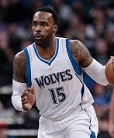
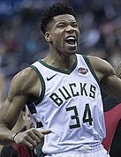
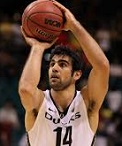
On June 27, 2013 the 2013 NBA Draft sees 30 teams select 60 players in two rounds at Barclays Center in Brooklyn, N.Y.; last draft for the Charlotte Bobcats, who become the Charlotte Hornets; Canadian-born (first-ever #1 pick) 6'8" forward Anthony Harris Bennett (1993-) of UNLV (#15) (freshman) is selected #1 by the Cleveland Cavaliers (#15), moving to the Minnesota Timberwolves (#24) in 2014-; 6'4" guard Kehinde Babatunde Victor Oladipo (1992-) of the U. of Indiana (junior) is selected #2 by the Orlando Magic (#5), moving to the Okla. City Thunder in 2016, and the Ind. Pacers in 2017; 6'8" small forward Otto Porter Jr. (1993-) of Georgetown U. (sophomore) is selected #3 by the Washington Wizards (#22); 7'0" forward-center Cody Allen Zeller (1992-) of the U. of Indiana (sophomore) is selected #4 by the Charlotte Bobcats (#40); 7'1" Ukrainian-born center Oleksiy "Alex" Len (1993-) of the U. of Md. (sophomore) is selected #5 by the Phoenix Suns (#21); 6'11" center-forward Nerlens Noel (1994-) of the U. of Ky. (freshman) is selected #6 by the New Orleans Pelicans, who trade him to the Philadelphia 76ers, moving to the Dallas Mavericks in 2017 (#3); 6'5" shooting guard Ben Edward McLemore III (1993-) of the U. of Kan. (freshman) is selected #7 by the Sacramento Kings (#16, #23), moving to the Memphis Grizzlies (#23) in 2017; 6'5" shooting guard Kentavious Tannell Caldwell-Pope (1993-) of the U. of Ga. (sophomore) is selected #8 by the Detroit Pistons (#5), moving to the Los Angeles Lakers (#1) in 2017; 6'1" point guard Alfonso Clark "Trey" Burke III (1992-) of the U. of Mich. (sophomore) is selected #9 by the Minnesota Timberwolves, who trade him to the Utah Jazz (#3), ending up playing for the New York Knicks (#23) in 2018 (until ?); 6'6" point guard Michael Carter-Williams (1991-) of Syracuse U. (sophomore) is selected #11 by the Philadelphia 76ers; 7'0" Kiwi-born (first-ever in first round) center Steven Funaki "Steve" Adams (1993-) of the U. of Pittsburgh (freshman) is selected #12 by the Oklahoma City Thunder; 7'0" Canadian-born center Kelly Tyler Olynyk (1991-) of Gonzaga U.(junior) is selected #13 by the Dallas Mavericks, who trade him to the Boston Celtics (#33), who trade him to the Miami Heat (#9) in 2017 (until ?); 6'6" shooting guard Shabazz Nagee Muhammad (1992-) of UCLA (freshman) is selected #14 by the Utah Jazz, who trade him to the Minnesota Timberwolves, ending up playing for the Milwaukee Bucks (#15) in 2018 (until ?); 6'11' Nigerian-descent Giannis Antetokounmpo (1994-) (pr. "adetokumbo") of Filathlitikos in Greece is selected #15 by the Milwaukee Bucks (#34), going on to become their star, known as "the Greek Freak"; 6'8" Iranian-born (first-ever) power forward Arsalan Kazemi Naeini (1990-) of the U. of Oregon is selected #54 by the Washington Wizards, who trade him to the Philadelphia 76ers, who play him in the NBA Summer League in 2013-5 before being dumped by the 76ers, Atlanta Hawks, and Houston Rocks and returning to Iran.
In 2013 the first NBA Twyman-Stokes Teammate of the Year Award, named after Rochester/Cincinnati Royals teammates (1955-8) Jack Twyman and Maurice Stokes is awarded to Chauncey Billups of the Los Angeles Clippers for the 2012-13 season, followed in 2013-4 by Shane Battier of the Miami Heat.

On Apr. 29, 2014 after recorded racist comments are released by his ex-girlfriend V. Stiviano, Los Angeles Clippers owner Donald T. Sterling (Tokowitz) (1934-) is banned from the NBA for life and fined $2.5M by the NBA; on May 22 citing the quick action by the NBA on Sterling, 49 U.S. Dem. Senators send a letter to NFL commissioner Roger Gooddell to change the Washington Redskins' name, calling it a racist slur; on May 30 Microsoft's Steve Balmer buys the Clippers for a record $2B.

On June 5-15, 2014 the 2014 NBA Finals sees the San Antonio Spurs defeat the Miami Heat by 4-1, after which LeBron James returns to the Cleveland Cavaliers; MVP is small forward Kawhi Anthony "the Klaw" Leonard (1991-) (#2) of the Spurs.









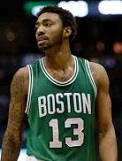
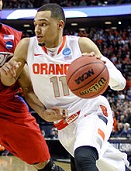
On June 26, 2014 the 2014 NBA Draft sees 30 teams select 60 players in two rounds at Barclays Center in Brooklyn, N.Y.; the draft incl. the first Canadian #1 overall pick, first pair of Canadian top-10 picks, three top-20 Canadian picks, first NBA-D League player to be selected in round 1, and first time that multiple NBA-D League players are selected in the same draft; 6'8" Canadian-born guard-forward Andrew Christian Wiggins (1995-) of the U. of Kansas (freshman) is selected #1 by the Cleveland Cavaliers (2nd Canadian #1 pick), who trade him 2 mo. later to the Minnesota Timberwolves for Kevin Love, becoming the first #1 overall pick who doesn't play a game for the team that drafted him; 6'8" forward Jabari Ali Parker (1995-) of Duke U. (freshman) (son of Sonny Parker) is selected #2 by the Milwaukee Bucks (#12); 7'0" Yaounde, Cameroon-born center Joel Hans Embiid (1994-) of the U. of Kansas (freshman) is selected #3 by the Philadelphia 76ers (#21); 6'9" forward Julius Deion Randle (1994-) of the U. of Ky. (freshman) is selected #7 by the Los Angeles Lakers (#30); 6'6" Canadian-born guard Nikolas Tomas "Nik" Stauskas (1993-) of the U. of Mich. (sophomore) is selected #8 by the Sacramento Kings (#10); 6'10" forward Noah Vonleh (1995-) of the U. of Ind. (freshman) is selected #9 by the Charlotte Hornets (#11); 6'10" Croatian-born forward Dario Saric (1994-) of Cibona Zagreb in Croatia is selected #12 by the Orlando Magic, who trade him to the Philadelphia 76ers in exchange for Elfrid Payton, after which he decides to play in Europe another year; 6'5" Renton, Wash.-born guard Zachary "Zach" LaVine (1995-) of UCLA (freshman) is selected #13 by the Minnesota Timberwolves (#8), going on to win the NBA Slam Dunk Contest as a rookie; promising 7'1" Fresno, Calif.-born center Isaiah Charles Austin (1993-) of Baylor U. (#21), who was diagnosed with Marfan Syndrome one week before the draft is ceremonially picked between the 15th and 16th picks; 6'6" guard-forward James Young (1995-) of the U. of Ky. (freshman) is selected #17 by the Boston Celtics, moving to the Wisc. Herd in 2017, and the Philadelphia 76ers (#8) in 2018; Canadian-born 6'3" point guard Tyler Cameron Ennis McIntyre (1994-) of Syracuse U. (freshman) is selected #18 by the Phoenix Suns, moving to the Milwaukee Bucks in 2015, the Houston Rockets in 2016, and the Los Angeles Laker (#18) in 2017.

On Feb. 4, 2015 Pres. Obama holds a closed meeting with 14 Am. Muslim leaders at the White House, incl. Mohamed Magid, Farhana Khera, Farhan Latif, Hoda Elshishtawy, and female Muslim basketball star Bilqis "Qisi" Abdul-Qaadir (1990-) of Indiana State U. (first player in NCAA history to play in a hijab in 2009) to provide them with more Muslim outreach programs; they ask him to appoint the first Muslim federal judge; the infamous CAIR (Council on American-Islamic Relations) is not invited.


On June 4-16, 2015 the 2015 NBA Finals see the Golden State Warriors (coach Steve Kerr), led by 2014-15 NBA MVP Wardell Stephen "Steph" Curry II (1988-) (#30) defeat the Cleveland Cavaliers (coach David Blatt), led by 4x NBA MVP LeBron James by 4-2, becoming their first title in 40 years (1975) and 4th ever, becoming the first time since the 1990-1 Chicago Bulls for a team having no players with finals experience to win the finals; the Cavaliers haven't won since 1971; first finals with two first-year head coaches; James becomes the first NBA player since the Boston Celtics in the 1960s to make five consecutive finals appearances; MVP is Warriors small forward-guard (#9) Andrew Tyler Iguodala (1984-).

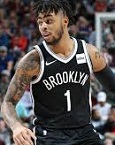
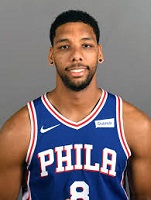

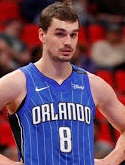
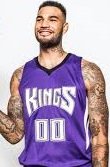

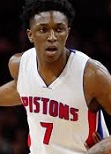
On June 25, 2015 the 2015 NBA Draft at Barclays Center in Brooklyn, N.Y. sees 30 teams select 60 players in two rounds; 6'11" center-forward Karl-Anthony Towns Jr. (1995-) of the U. of Ky. (freshman) is selected #1 by the Minn. Timberwolves (first Dominican); 6'5" point guard D'Angelo Dante (Danté) Russell (1996-) of Ohio State U. (freshman) is selected #2 by the Los Angeles Lakers (#1), moving to the Brooklyn Nets (#1) in 2017; 6'11 center Jahlil Okafor (1995-) of Duke U. (freshman) is selected #3 by the Philadelphia 76ers (#8), moving to the Brooklyn Nets (#4) in 2017; 7'3" center-forward Kristaps Porzingis (1995-) from Latvia is drafted #4 by the New York Knicks (#6) (2nd Latvian drafted in round 1); 6'8 Croatian-born shooting guard/small forward Mario Hezonja (1995-) is selected #5 by the Orlando Magic (#8); 7'0" center Willie Cauley-Stein (Willie Durmond Cauley Jr.) (1993-) of the U. of Ky. is selected #6 by the Sacramento Kings (#00); 6'5" Kinshasa, Zaire-born point guard Emmanuel Kabeya Mudiay (1996-) is selected #7 by the Denver Nuggets (#0), who trade him in 2018 to the New York Knicks (#1); 6'7" small forward Stanley Herbert Johnson Jr. (1996-) of the U. of Ariz. (freshman) is selected #8 by the Detroit Pisons (#7).
On Apr. 4, 2016 the 2016 NCAA Men's Div. I Basketball Championship Game sees the 34-5 Villanova Wildcats defeat the 33-6 North Carolina Tar Heels by 77-74 after short black guy Marcus Taylor Paige (1993-) of N.C. sinks two 3-pointers to tie with 4.7 sec. remaining, and short white guy Ryan Arcidiacono (1994-) draws the Tar Heels defenders after him while setting up big black guy Kris Jenkins (1993-), who sinks the winning 3-pointer at the buzzer (the Nova play), becoming Villanova's first nat. championship since 1985; former N.C. star Michael Jordan is in the audience.
On June 2-19, 2016 the 2016 NBA Finals see the Cleveland Cavaliers (coah Tyuronn Lue) defeat the favored Cleveland Cavaliers (soach Steve Kerr) by 4-3 after starting out in a 3-1 hole; LeBron James of Cleveland is MVP.
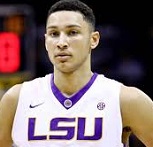

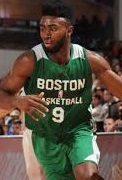
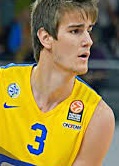
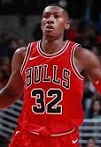


On June 23, 2016 the 2016 NBA Draft at Barclays Center in Brooklyn, N.Y. sees 30 teams select 60 players in two rounds; 6'10" forward Benjamin "Ben" Simmons (1996-) of LSU is selected #1 by the Philadelphia 76ers (#25); 6'9" small foward Brandon Ingram (1997-) (sophomore) of Duke U. is drafted #2 by the Los Angeles Lakers (#14); 6'7" small forward Jaylen Brown (1996-) (sophomore) of the U. of Calif. is drafted #3 by the Boston Celtics (#7); 7'1" forward-center Dragan Bender (1997-) of Croatia is drafted #4 by the Phoenix Suns (#35); 6'4" point guard Kristofer Michael "Kris" Dunn (1994-) of the U. of Providence is selected #5 by the Minn. Timberwolves before being traded in 2017 to the Chicago Bulls (#32) along with Zach LaVine and Lauri Markkanen in exchange for Jimmy Butler and Juston Paton; after being named Big 12 Conference Men's Basketball Player of the Year in 2015 and 2016, and receiving the John R. Wooden Awad, the Naismith Award, and Oscar Robertson Trophy, and the Sporting News Player of the Year award in 206, 6'4" Freeport, Bahamas-born Chavano Rainier "Buddy" Hield (1993-) of the U. of Okla. is selected #6 by the New Orleans Pelicans, who trade him in 2017 to the New Orleans Pelicans (#24); 6'4" Kitchener, Ont., Canada-born point guar Jamal Murray (1997-) of the U. of Ky. (freshman) is selected #7 by the Denver Nuggets (#27), going on to score 38 points on Jan. 22, 2018 against the Portland Trail Blazers in a 104-101 win.
On June 1-12, 2017 the 2017 NBA Finals sees the Golden State Warriors (67-15) (coach Steve Kerr) defeat the Cleveland Cavaliers (51-31) (coach Mike Brown) 4-1, becoming the first time that two NBA teams meet in the finals for a 3rd straight years; LeBron James scores a record 5,995th playoff point, beating Michael Jordan's record of 5,987; MVP is Kevin Durant of the Warriors, who end up with a 16-1 record, becoming the highest winning percentage so far in NBA history (.941).
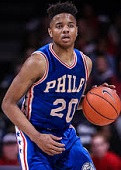

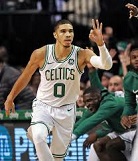

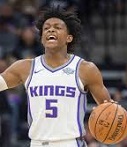
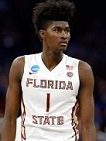
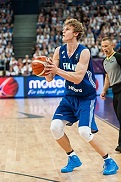
On June 22, 2017 the 2017 NBA Draft at Barclays Center in Brooklyn, N.Y. sees 30 teams select 60 players in two rounds; 6'4" point guard Markelle V. Fultz (1998-) of the U. of Wash. (freshman) is selected #1 by the Philadelphia 76ers (#20); 6'6" Lonzo Anderson Ball (1997-) (freshman) of UCLA is drafted #2 by the Los Angeles Lakers (#2); in May his father LaVar Ball announced the release of the ZO2 basketball shoe; 6'8" small forward Jayson Christopher Tatum (1998-) (freshman) of Duke U. is drafted #3 by the Boston Celtics (#0), who won the #1 pick via a trade with the Brooklyn Nets, and traded it on June 19 with the 76ers, making the holders of the top four picks the same as last year; 6'8" forward/guard Joshua O'Neal "Josh" Jackson (1997-) (freshman) of the U. of Kan. is drafted #4 by the Phoenix Suns (#20); 6'3" point guard De'Aaron Fox (1997-) of the U. of Ky. (freshman) is selected #5 by the Sacramento Kings (#5); 6'10" small forward Jonathan Judah Isaac (1997-) of Fla. State U. (freshman) is selected #6 by the Orlando Magic (#1); Finnish-born accurate-shooting 7'0" power forward Lauri Elias Markkanen (1997-) of the U. of Ariz. (freshman) is selected #7 by the Minn. Timberwolves, who trade him in exchange for Jimmy Butler to the Chicago Bulls (#24); the top seven picks are all freshmen, becoming the youngest draft class ever, with the most freshmen and least seniors (until ?).
On May 31-June 6, 2018 the 2018 NBA Finals sees the 58-24 Golden State Warriors sweep the 50-32 Cleveland Cavaliers 4-0 for their 2nd straight title and 3rd in four years; MVP is Kevin Durant of the Warriors (2nd straight time); the first finals sweep since 2007; the first time in any North Am. major prof. sports championship that the same two teams meet for four years in a row; the first time since 2012 that the finals don't feature a top seed; in Game 2 Stephen Currey of the Warrios makes a record 9 3-pointers; in Game 3 Kevin Durant of the Warriors scores a playoff career-high 43 points incl. a 3-pointer late in the game that ices the victory; in Game 4 Golden State surges ahead 102-77 with 4:03 remaining after LeBron James of the Cavaliers leaves the game, then finishes 108-85; the official sponsor is YouTube TV.
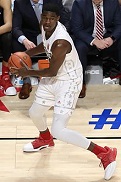
On June 21, 2018 the 2018 NBA Draft at Barclays Center in Brooklyn, N.Y. sees 60 players selected in two rounds; 7'1" Bahamian-born center Deandre Edoneille Ayton (1998-) (sophomore) of the U. of Ariz. is selected #1 by the Phoenix Suns (#22).
On Feb. 20, 2019 star Duke U. basketball player Zion Williamson experiences a blowout of his Paul George 2.5 model Nike shoe less than 1 min. into a game against archrival U. of N.C.; he returns on Mar. 15 in a modified Kyrie Irving 4 model.
On May 30-June 13, 2019 the 2019 NBA Finals (first with games played outside the U.S.) sees the world turned upside down as the 58-24 Toronto Raptors (coach Nick Nurse) defeat the 57-25 Golden State Warriors (coach Steve Kerr) 4-2, meaning that basketball is no longer America's sole possession?; MVP is Kawhi Leonard of the Raptors.
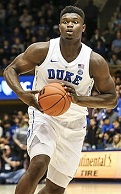
On June 20, 2019 the 2019 NBA Draft at Barclays Center in Brooklyn, N.Y. is the first with a weighted lottery, held on May 14, where the three worst teams each have a 14% chance of winning; 60 players are selected in two rounds; 6'7" power forward Zion Lateef Williamson (2000-) of Duke U. (freshman) is selected #1 by the New Orleans Pelicans (#1).
On Mar. 11, 2020 the NBA announces the suspension of the 2019-2020 season due to a report that Utah Jazz center Rudy Gobert tested positive for COVID-19; on June 14 the NBA announces the resumption of the season inside a sealed Walt Disney World near Orlando, Fla., with a special game schedule of eight regular season games.
On Sept. 30-Oct. 11, 2020 the 2020 NBA Finals sees the Los Angeles Lakers (coach Frank Vogel) defeat the Miami Heat (coach Erik Spoelstra) 4-2, becoming their first title since 2010, tying the Boston Celts for most in NBA history (17); MVP is LeBron James of the Lakers (4th time); the Golden State Warriors don't make the finals for the first time in six years.
The 13 NBA teams that still haven't won a championship incl. the Indiana Pacers, Charlotte Hornets, Orlando Magic, Okla. City Thunder, Brooklyn Nets, Memphis Grizzlies, Phoenix Suns, Utah Jazz, New Orleans Pelicans, Los Angeles Clippers, Denver Nuggets, Minn. Timberwolves, and Toronto Raptors.